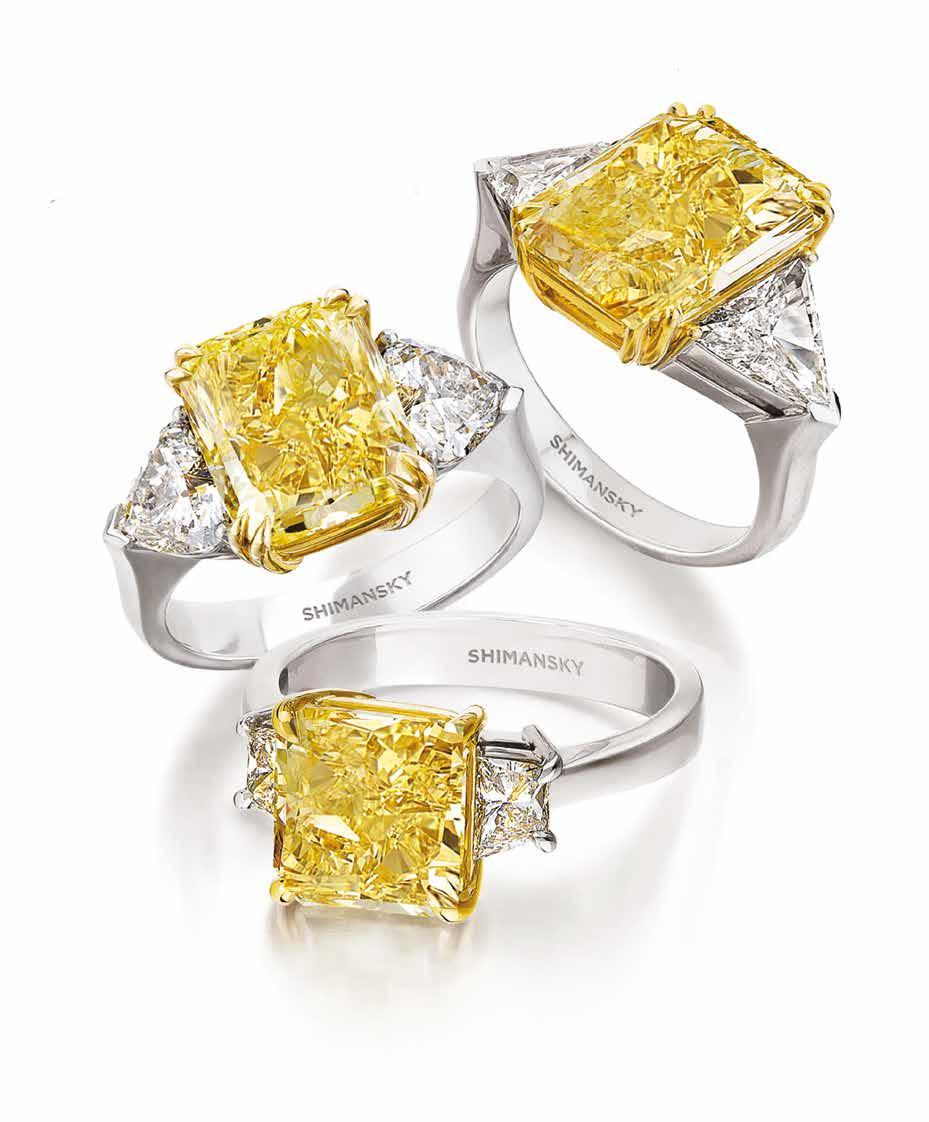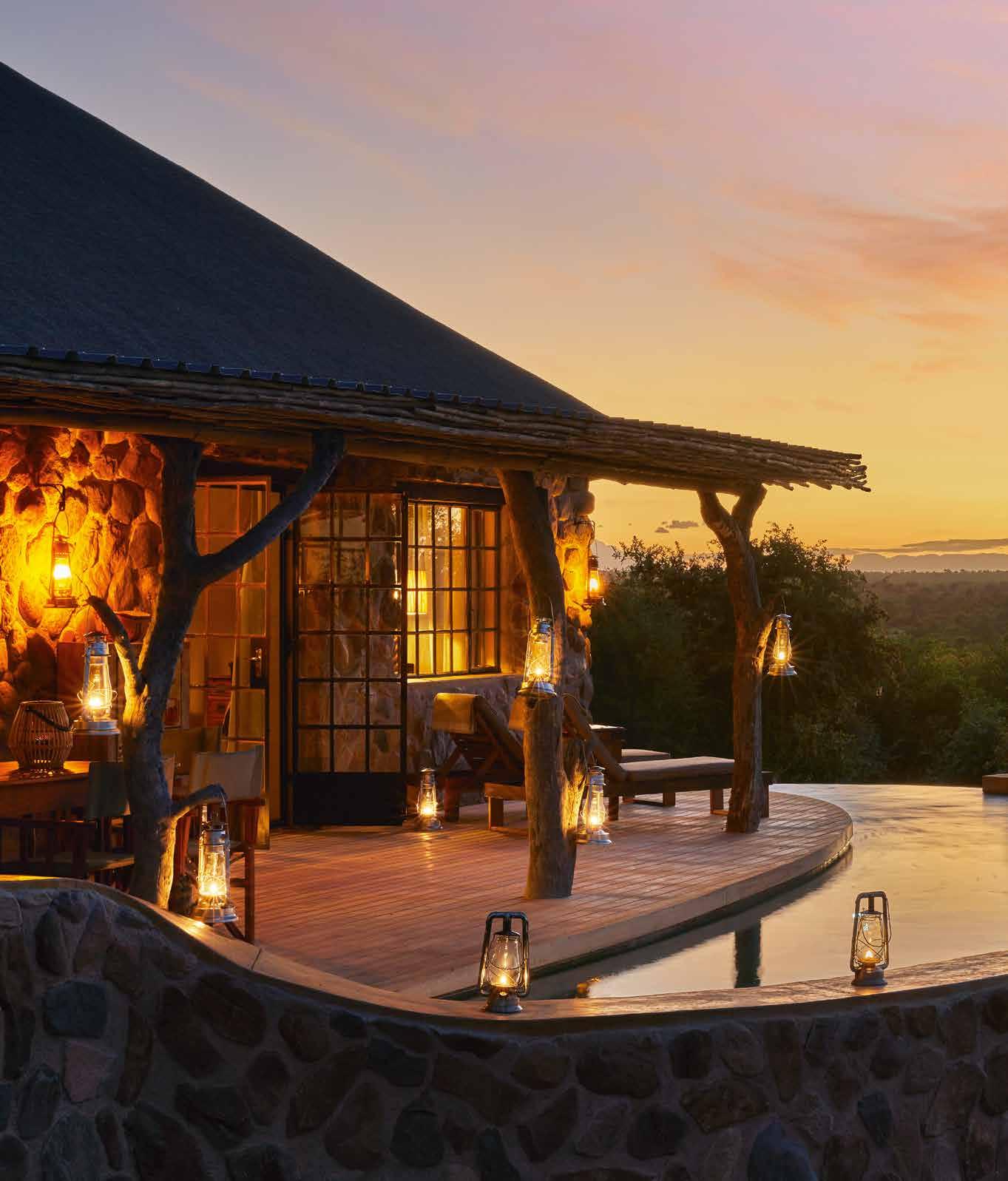

Wild Elegance

Modjadji Master Suite at Geiger’s Camp, Motswari Private Game Reserve.



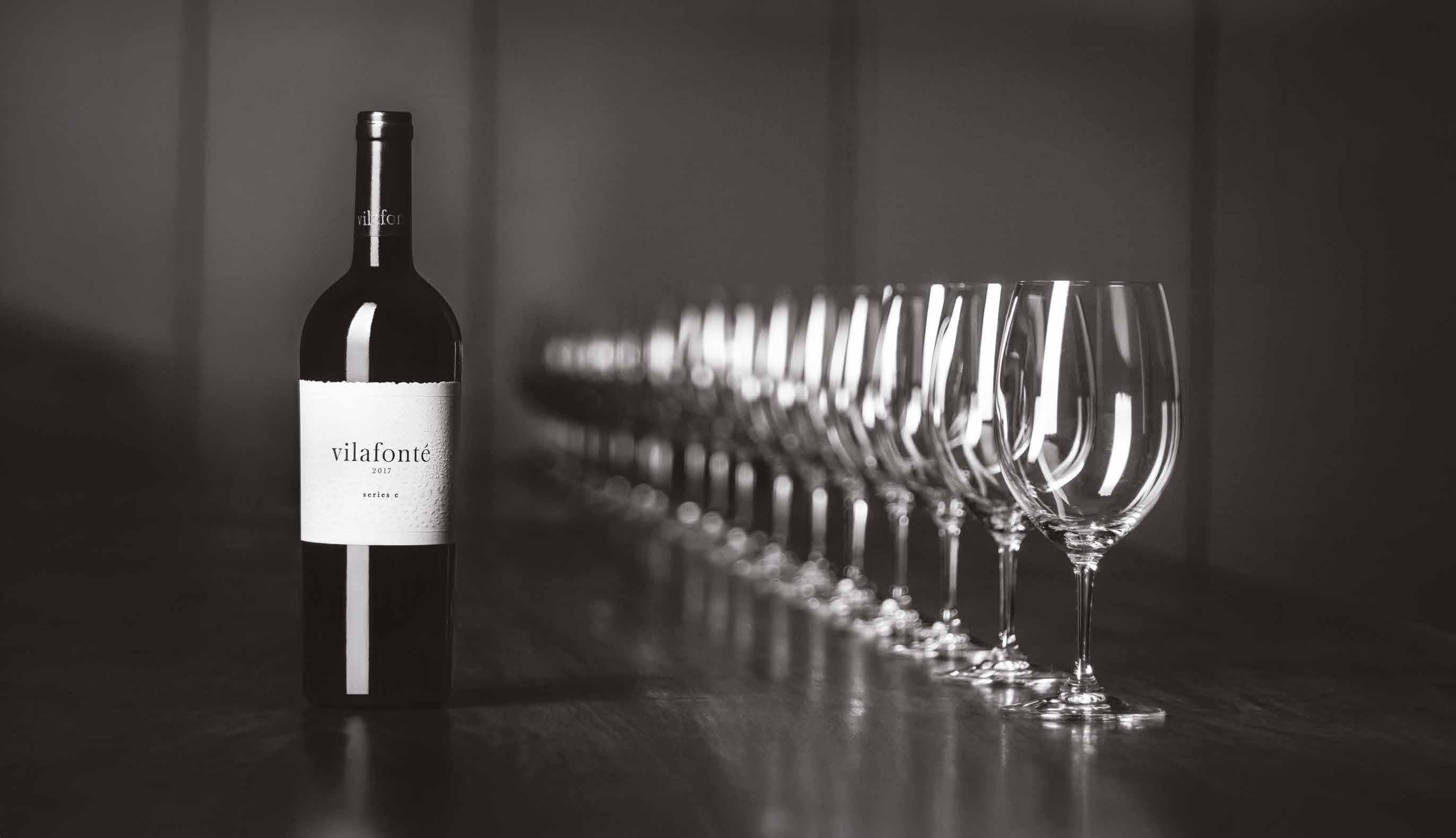

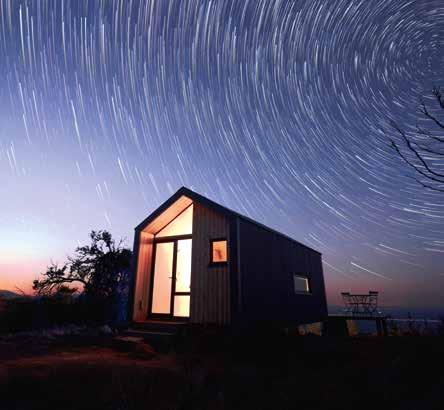
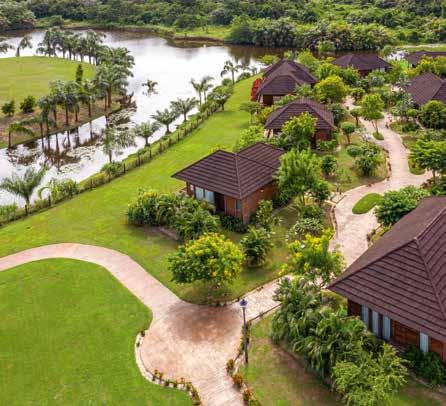
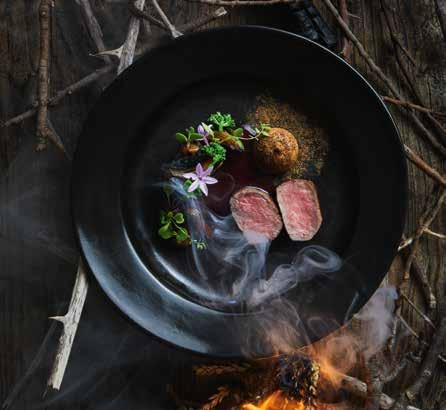
Neil
Escape the bright lights of the city for awe-inspiring stargazing and a healthy dose of perspective at Mount Camdeboo Private Game Reserve and QWABI Private Game Reserve
Rekindle
Cape
on
Cape Town guesthouse The Lenox is quietly transforming –not into something new, but into what it was always meant to be.
24 A STORY IN STONE AND THATCH
Exclusive, secluded and luxurious – the newly launched Modjadji Master Suite is an exciting addition to Geiger’s Camp at Motswari Private Game Reserve
28
Explore the world beneath the waves at La Maison D’Été on the tropical island of Mauritius.
30
A stylish collection of the best local gifts and travel essentials.
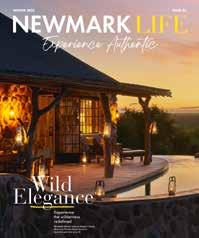
Explore the luxurious Modjadji Master Suite at Geiger’s Camp at Motswari Private Game Reserve.
Cover photo: Micky Hoyle ON THE COVER





































































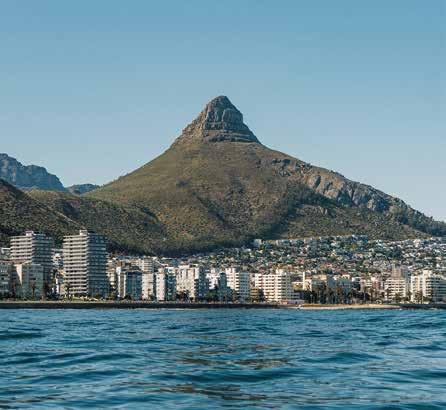
COASTAL
Enjoy the splendour of Africa’s most luxurious seaside destinations.
32 A PERFECT PRESENT
Below the forested slopes of Table Mountain’s hidden corner lies Future Found Sanctuary – a retreat like no other.
38 FOLLOW THE SUN Visit Chuini Zanzibar Beach Lodge this winter for a sun-soaked escape.
42 LAID-BACK FINE DINING AT TERRARIUM
Newmark Hotels & Reserves Group Head Chef Chris Erasmus shares the vision behind relaxed V&A Waterfront restaurant Terrarium
48 A POSTCARD PARADISE
A stay at Mystik Lifestyle Boutique Hotel is balm for the soul.
50 FROM DAWN TO DUSKIES
La Splendida is a Cape Town stay where the wild ocean meets the city.
54 OBJECTS OF DESIRE
A stylish collection of the best local gifts and travel essentials.
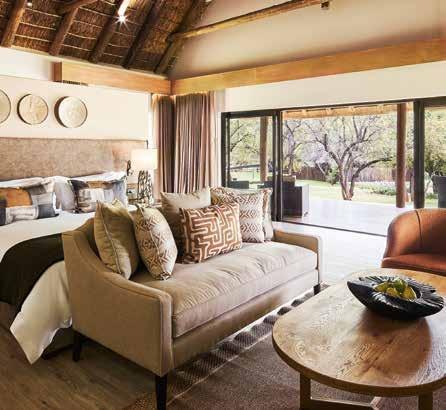
EXPLORER
Discover new paths through the heart of Africa and its unforgettable destinations.
56 WINTER IS WILD IN THE BUSH
Enjoy a contemporary adventure in an ancient landscape at Nkomazi Private Game Reserve
62 THE MEDITATIVE POWER OF WALKING
At Motswari African Retreat & Walking Safaris, the bush is transformed into a place of introspection and contemplation.
66 TRACKS, TALES AND FAMILY TIES IN THE WATERBERG
LETAMO at QWABI Private Game Reserve is reimagining the bush as a place not just for game viewing, but for shaping young minds and rekindling family bonds.
70 THE QUIET LANGUAGE OF SCENT
On a dirt road to BABOHI at QWABI Private Game Reserve, Ryan Enslin stumbles into something unexpected – a journey guided not by maps, but by fragrance.
74 A NEW LANDMARK LODGE LAUNCHES IN ZIMBABWE
Clinging to the cliffs above the Zambezi, Bupenyu Lodge blends dramatic design with soulful stillness.
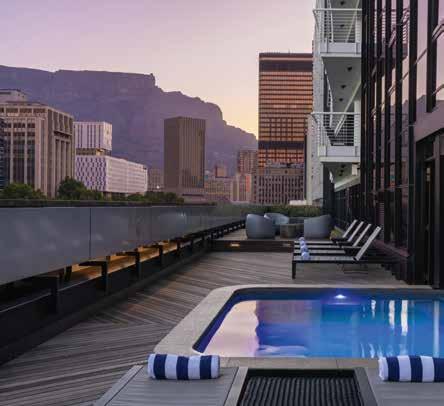
PORTFOLIO
The insider’s guide to discovering the secrets of Africa’s hottest cities.
78 MAKE SUNDAYS COUNT
Here’s where you’ll find the best brunches around town.
82 WELLNESS BY THE SEA Revitalise your mind and body at The Winchester Hotel on Cape Town’s Atlantic Seaboard.
84 THE NEW NOMAD
South Africa’s hybrid hotels are calling the world’s remote workers.
90 BIG CITY LIGHTS
Whether you’re travelling for business or just looking for a more homely stay, The Onyx Hotel gives you the convenience of a hotel with the comfort of home.
92 URBAN ENERGY
For those who enjoy being where the action is, The Rockefeller Hotel & Residences is where luxury lives large.
94 WHERE SANDTON UNWINDS
Escape the bustle of the city with rejuvenating moments at The Catalyst
96 THE ART OF THE SUNDOWNER
Welcome to a local tradition. Here’s where to sip and watch the sunset in style.
98 ROOM WITH A VIEW
The Deluxe Suite at Gorilla Heights Lodge offers more than simply a spot to rest your head – it’s a sanctuary where you can be still.

LETTER FROM THE CEO

Awarm welcome to the winter issue of Newmark Life!
Winter is by no means a quieter season as you’ll discover from this jam-packed mid-year issue.
For many of our game reserves, this is the high season, as it offers the best visibility as animals congregate around water sources due to limited water availability. This makes them even easier to spot in the thinned out vegetation.
On page 24, our cover story reveals the newly launched Modjadji Master Suite, an exciting addition to Geiger’s Camp at Motswari Private Game Reserve. Originally the family home of owner Marion Geiger, it carries a sense of warmth and familiarity, which will no doubt be in demand year-round!
In South Africa’s eastern province of Mpumalanga at Nkomazi Private Game Reserve, winter is both the dry season and a time of stark beauty and striking clarity: “You can see the animals more easily, and the plains take on this beautiful, flowing look when the wind moves through the golden grasses,” says writer Richard Holmes on page 56.
NEIL MARKOVITZ Chief Executive Officer at Newmark Hotels & Reserves
Looking further north, we’re thrilled to announce the addition of the luxurious Bupenyu Lodge. Perched on the cliffs on the Zimbabwean side of the Zambezi River, it has breathtaking views over the worldrenowned Batoka Gorge. Located just 45 minutes from Victoria Falls International Airport, it’s bound to be on every traveller’s radar this spring.
And of course, as many locals know, this is also the perfect time to escape the city for the warmth of the islands and the clear waters of the beach resorts – from the wild coastline of Zanzibar to the quiet charm of Mauritius.
If you’re looking to explore closer to home, in this issue you’ll discover secret wanders through the winelands (p.32), how the new digital nomads are finding a base in our cities (p.84), kayaking with dolphins in the Cape (p.50) and how one restaurant – Terrarium at the Queen Victoria Hotel – is defining our approach to food within the entire Newmark group (p.42).
Whatever destination you choose, we trust you’ll enjoy your stay with us.
DISCOVER TRUE AFRICAN TREASURE
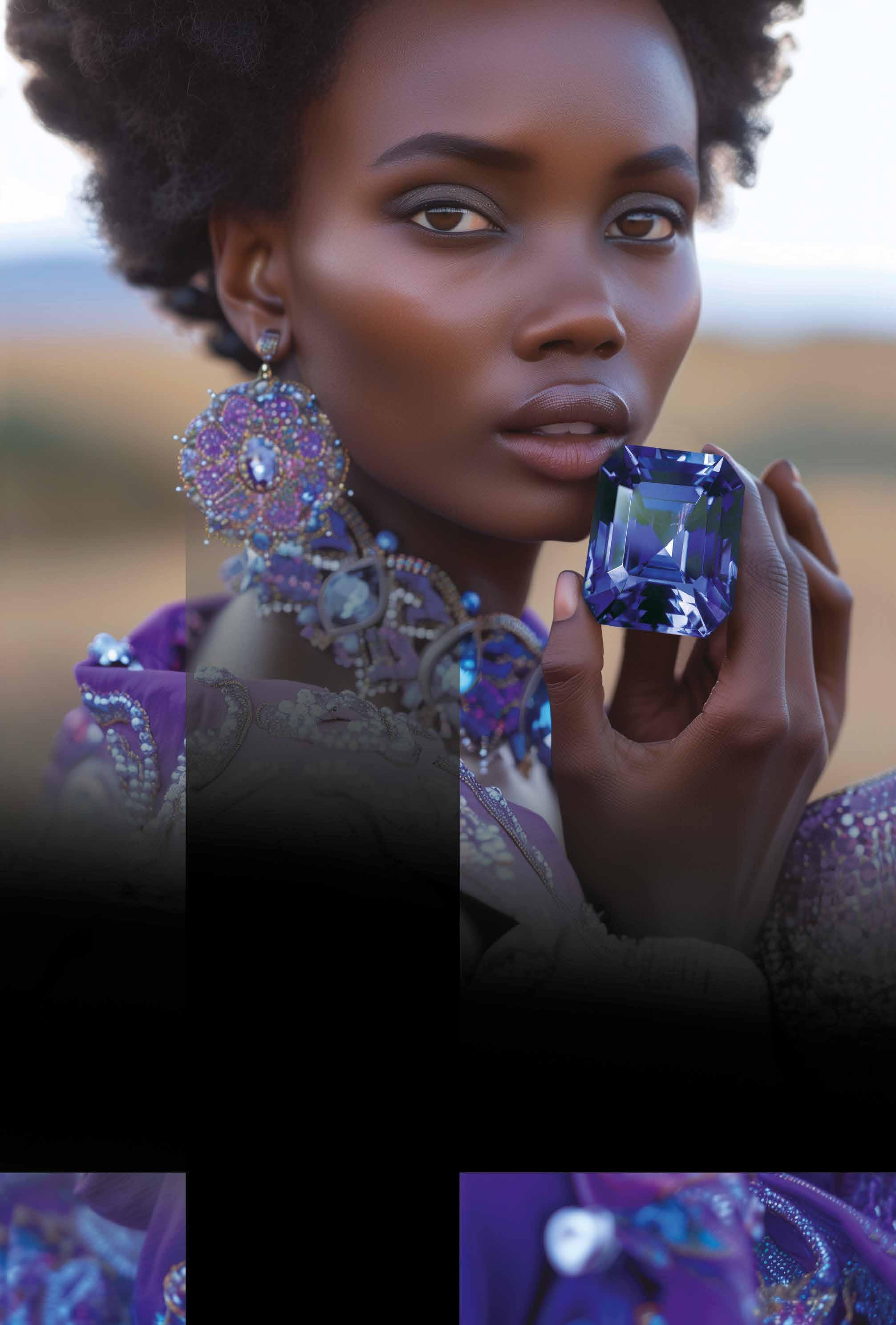
A gem so rare it is limited to a single generation.
The geological discovery of tanzanite has been described as a geological phenomenon, giving rise to tanzanite’s unparalleled scarcity. In appreciation of this captivating gem, The Diamond Works tells the historic tale of tanzanite, showcasing a firsthand cutting and polishing demonstration and wide range of the most elegant tanzanite jewellery pieces – offering the opportunity to take home the Essence of Africa.


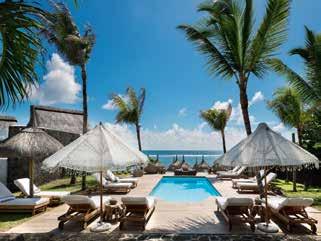
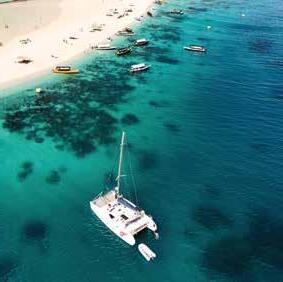
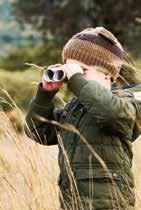

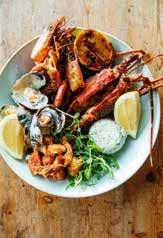
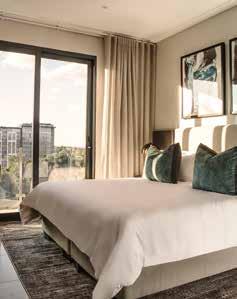
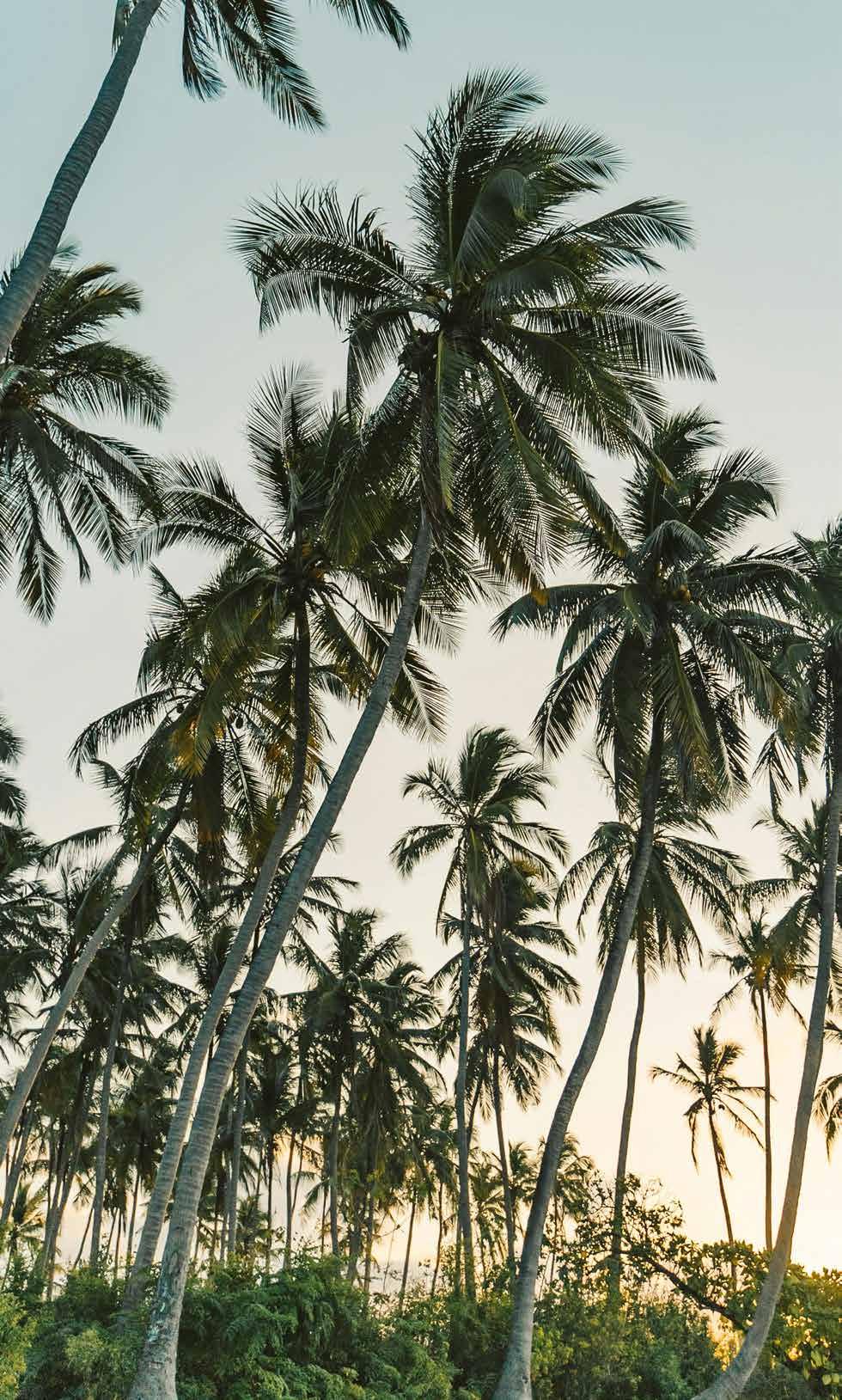
NEWMARK HOTELS & RESERVES
CEO Neil Markovitz
Global Chief
Financial Officer Garth Musikanth
Director of Group Operations & Business Systems Reinard Korf
Group Director of Marketing Keaton Quarmby
Newmark Life is published twice annually by Photodeli Custom Media Solutions on behalf of Newmark Hotels & Reserves. Merchant House, 19 Dock Road, Victoria & Alfred Waterfront, Cape Town, 8001
For media enquiries, please contact cara@newmarkhotels.com
To book any of the hotels & reserves featured in Newmark Life, please contact 021 427 5901, email reservations@ newmarkhotels.com or visit our website www.newmarkhotels.com.

PUBLISHING TEAM
Publisher &
Commercial Sales: Marc Blachowitz
marc@photodeli.co.za +27 82 990 1926
Editor
Jason Brown
Art Director
Michelle von Schlicht
Contributors
Pippa de Bruyn, Roger de la Harpe, Ryan Enslin, Sean Gibson, Claire Gunn, Richard, Holmes, Michael Hoyle, Patrick King, Wanita Nicol, Edwina Robertson, Lisa Skinner, Andrew Thompson, Nick van der Touw, Hein van Tonder, Dook Photography
Printers
Shirley Bosman at SAGPrint shirley@sagprint.co.za

JOURNAL
NEWS, VIEWS, TRENDS & SPENDS
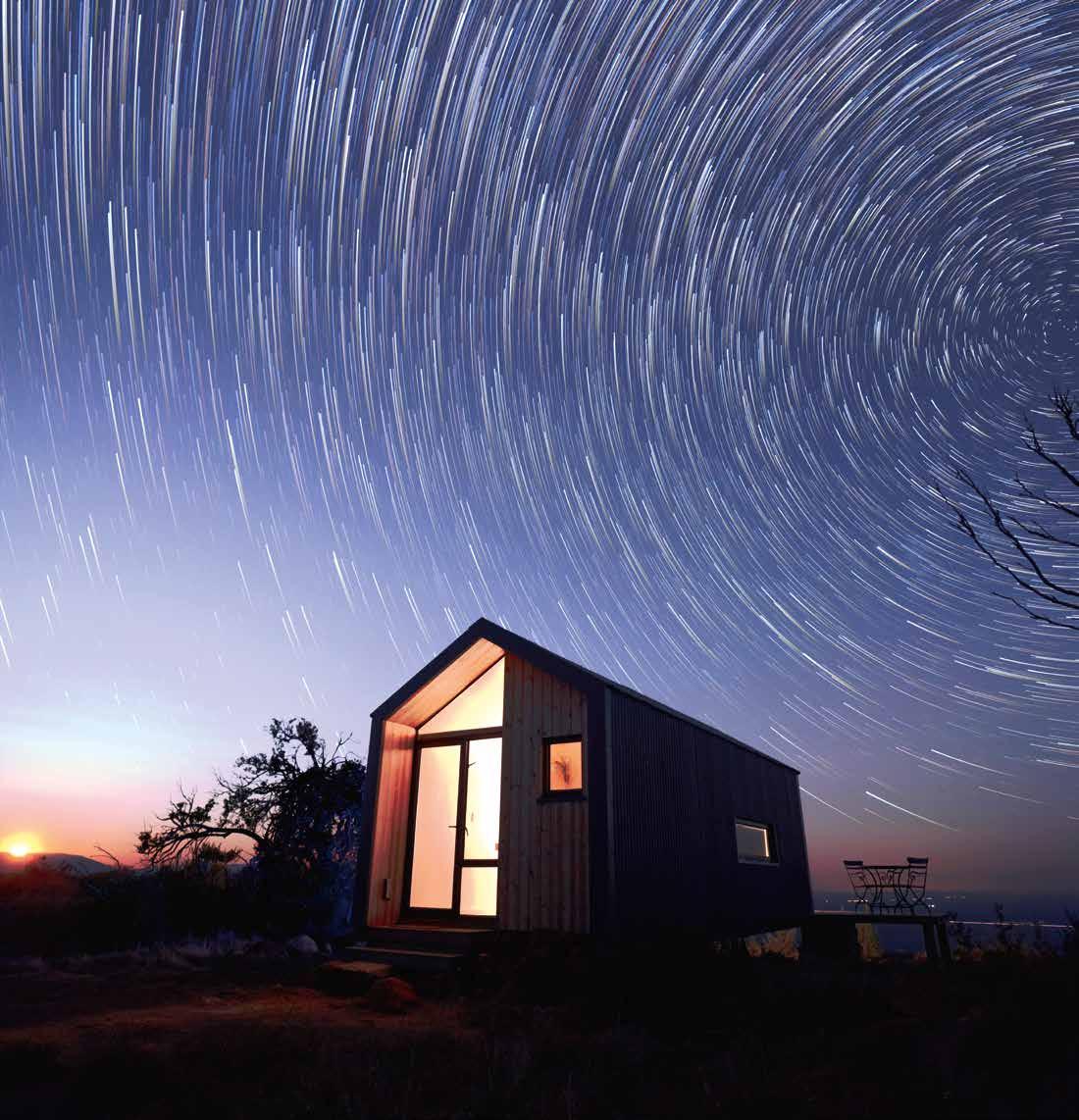
The night sky above Mount Camdeboo Private Game Reserve, in the sparsely inhabited expanse of the Great Karoo, offers some of the best stargazing South Africa has to offer.
CHASING THE STARS
Escape the bright lights of the city for awe-inspiring stargazing and a healthy dose of perspective
BY WANITA NICOL
There is a story in Africa about a girl who took wood ashes from the fire and threw them up into the sky. Those embers, gently glowing, became the Milky Way. And the earth, which by night had always been dark, now had a little light – just enough that people travelling outside of camp might find their way home. That same girl threw pieces of an edible root into the sky, where they hung and became the stars.
These tales form part of the ancient mythology of the hunter-gatherers who once roamed the semi-arid land in Southern Africa. Preserved in oral tradition, they were passed down through generations of storytellers until linguist Wilhelm Bleek and his sister-in-law, Lucy Lloyd, eventually committed them to paper – part of a collection of Southern African folklore – as “A Story of the Girl who Made the Milky Way”.
Wonder, Lost
Since the beginning of time, human beings have been captivated by the stars. Our ancestors all around the globe gazed to the heavens and saw stories painted in light – myths chasing each other across the sky as the constellations wheeled through the night.
But as we discovered electricity and made lights of our own, the stars began to recede. Look up on
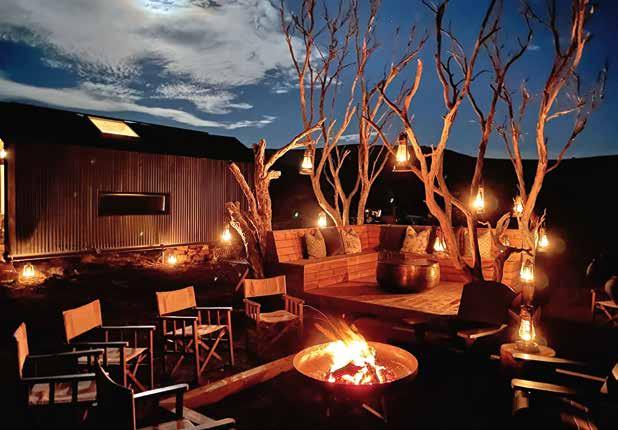
a clear night in the city and you may see a few scattered pinpricks of light, faint and defiant, but for the most part, the sky will be dark. No wood ashes scattered across the distant expanse. No fragments of edible root twinkling brightly. No myths. No stories.
It’s a shame, really, because it’s good to wonder.
When you stare at a sky full of stars, you gain perspective. It reminds you that there’s so much universe out there. And the stressors of the daily grind that feel so insurmountable to you on this little pebble we call home are,
in fact, not so big after all and more solvable than you might have thought.
When you look for the patterns in the stars, the ancient stories that our ancestors dreamt into being with a few twinkly dots and a hefty dose of imagination, it awakens your creativity. Maybe you make up new constellations and stories of your own – secret stories shared only with your companions, be they friends, your kids, or someone special.
Escape to the wild places in the world, away from the city lights, and you can experience the stars as people did centuries ago.
Starry, Starry Nights
When you book a special latenight game drive with a private guide at Mount Camdeboo Private Game Reserve by Newmark, you will experience some of the best stargazing South Africa has to offer. Above the sparsely inhabited expanse of the Great Karoo, the stars shine brightly, unimpeded by urban light pollution. You’ll learn about the constellations and how to navigate using only the stars as a guide.
Nights are quiet in the reserve, punctuated only by the sounds of nocturnal critters as they begin their night shift. If you’re lucky, you may catch a glimpse of an aardvark, a genet, a caracal or one of the other rarely spotted creatures that emerge from their little burrows after dark. Dress warmly – even in the heat of summer, the temperature dips at night.
On the other hand, at QWABI Private Game Reserve by Newmark, located within the Waterberg Biosphere Reserve in the north of South Africa, summer nights are warm. Most evenings, supper is an outdoor affair, with a roaring bonfire keeping any hint of an evening chill at bay and a canopy of stars overhead.
The mountains surrounding QWABI display rock paintings by the San – the same people whose oral traditions tell of the girl who threw fire ashes into the sky.
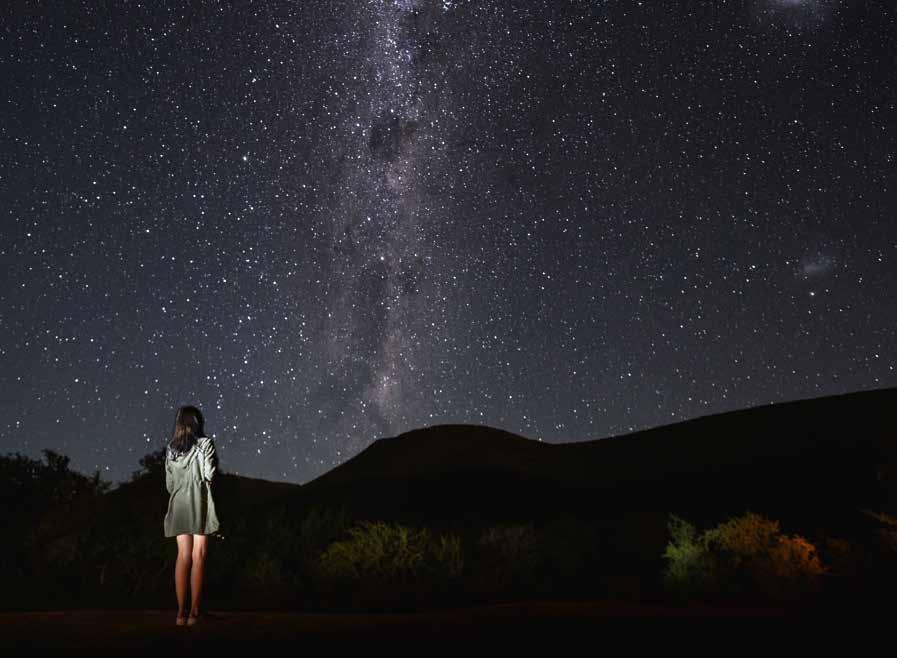
THE BIG 5 OF THE AFRICAN
NIGHT SKY
A stargazer’s guide to some of the interesting celestial objects to look for in the southern hemisphere
Lion, leopard, rhino, buffalo and elephant are famously known as Africa’s Big Five for game viewing. But look to the sky at night and you have the chance to spot the Big Five Of The African Sky, as identified by the Astronomical Society of Southern Africa (ASSA). These five were chosen to represent five classes of celestial objects that exist beyond our solar system. You can view them with the naked eye, but like with Big Five game viewing, timing is everything. Not all of them will be visible at all times, and as the sky shifts throughout the year, so these objects will appear at different times – the perfect excuse to spend a few more hours under the stars!
1/ SOUTHERN PLEIADES: OPEN STAR CLUSTER

After dinner, as you sit back with a nightcap, gazing up at the Milky Way overhead, perhaps you can share the story, knowing that thousands of years before, people sat in this same place, under these same stars, sharing the same myth of how they came to be.
An open star cluster is a loose collection of stars that were “born” together. It may contain anything from a handful of stars to thousands. They may be older or as young as a few million years old – spring chickens by celestial standards.
2/ OMEGA CENTAURI: GLOBULAR CLUSTER
Globular clusters are dense, tightly bound collections of stars – tens of thousands or even millions of them. These stars are far older – the elders of the night sky.
3/ THE ETA CARINAE NEBULA: BRIGHT NEBULA
A nebula is a giant cloud of dust and gas, often formed from the remnants of dying stars and is also where stars are born. A bright nebula either emits or reflects light.
4/ THE COALSACK: DARK NEBULA
A dark nebula doesn’t emit or reflect light and blocks light coming from behind it. It contains large amounts of dust that absorbs light, creating what looks like a hole in the sky.
5/ THE MILKY WAY: GALAXY
A galaxy is made up of stars, dust, gas and dark matter, all bound together by gravity. Our Milky Way is a spiral galaxy – it has spiral arms curving out from a dense central disc.

SERENITY MEETS ADVENTURE
Rekindle your creativity with a remote working break on the verdant bank of a lake in West Africa
BY WANITA NICOL

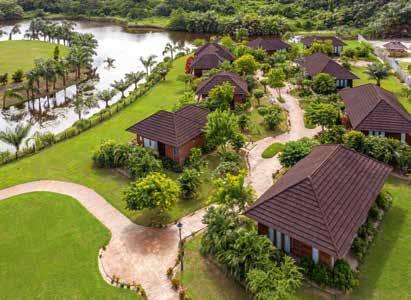

Imagine escaping your urban reality to spend 10 wild nights working remotely from your “second home” in West Africa every year. All the modern conveniences you’re accustomed to, including high-speed Wi-Fi, satellite TV and airconditioning in every room – but when you step out of your front door, you step into an African adventure. ACot4U packages at Lakowe Lakes Golf & Country Estate in Nigeria let you do exactly that.
LIFESTYLE DESTINATION
GETTING THE BALANCE RIGHT
Lakowe Lakes is a peaceful golf and housing estate located just 35km from Nigeria’s thriving capital city of Lagos. Yet its tranquil, tree-lined streets are the antithesis of the frenetic buzz of the city. Here, the pace of life is slower – striking a perfect balance between convenience, adventure and downtime.
AN ACTIVE START
Start your day with a walk in the fresh morning air before the temperature starts to climb, or book one of the resort bicycles and take a ride around the estate. You can also book a manual or electric scooter, if you’d prefer. For those looking to work on their backhand or
improve their golf swing, tennis and golf lessons are available, and if you’re ready to get straight into it, you can book a tennis court or play a round of golf with a pro. There’s also a swimming pool suitable for swimming laps.
BUSINESS AS USUAL
Who said out of office had to mean offline? With a fast Wi-Fi connection throughout the estate, you can set up your workstation wherever the mood takes you – be it at one of five restaurants and bars, poolside or in the comfort of your air-conditioned unit.
It’s amazing what a difference a change of scenery can make to the mind. You may find your thoughts are sharper, your brainstorms more effective and your creativity at an all-time high.
AFTER HOURS
When the workday ends, the adventure begins. Lakowe Lakes offers the perfect blend of serenity and excitement.
Homebodies may prefer to stay in and play board games, but the adventurous can choose to explore the 55-hectare man-made lake on an eco-friendly, self-propelled pedal boat, giving you a workout and a view at the same time.
Or, if you’re not in the mood for effort, enjoy a pontoon boat ride on the lake instead. If you’re a fishing enthusiast, you can cast your line from the shore or a boat as the mood takes you. And if you’ve brought the kids along, there’s a play area, a kids’ pool, and kids’ bicycles, as well as tennis courts for teens to enjoy.
However, it’s the pristine 18-hole, par-72 championship golf course that steals the spotlight. Designed by PGA professional and golf course architect Robert O’Friel, it measures just over 6,700m from the championship tees and 5,395m from the front tees and offers varied shot opportunities that will put your skills to the test. The golf club is one of Nigeria’s largest, attracting some of the country’s top golfers. It also has a driving range and a Pro Shop.
After an action-packed week of work and play, guests can enjoy an al fresco dinner on The Wine Bar deck, while marvelling at the spectacular sunset over the lake.
An escape to Lakowe Lakes is the perfect way to enjoy a working break without dipping into your leave.

SCAN TO BOOK
LAKOWE LAKES GOLF & COUNTRY ESTATE


SIGNALS FROM THE PAST
Before GPS and satellites, sailors set their course by the drop of a ball. Cape Town’s Time Ball Tower still stands as a working monument to that era – just metres from one of the city’s most elegant boutique hotels
Long before it received a new life as one of Cape Town’s most exclusive hotels, the Dock House Boutique Hotel was built as the harbour master’s private residence. It was the late 1800s. The Suez Canal, a shortcut for vessels travelling from Europe to the East, had only recently been completed, and Cape Town’s bustling harbour was an essential port on the highly prized trade route that took ships around the tip of Africa.
Timekeepers Of Yesteryear
But The Dock House isn’t the only relic of Cape Town’s maritime heyday. Alongside the elegant five-room hotel, you’ll find the Time Ball Tower – a red-brick structure with a ball perched atop a pole. Known as a time ball, it’s a curious technological throwback to a bygone era.
Like the Noon Gun on Signal Hill, which has boomed across the city since the early 1800s, the time ball gave ships at sea an accurate time reading.
Before satellite navigation, sailors relied on an instrument called a marine chronometer. They’d set the chronometer to the time of a known port. Once at sea, they could calculate their longitude by comparing the time on their ship to the time on the chronometer. Every hour of difference between the ship’s local noon and the chronometer time meant the ship was about 15 degrees east or west of its starting point, depending on whether the chronometer was fast or slow. On long voyages, early chronometers would often

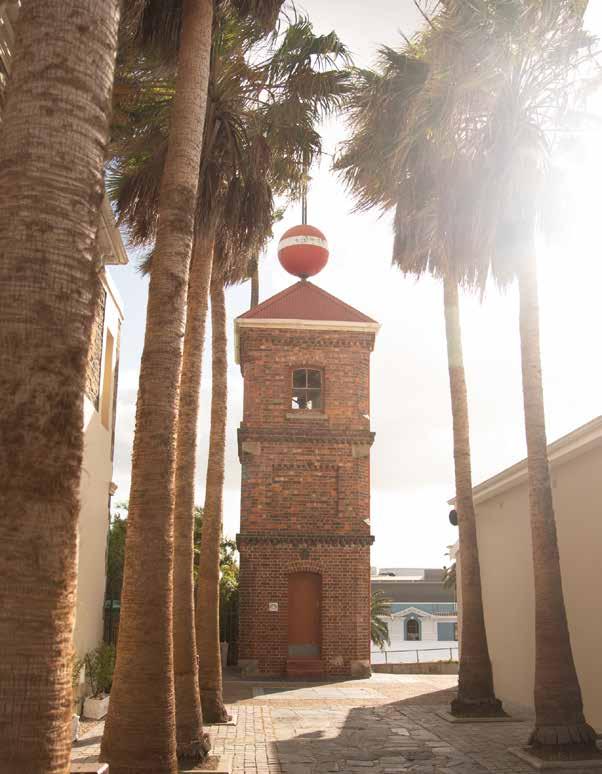

lose accuracy, and time balls were used to recalibrate them.
Located in prominent positions at ports around the world, the balls typically dropped at 1pm (noon in the US). The Cape Town time ball dropped at 1pm.
Five minutes before, the ball would be raised halfway, signalling to ships to have their chronometers at the ready. With two to three minutes to go, the ball would be raised all the way. At precisely 1pm, it would drop – the time was marked as soon as it began its descent.
Living Legend
Cape Town’s time ball is one of only a few still in existence around the world, and one of fewer still that are in working order.
Built in 1894, after two earlier time balls – located at the Royal Observatory (now the suburb of Observatory) and on Signal Hill – became obscured by the growing city, it communicated the time to ships in


As technology advanced and the need for time balls diminished, the tower was repurposed as a signal repeater for the area before falling into disrepair. Then, in 1997, the tower was restored, and its historic time ball returned to working order. Now, the old time signal is finally due for refurbishment again.
It may no longer be crucial for navigation, but Cape Town’s time ball stands as a monument to maritime history and the important role this city played in global trade routes. It’s one of several fascinating historic sites in the V&A Waterfront precinct dating back to this era – a living link to a different time.

Cape Town’s Table Bay for 40 years.











BLACK BAY 58

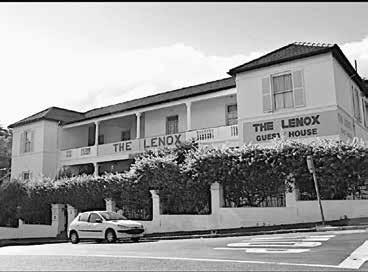
RETURN OF THE LENOX
Iconic Cape Town guesthouse The Lenox is quietly transforming – not into something new, but into what it was always meant to be
In the heart of Cape Town, tucked against the lower slopes of Table Mountain, there is a green, leafy suburb called Gardens. It’s a quiet area. Just a short walk from the buzz of Kloof Street (if your legs don’t mind the hills!), it has a laid-back suburban energy. The streets are tree-lined and flanked by sturdy buildings soaked in history. One of them is The Lenox Guesthouse.
A Building With A Past
Neat and unassuming, The Lenox has spent the last few decades as a comfortable guesthouse-cumbackpackers. But something about its modest façade doesn’t quite fit. It’s a little too elegant for a simple backpackers – there are lingering hints of an illustrious past.
Beneath the surface, The Lenox holds more than a century of stories. Its bones trace back to Mount Vernon, a gracious double-storey villa constructed in 1897. In the 1930s, Mount Vernon was expanded
BY WANITA NICOL
and transformed into The Lenox – a residential hotel that quickly earned its place among Cape Town’s most esteemed establishments. Its signature dining room, added in 1935, remains one of the most significant architectural features. Hidden in plain sight, layers of heritage still weave through the property – from the stone werf walls aligned with the original 18th-century wagon road to Lincoln House, a rare lateGeorgian villa on the corner of the site, and fragments of mid-19th century outbuildings. Together, these elements tell a rich and varied story of Gardens as it evolved from farmland to fashionable suburb.
Faded Grandeur
Over time, the once grand address quietly slid into obscurity, becoming a backpackers under private ownership. While its location remained enviable – diagonally across from De Waal Park, where families come to picnic on warm summer days – its physical condition lost its sheen. Now, that’s changing.
In partnership with a team of heritage specialists and architects, Newmark Hotels & Reserves has embarked on a painstaking restoration of The Lenox after it was recently acquired by an affiliate of Memorist and Mobilitas.
Honouring The Heritage
Memorist is a preservation and heritage valorisation company and a division of
Mobilitas. The respectful refurbishment will include the establishment of a boutique hotel, as well as an artists’ residency.
The restoration is about honouring the past and making it visible. Historic walls, where possible, are being retained and restored, and key historic features are being lovingly highlighted.
Where modern elements are introduced, they will frame the past respectfully.
A new wing will rise at the back of the property, where it won’t disrupt the heritage streetscape. A restored cobbled courtyard with in-between urban gardens will connect heritage to nature. The private roof-terrace pool will allow guests to enjoy magnificent mountain views.
A Landmark Reimagined
One of the most exciting aspects of The Lenox’s next chapter is the artist residency. Once restored, parts of the hotel will play host to working artists from France and South Africa, with living and studio spaces at the top of the building, and exhibitions spilling into shared spaces. Even the garden will be a canvas, changing with the seasons. This celebration of art is in keeping with a thread woven throughout Newmark’s properties, all of which feature carefully curated art pieces.
With a new lease on life, the Lenox is poised to reclaim its place as one of Cape Town’s most talked-about stays.
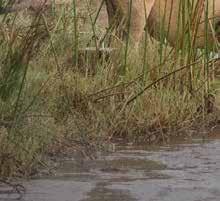
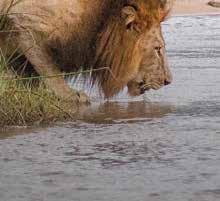
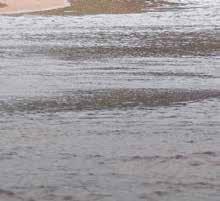
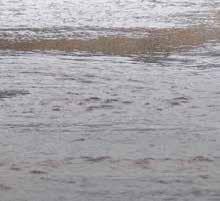








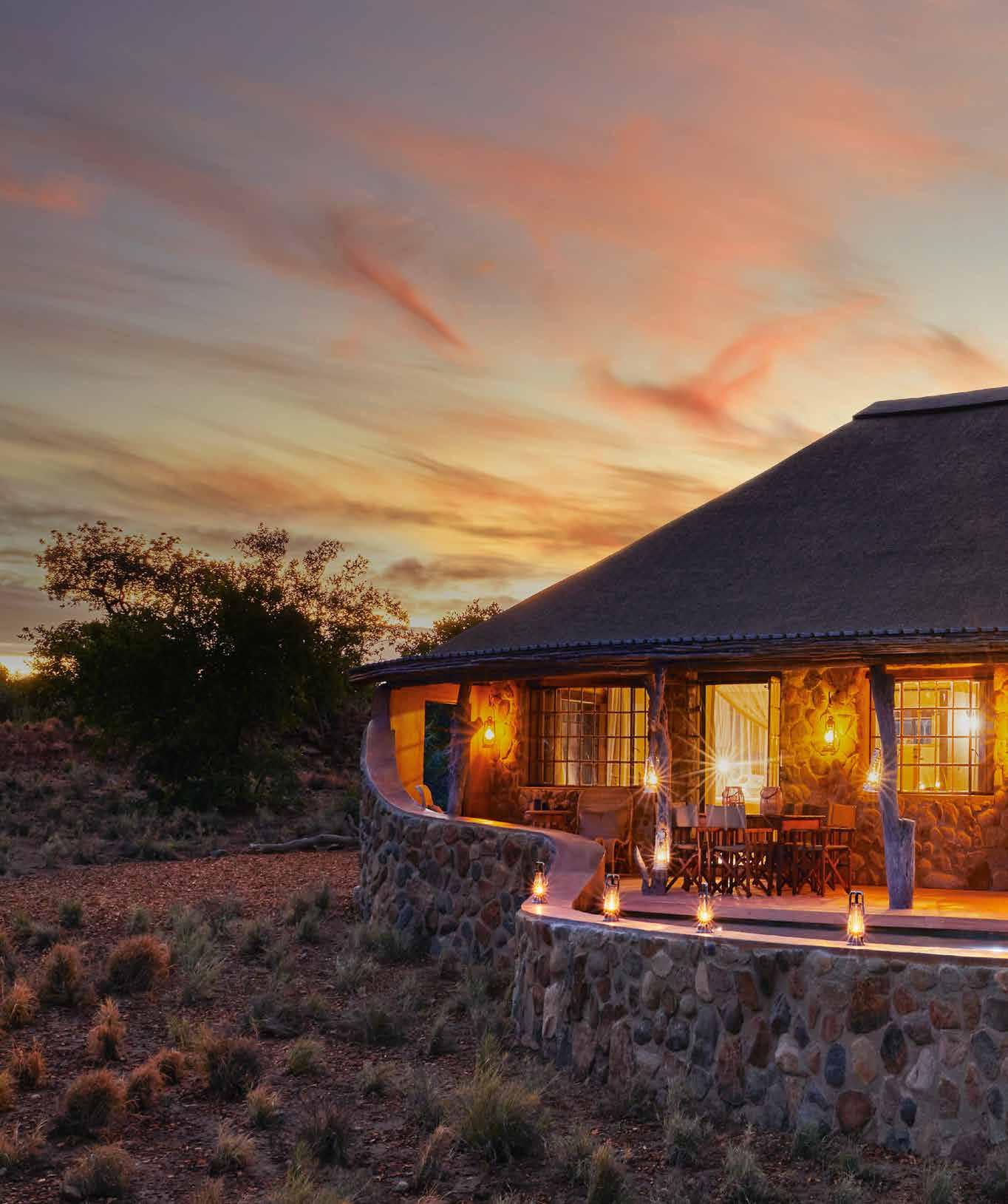
A STORY IN STONE AND THATCH
Exclusive, secluded and luxurious – the newly launched Modjadji Master Suite is an exciting addition to Geiger’s Camp at Motswari Private Game Reserve
PHOTOGRAPHS BY MICKY HOYLE
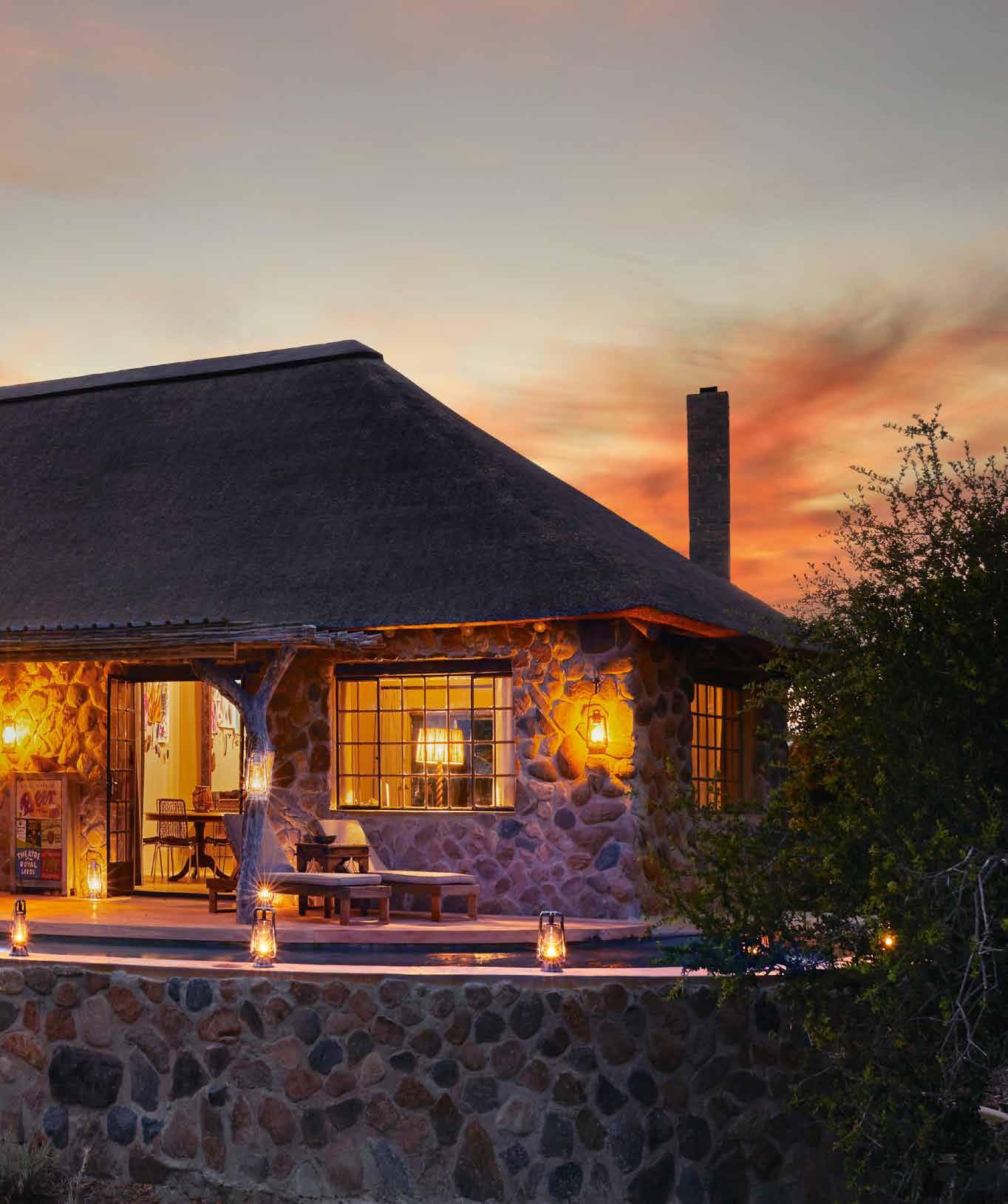
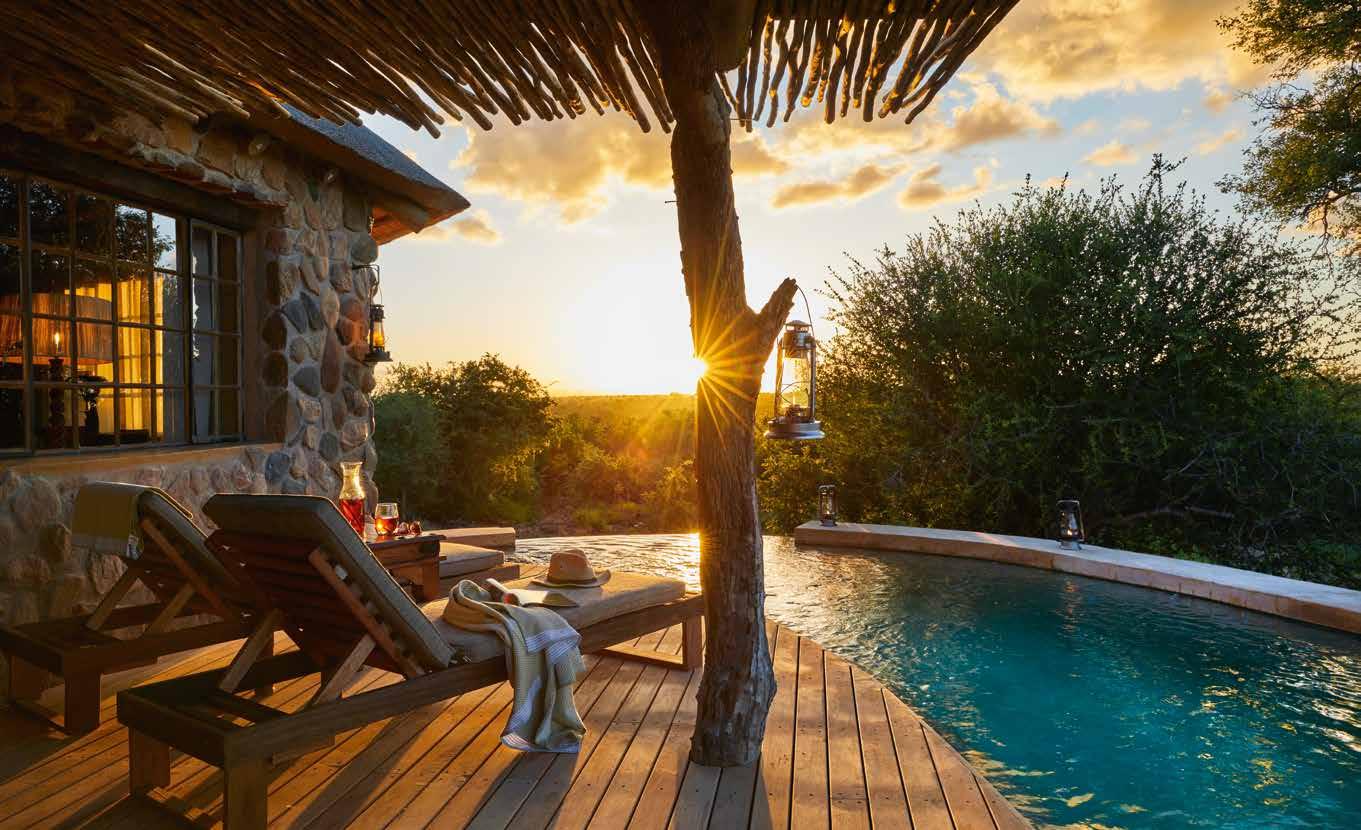
Geiger’s Camp has always been a place where design is guided by nature, where luxury is defined by space, stillness, and a sense of belonging. The new Modjadji Master Suite adds another layer to its story.
Named after the legendary Rain Queen of the Balobedu people, the suite takes its name from a figure both revered and elusive – a ruler who could call the rains and command the land. This space carries that energy, built from local stone and thatch – textures that blend seamlessly into the wilderness environment.
A Secluded Sanctuary
Originally a traditional family home, Geiger’s Camp –owned by Marion Geiger – has always carried a sense of warmth and familiarity. You’ll find the same ethos in Modjadji, a natural extension of the camp that reflects its intimate, deeply personal experience.
Geiger’s Camp offers a setting for families or small groups, accommodating up to eight guests across four luxury suites. The Modjadji Master Suite, sleeping two
guests, provides a more secluded sanctuary within the camp – the kind of privacy that feels expansive rather than enclosed. A convertible lounge area allows the suite to accommodate a family of four within its 139m² layout.
Embracing al fresco living, the en-suite bathroom flows into an open-air shower, while the spacious lounge – anchored by a fireplace and dining area –opens onto a private deck, where the pool seems to spill into the wilderness.
Carefully positioned to capture the slow arc of the sun as it dips beyond the horizon, the suite offers a front-row seat to the bushveld’s shifting light and endless expanse. As in every suite at Geiger’s Camp, you’ll find a watercolour paint box – a creative invitation for those inspired by the ever-changing textures, shapes, and tones of the land.
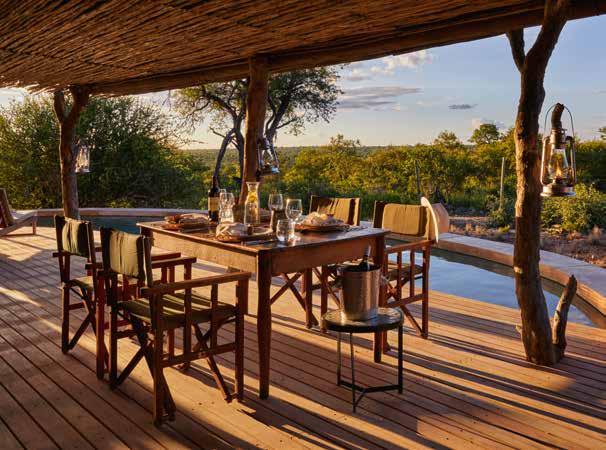
EACH PIECE TELLS A STORY –CHOSEN THROUGH INTUITION, NOT DESIGN RULES.
Shaped By Nature
Modjadji is the result of a hands-on collaboration with skilled local artisans who have worked the land for generations, favouring time-honoured techniques over heavy machinery.
Each stone was placed by hand, each texture chosen to blend into the landscape rather than impose upon it. Built from stone and thatch, the suite stays naturally cool even in the height of the day –its materials chosen as much for function as for form.
“We used local thatch and rocks we gathered ourselves,” shares Marion. “We worked with absolute craftsmen and built with the rhythms of the bush. Building here is different – it’s an organic process, a labour of love. It’s slow, intentional, and deeply connected to place.”
A Space That Holds You
The same thoughtful philosophy that shaped Modjadji’s architecture extends to its interiors, where Marion – artist, collector, and designer – collaborated with interior designer David Strauss to create a space with an intentional, layered aesthetic.
Every detail has been hand-selected, from handcarved doors to antique furnishings – each piece telling a story, sourced through auctions and travels over time.
The colour palette remains subtle and understated, allowing the surrounding bush to take centre stage. Against this natural backdrop, the interiors feel warm, tactile, and personal. Two of Marion’s own paintings,
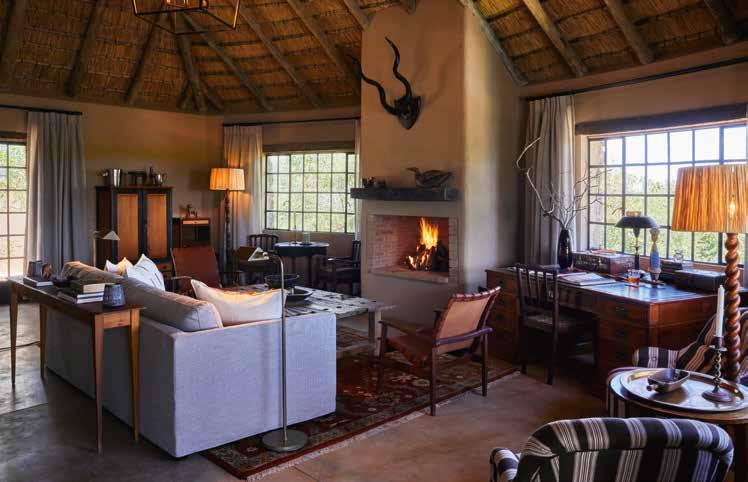
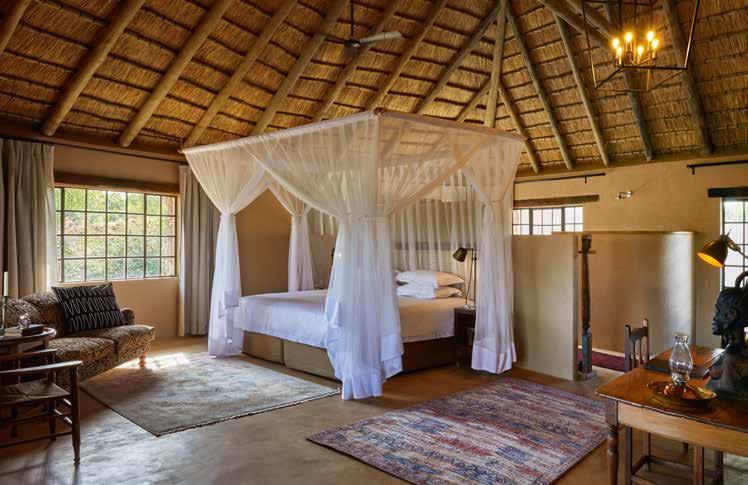
created during the suite’s construction, are displayed in the bedroom and lounge, adding an intimate signature to the space.
Each piece has been collected rather than curated, chosen through intuition and experience rather than design rules.
“The most important thing for me is that a place holds you,” says Marion. “It should feel like home – not like it’s trying to impress. Geiger’s Camp has always been about layers of history, personality, and comfort, and Modjadji is no different.”
A Milestone In Motswari’s Legacy
The unveiling of the Modjadji Master Suite comes at a pivotal moment as Motswari Private Game Reserve approaches its 50th anniversary – a milestone that celebrates heritage, craftsmanship, and an unbroken connection to the land.
More than a place to stay, Modjadji is a place to arrive.

SCAN TO BOOK
GEIGERS CAMP AT MOTSWARI PRIVATE GAME RESERVE
UNDER THE SEA
Explore the world beneath the waves at La Maison D’Été on the tropical island of Mauritius
BY WANITA NICOL
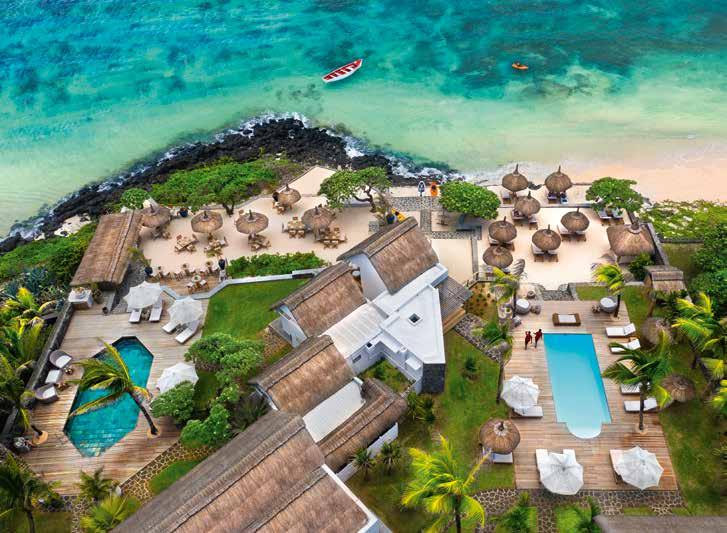
Landing on the African island of Mauritius is escaping to paradise. As soon as you step off the plane, the almost yearround tropical heat lets you know you’ve arrived somewhere exotic. The air has that thick feeling that comes with high humidity, and if you were wearing a jersey on the plane, you can now stow it in your luggage, secure in the knowledge that you won’t be needing it for the rest of the trip. Instead, your swimsuit is about to become your daily uniform, and the welcoming, warm water of the Indian Ocean will become your natural environment.
The World Beneath The Waves Snorkelling in Mauritius is a special experience. For starters, the water is almost always a near-perfect lukewarm temperature – just cool enough to be refreshing but warm enough that you can wade in comfortably and wallow in the shallows for hours.
The island is protected by a reef that keeps the sea gentle and flat. Most days, it seems almost more lake than ocean, with water lapping gently at the shoreline and rippling out to the horizon.

That reef also acts as a natural barrier, keeping most large sea life away from the swimming beaches. But smaller fish are right at home.
Book your snorkelling equipment at reception – you can hire masks, flippers and snorkels for free, along with bicycles, paddles and kayaks – and you can explore the hidden wonderland that exists
beneath the surface. While a boat ride can take you further out to explore the reefs themselves, there’s plenty to see without heading far out at all. The shallow, crystalclear water makes for excellent visibility. Look for Nemo and Dory swimming about their business, along with stripey surgeonfish and spotted tang. It’s a colourful world and the water is shallow enough that sunlight still reaches the sea floor, lighting up the colours. Keep an eye out for the vibrant Blue Mauritius Angelfish and its striking cousin, the Threespot Angelfish, glowing an almost luminous yellow. If you’re lucky, you may even spot an eel.
Poolside Lounging
For those who prefer the pool to the open water, the resort has two to choose from, each of which has uninterrupted ocean views, sunbeds to laze on, and refreshing cocktails within easy reach.
Just metres from the ocean itself, with palm trees swaying overhead, the swimming pools are almost like being on the beach – just without the sand.
And when your skin is warm from the sun and wrinkly from the water, visit the resort’s La Parenthèse Spa for an indulgent treatment. Choose from massages, facials, body scrubs and wraps, or add a finishing touch to your tips with a mani or pedi. There’s even a kids’ spa menu for your mini-bestie to enjoy.
A stay at La Maison D’Été will wash away your stress, leaving you with sun-kissed skin and a full heart.
SCAN TO BOOK
LA MAISON D’ÉTÉ
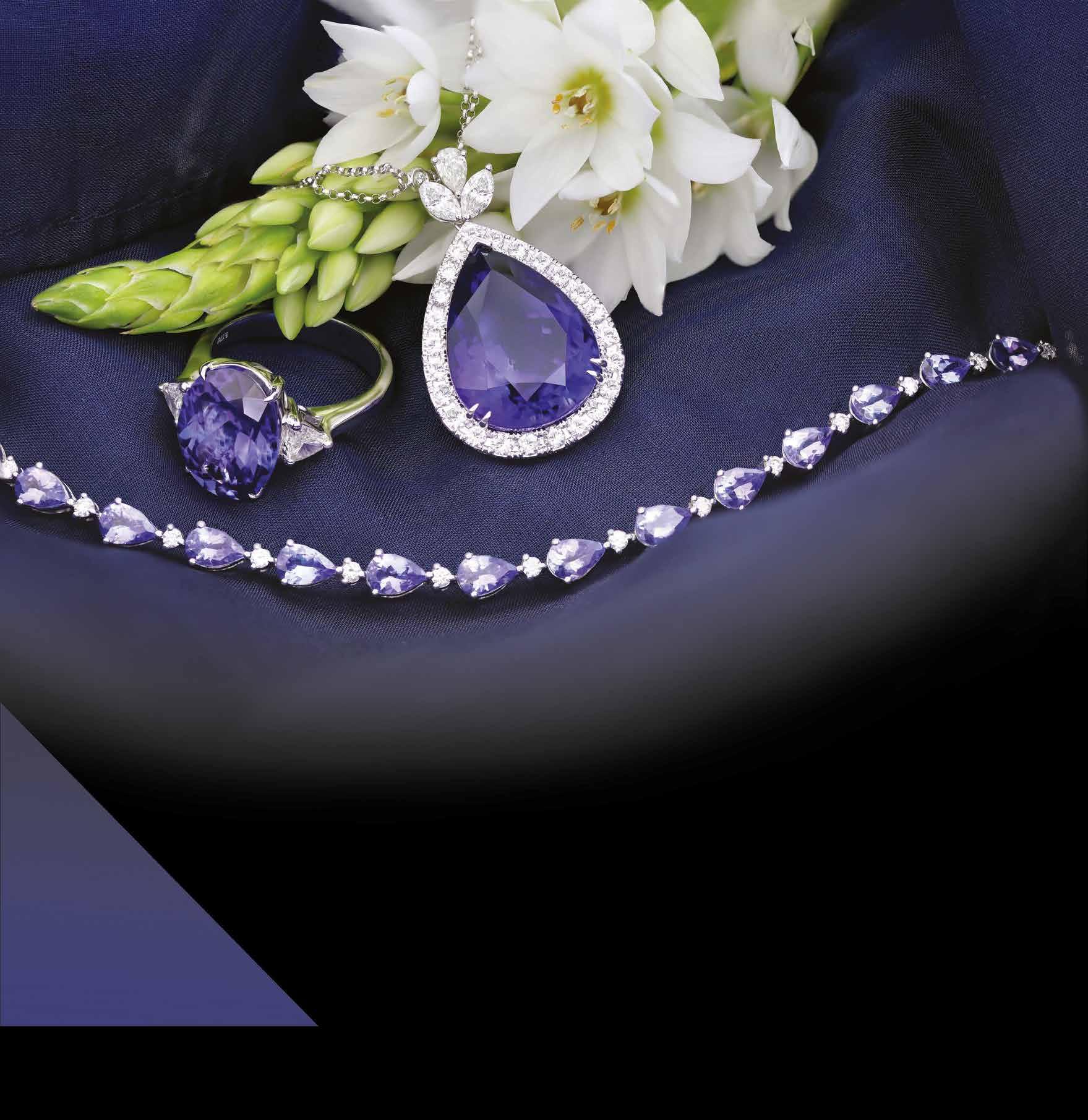
DOWNTOWN STYLE
Elevate your trip to the city

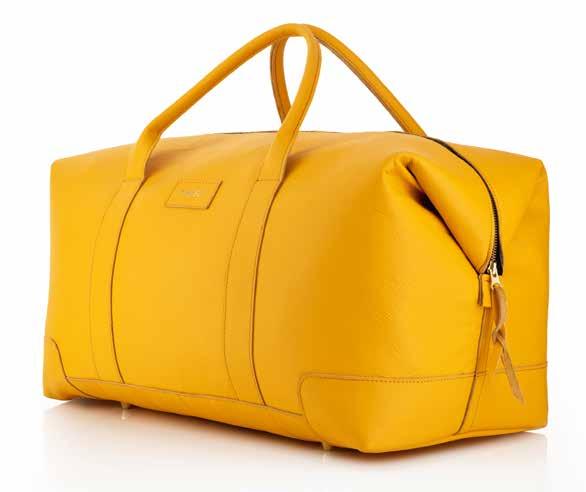
JOINERY
Weekender Bag
The Weekender bag is made from a 100% locally sourced yellow full-grain leather and is the perfect travel companion. It’s the ideal cabin carry-on bag. It has an internal pocket and metal zips and is lined with FutureFelt®, made from recycled plastic bottles. And you can add personalisation by having your initials embossed on the bag. Pack quick, let’s go!
R4 750 thejoinery.co.za @thejoinerysa
Sunglasses
These signature sunglasses offer a distinctive aesthetic. The frame has black lenses with black and crystal temples with a doublelayer effect. Adorned with the iconic goldtone Christian Dior Couture signature, they are enhanced by bevels that create a dynamic interplay of volume. Black lenses displaying the Christian Dior signature on the left lens add the finishing touch to the contemporary style.
POA
picotandmoss.co.za
@Picotandmoss +27 11 669 0796


POMELLATO
Reversible Ring
Pomellato introduces Pom Pom Dot, a joyful new range of jewels. The design is based on a button, a motif that forms part of Pomellato’s design heritage, but which also has historical significance, both as a functional accessory and talisman. Pom Pom Dot’s soft round silhouette becomes a modern-day emblem of connection and protection.
POA
bhhboutique.co.za
@BHH_Boutique +27 11 669 0790
The TAG Heuer Monaco Chronograph Stopwatch marks a defining moment in the legacy of timekeeping on the racetrack. When Steve McQueen chose to wear the iconic square timepiece in Le Mans in 1971, it forever linked the watch to the golden age of motorsport. Since then, it’s evolved in design but has always stayed true to its roots.
POA picotandmoss.co.za
@Picotandmoss +27 11 669 0500
CHRISTIAN DIOR Label



Two-Tone Gold Natural Fancy Yellow Diamond and White Diamond Neckpiece
Crafted from 18K white gold, this piece features accents of yellow gold and a classic setting of pear and radiant-cut natural fancy yellow diamonds totalling 7.60-carats. The exquisite design includes a total of 5.44-carats of round-cut natural white diamonds graded GH in colour, providing a bright, nearcolourless appearance with a clarity grade of VS-SI. POA
thediamondworks.co.za @thediamondworks

Vanilla Sundae Body Cream
The delightfully smooth Kudu whipped body cream is a holiday in a jar. A perfect summer cocktail of Madagascan vanilla, subtle citrus and delicate rose to smooth and soften your skin after another sumptuous day spent by the pool!

SHIMANSKY The Southern Cross
MUNGO Vrou-Vrou Throw
R375 kuducosmetica.com @kuducosmetica
High above the southern skies, the iconic Southern Cross constellation has guided explorers and dreamers for centuries. A symbol of hope, discovery, and celestial wonder, it continues to shine as a beacon of the southern hemisphere’s rich heritage. Capturing its brilliance, Shimansky’s Southern Cross pendant is a timeless tribute to this guiding light – crafted for those who journey with meaning.
R23 350 shimansky.co.za @shimansky.sa
Although called the VrouVrou Throw, it’s technically a full-sized blanket and made to cover a bed. But it’s also great for an evening stroll or marking your picnic spot. The classic waffle weave has a cellular structure which gives it a chunky body and texture. The pure-cotton yarn ensures that it remains light and breathable, perfect for year-round luxury.
R3 840
mungo.co.za @mungodesign
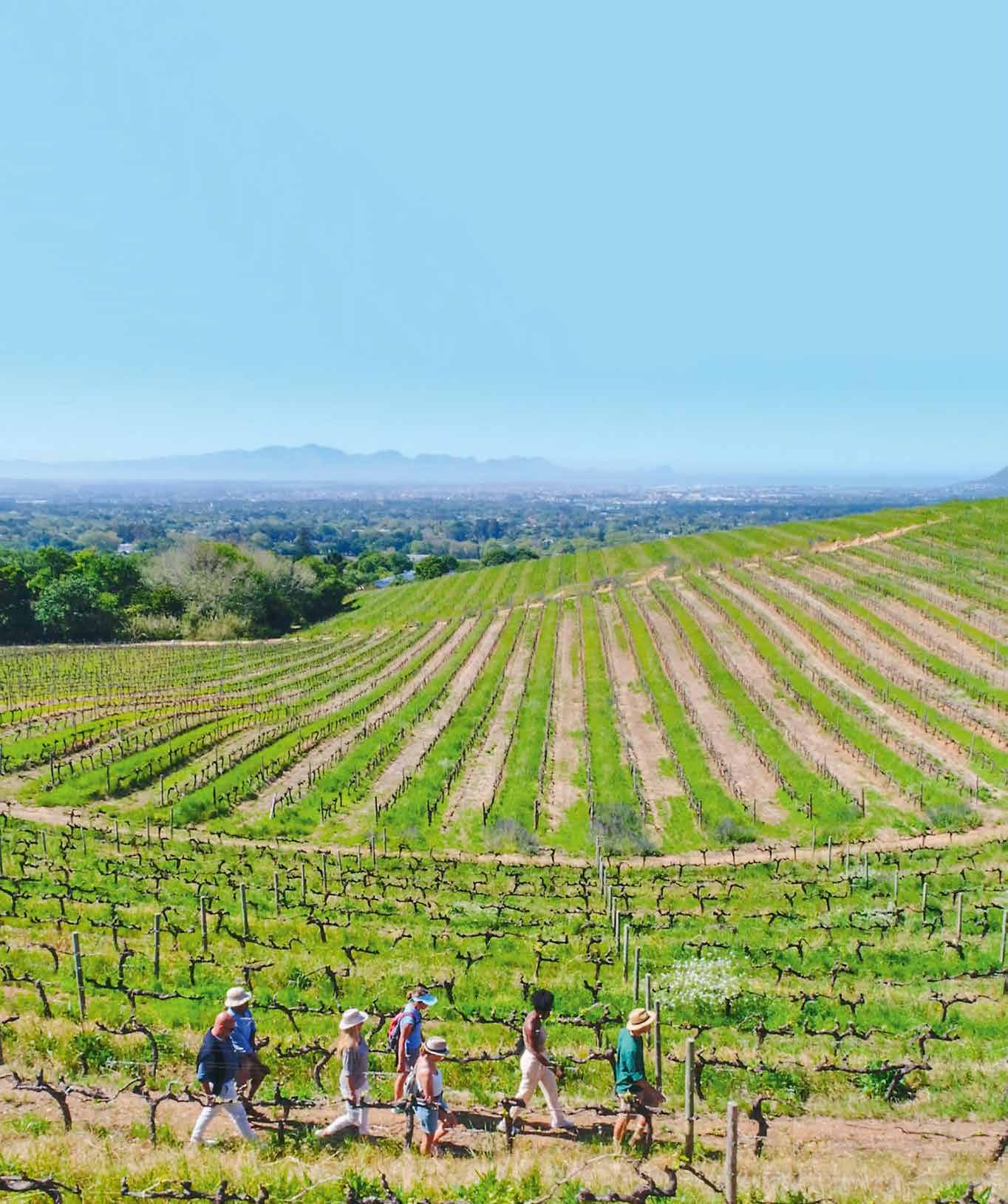
A Perfect COASTAL
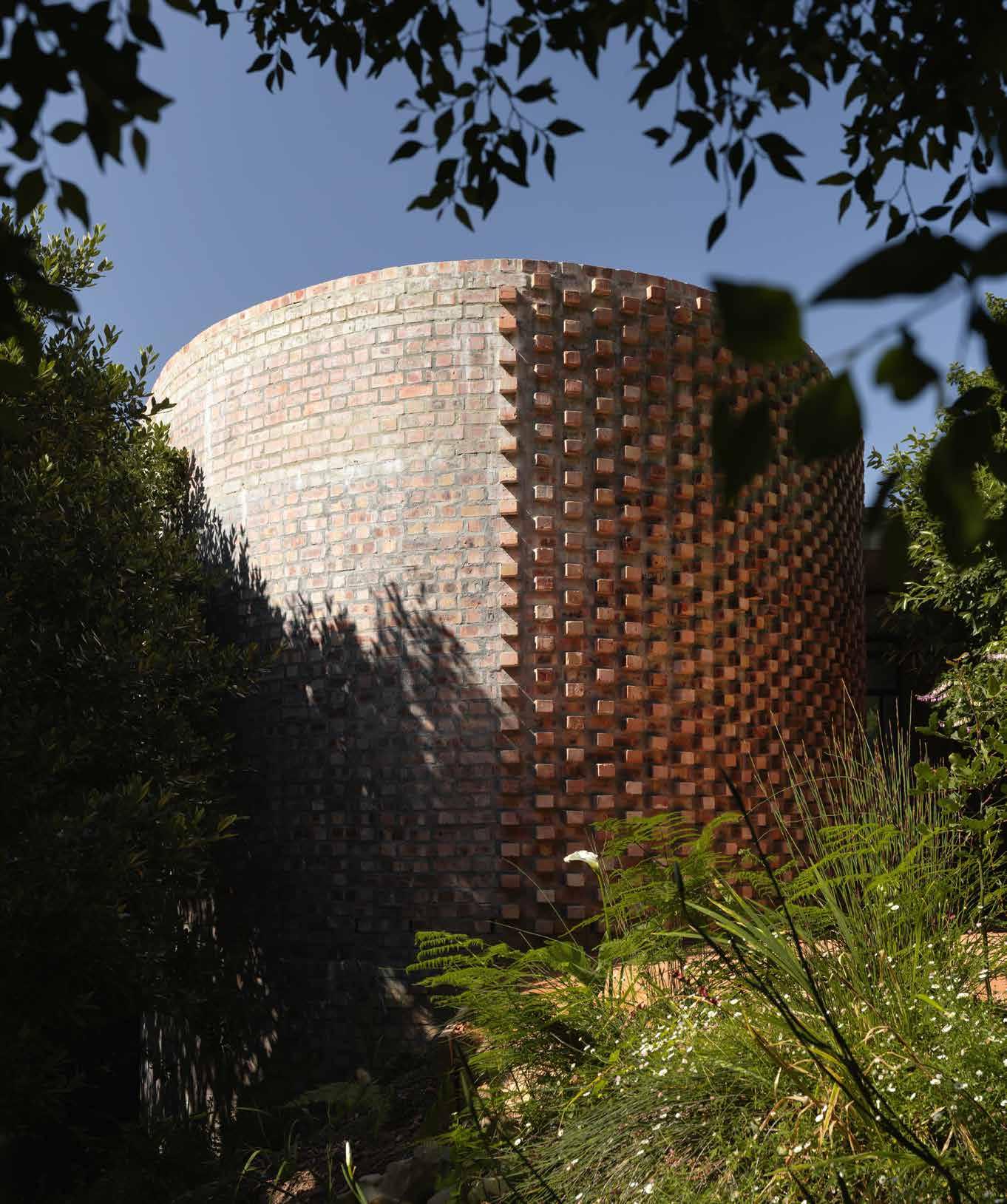
Below the forested slopes of Table Mountain’s hidden corner lies Future Found Sanctuary – a retreat like no other
BY PIPPA DE BRUYN
Present
house. Opposite page: Take a guided wander through the Cape’s oldest vineyards.
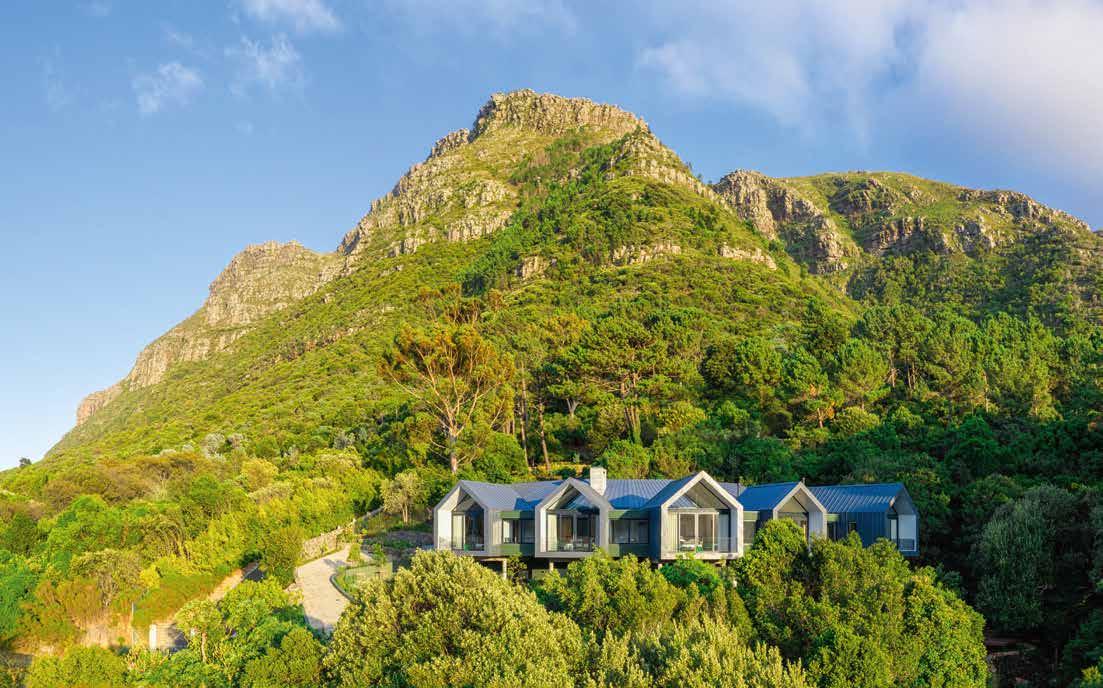
Future Found Sanctuary defies categorisation:
a hotel that feels more like a well-staffed private house; an urbane depository for contemporary design, surrounded by wild nature; a regenerative wellness retreat, but also a place of sybaritic pleasures: garden-to-table meals as nutritious as they are delicious; popcorn and snacks in the private in-house movie theatre; a well-stocked wine cellar to browse before dinner.
Located in a residential area bordering the steep slopes of Orange Kloof – a conservation area protecting the dense Afrotemperate forests of Table Mountain National Park – it’s made its home in a magical part of the city. It’s remarkably unknown, with restricted access to the trails that meander through the wild fynbos that fringes the forests, riven with
streams and waterfalls. What luck, then, that Jim Brett and his husband, Ed Gray, two regular visitors to the city, discovered an old family house for sale here in 2014.
In thrall to the commanding power of the property – soil watered by Table Mountain streams, sweeping views of the ancient forests, granite peaks looming above the carpet of green – it signalled not only their own “future found” but a place where other seekers could retreat from the hurly-burly of modern life, and regenerate in the embrace of elemental nature.
Jim and Ed set about building two contemporary five-bedroom villas – Maison Noir, then Villa Verte – unique in design but each with five peaked roofs symbolising the five elements (a theme carried into the kitchen garden that supplies many of the herbs and vegetables) and floor-to-ceiling glass to frame the garden and mountain surrounds. In 2024,
Mountain View Villa and two onebedroom ‘forest pods’ followed – gorgeous cocoons, ideal for honeymooners. With their wealth of interior experience (Jim’s impressive CV includes doubling sales as merchandise manager at Anthropologie Home, producing doubledigit growth as President of West Elm and being named the recipient of Interior Design magazine’s “Greater Good” award for his support of small-scale artisanal craft production; Ed previously owned Bruges Home, a luxury home furnishings store in Philadelphia), they furnished the spaces with custom-made locally produced pieces and hand-picked a great collection of contemporary art. Master horticulturist Cherise Viljoen was tasked with transforming the 5.4 acre grounds, creating tiered landscapes that invite exploration, with plenty of private nooks to contemplate the surroundings.
Future Found Sanctuary is magically situated with sweeping views of the ancient forests, granite peaks looming above a carpet of green.
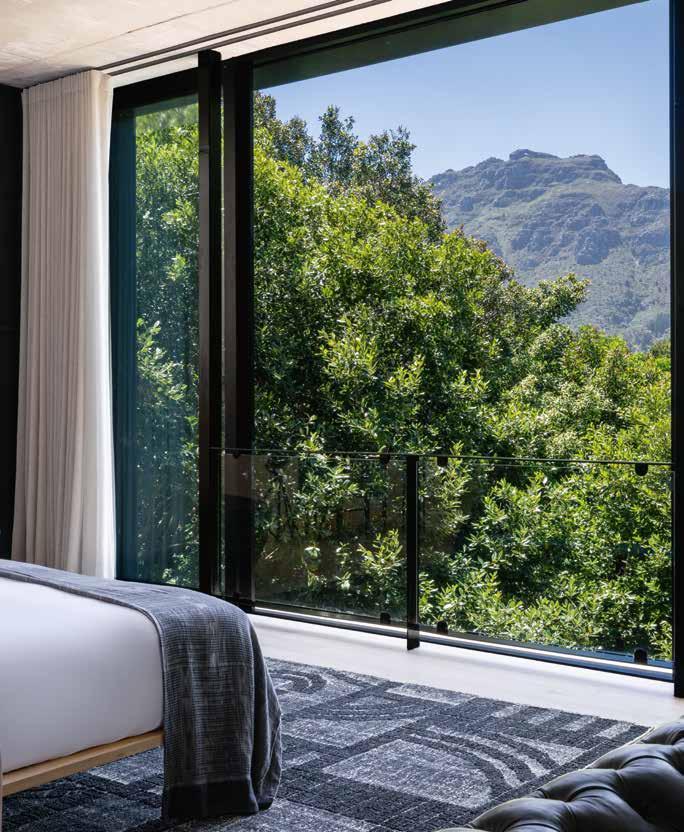
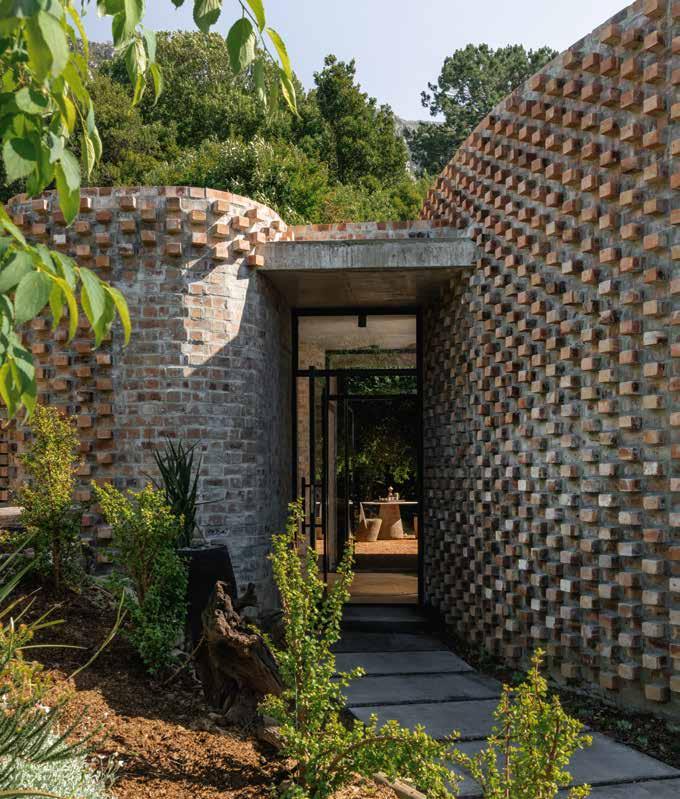
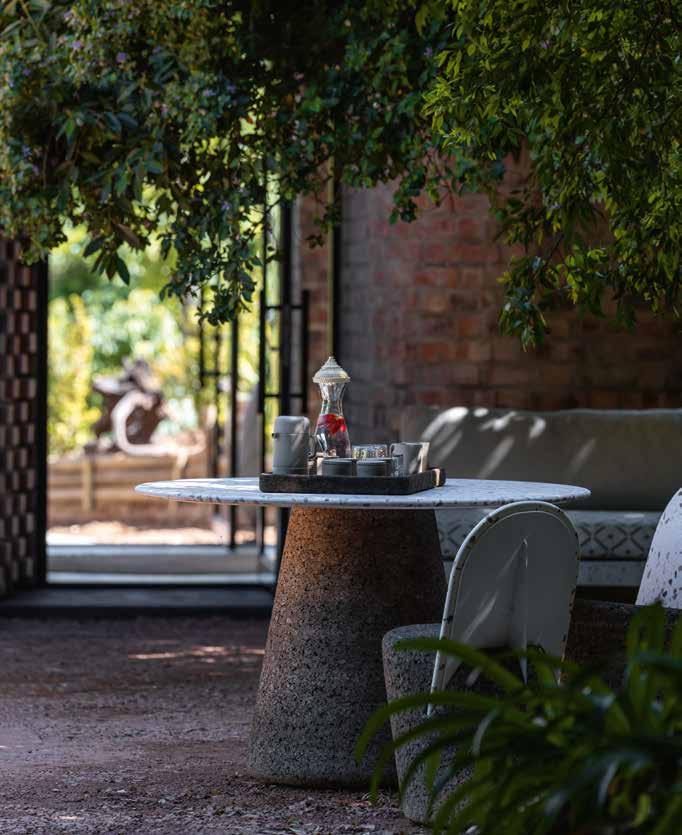
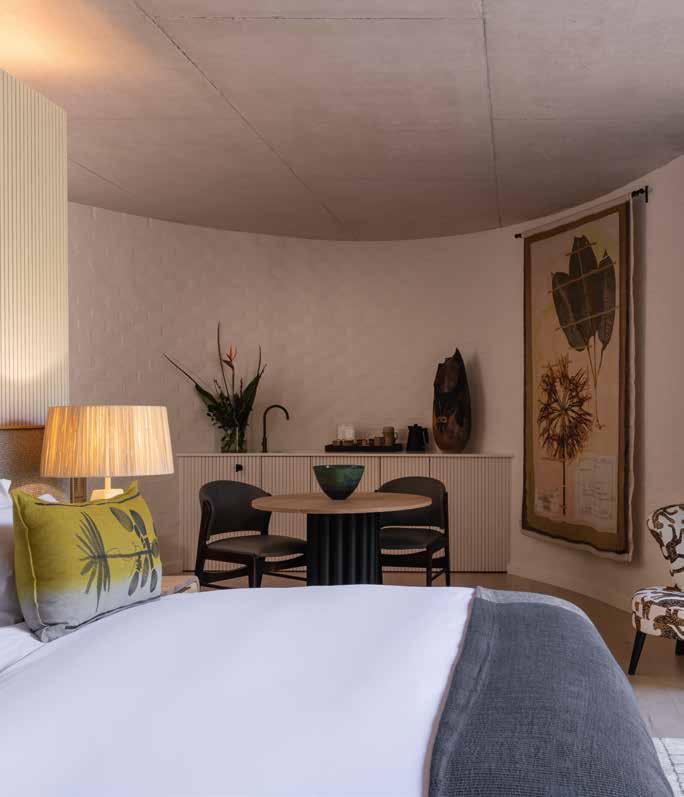
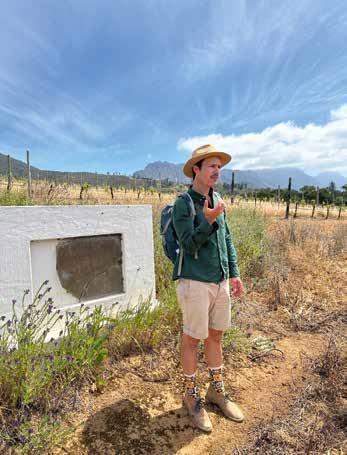
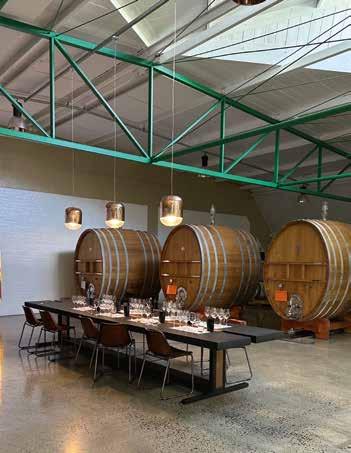
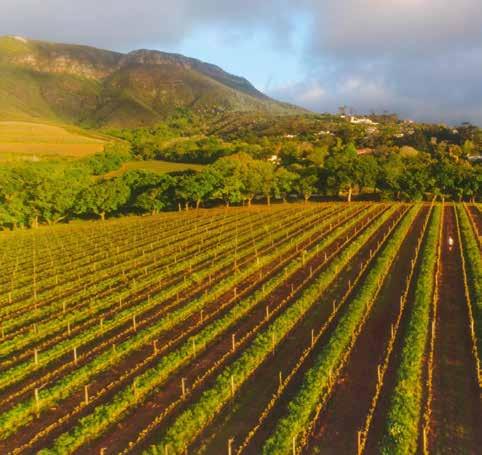
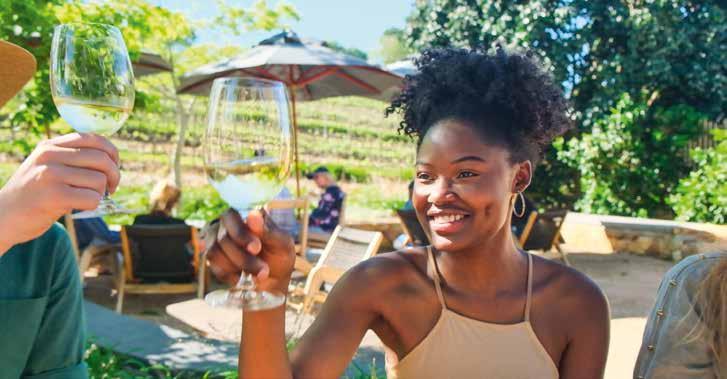
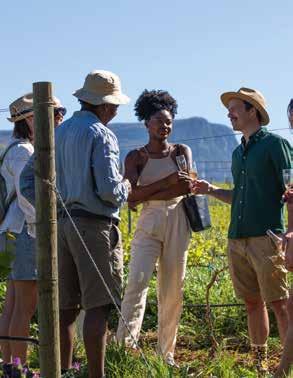
The result is rather like staying in an intimate reserve lodge, and GM Andrew Rosettenstein – who has spent many years at the helm of high-end safari lodges – leads a well-trained team and pulled in talented chef Malika van Reenen, who augments her daily kitchen garden harvest with produce sourced from ethical producers and farmers.
Wellness is naturally a central theme; aside from being able to prebook treatments such as acupuncture, yoga, breathwork, sound healing and kinesiology, or utilise the spring-fed outdoor immersion pool, sauna and steam room, just being here is a balm, with a
serene atmosphere and lovely touches like the loose-leaf teas marked Rise, Realign, Reflect, and Rest.
That said, if your idea of wellness is a delicious glass of wine, the cellar offers a great representation of the Cape’s varied terroir, picked by Marlvin Gwese, Newmark’s ace Group Sommelier. And in less than 10 minutes, you can be cresting Constantia Nek: gateway to the oldest winelands in the New World, and home to Matt Sterne’s award-winning wine tasting experience – the Constantia ‘sip and stroll’ wine walk (naturalwanders.co.za).
Geoff Heald, who works with Matt, is an excellent raconteur. As he leads the
way off piste into Groot Constantia’s vineyards, he regales us with the early origins: the first vines, planted by Jan van Riebeeck, reluctant commander of the VOC victualling station, produced the first wine on 2 February 1659 – his journal entry reads: “Today, praise be to God, wine was made for the first time from Cape grapes” – but governor Simon van der Stel, who arrived two decades later, pronounced Cape wines undrinkable. Van der Stel petitioned the VOC to allow him to import better stock and planted the first successful vineyards “right here, on the farm he named Constantia”.
Join Matt Sterne’s award-winning ‘sip ‘n stroll’ wine tasting and vineyard walk.
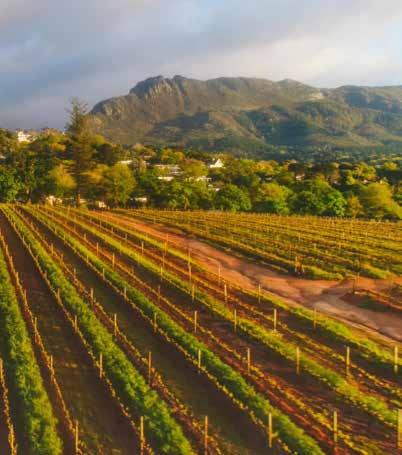


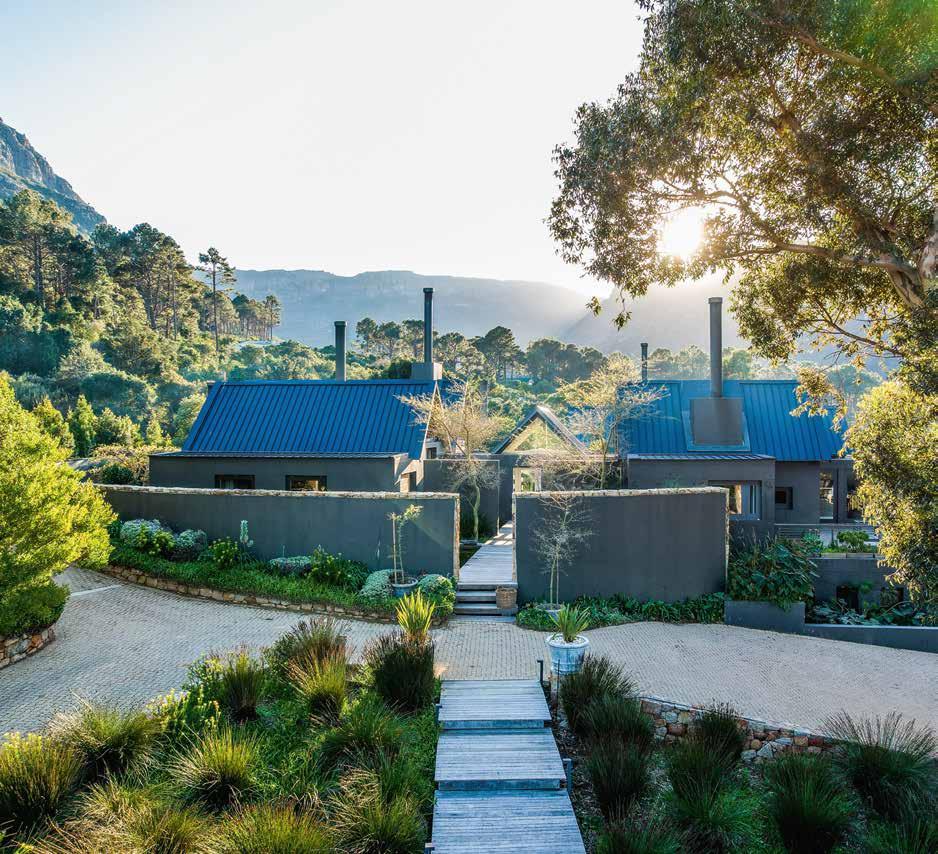
Bathed in soft autumnal light, we wander past trellised vines, stopping at a graveyard to photograph the iconic Groot Constantia manor house – white gables etched against a backdrop of lush greens, hearing about subsequent owners, one of whom was a freed slave called Anna. In the shade of an oak, with a great vantage of Steenberg, aka “Mountain of Stone”, Geoff produces a chilled bottle of Steenberg bubbly from his backpack, a personal favourite. Pouring each a glass, he tells the fascinating tale of Catharina Ras, the penniless young German who arrived in the nascent colony in 1662. Having survived four husbands – Geoff describes
“WE COVERED SIX KILOMETRES AND TASTED 12 WINES PRODUCED BY THE CONSTANTIA TERROIR.”
each dramatic death with panache – Ras persuaded Simon van der Stel to grant her the title deed to the farm that would become known as Steenberg, and so she became the first woman to officially own a farm in the Cape.
Onwards we press to Klein Constantia, passing bucolic scenes, hearing when and how the fame of Constantia wines spread, appearing in the works of Jane Austen and Charles Dickens, demanded by the likes of Bismarck and Napoleon. By the time we have finished a cheese and charcuterie platter at Buitenverwachting, we have covered six kilometres and tasted 12
wines produced by the Constantia terroir. My butler, who kindly assisted in arranging my return transfers, is there to say “Welcome home”. Luxuriating in my treetop suite with a glass of Eagle’s Nest Merlot – a Constantia wine picked from the cellar – I contemplate the marvel of a morning spent delving into the Cape’s fascinating past and the luxury of repairing to Future Found, a rather perfect present.

SCAN TO BOOK FUTURE FOUND SANCTUARY
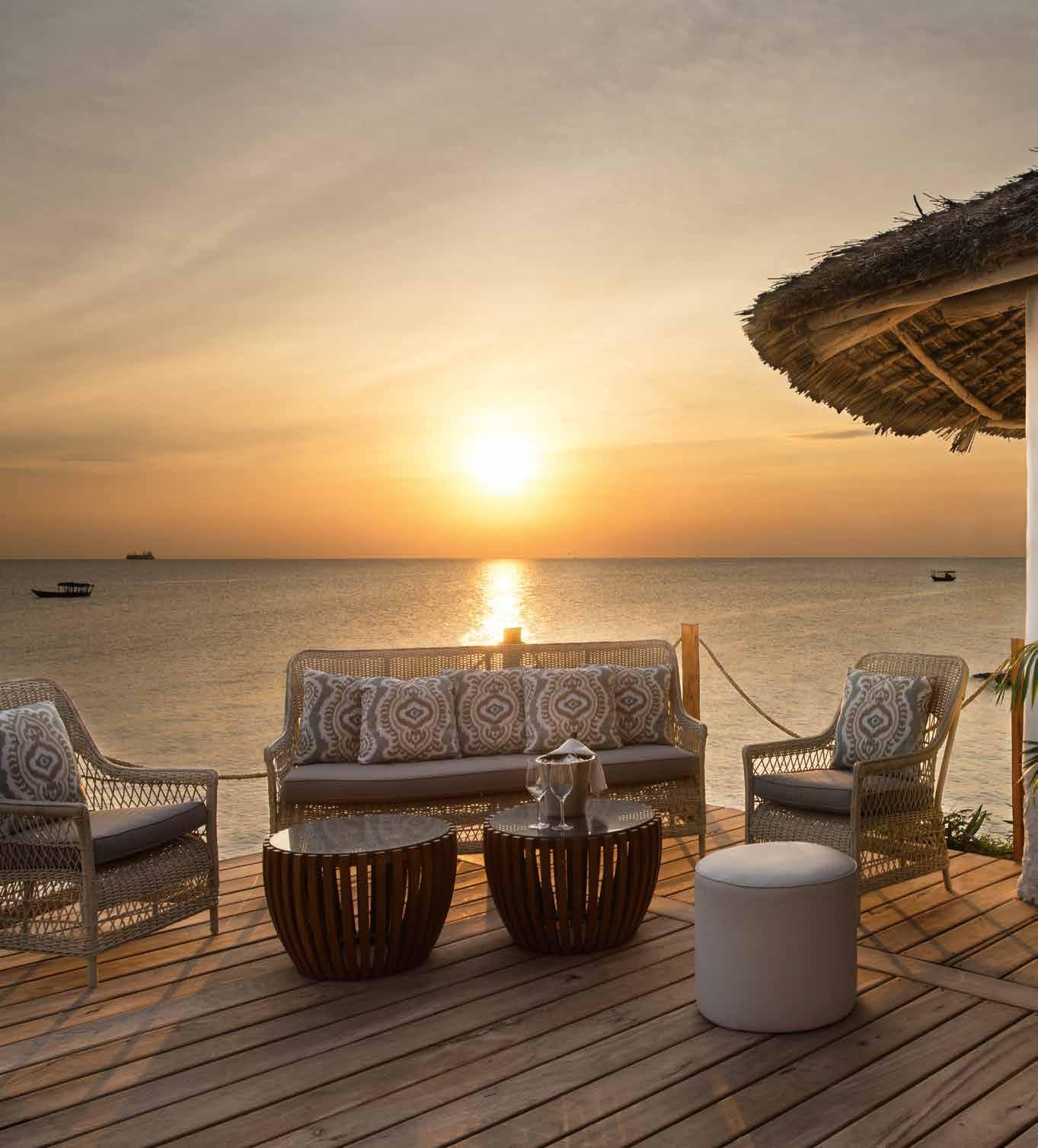
Follow The Sun
Visit Chuini Zanzibar Beach Lodge this winter for a sun-soaked escape
BY CANDICE GUEST
If the chilly season triggers your flight instinct, consider a getaway to the Tanzanian archipelago of Zanzibar. Also known as the Spice Islands, Zanzibar is a place of contrasts: its bustling capital, Stone Town, alive with historic landmarks, labyrinthine streets and air that’s thick with the heady scent of spices, and its coast dotted with sleepy fishing villages along white-sand beaches and the turquoise waters of the Indian Ocean. Here, on a secluded 1.5-hectare property edging Unguja Island, Chuini Zanzibar Beach Lodge is a sweet retreat for a much-needed hit of vitamin D.
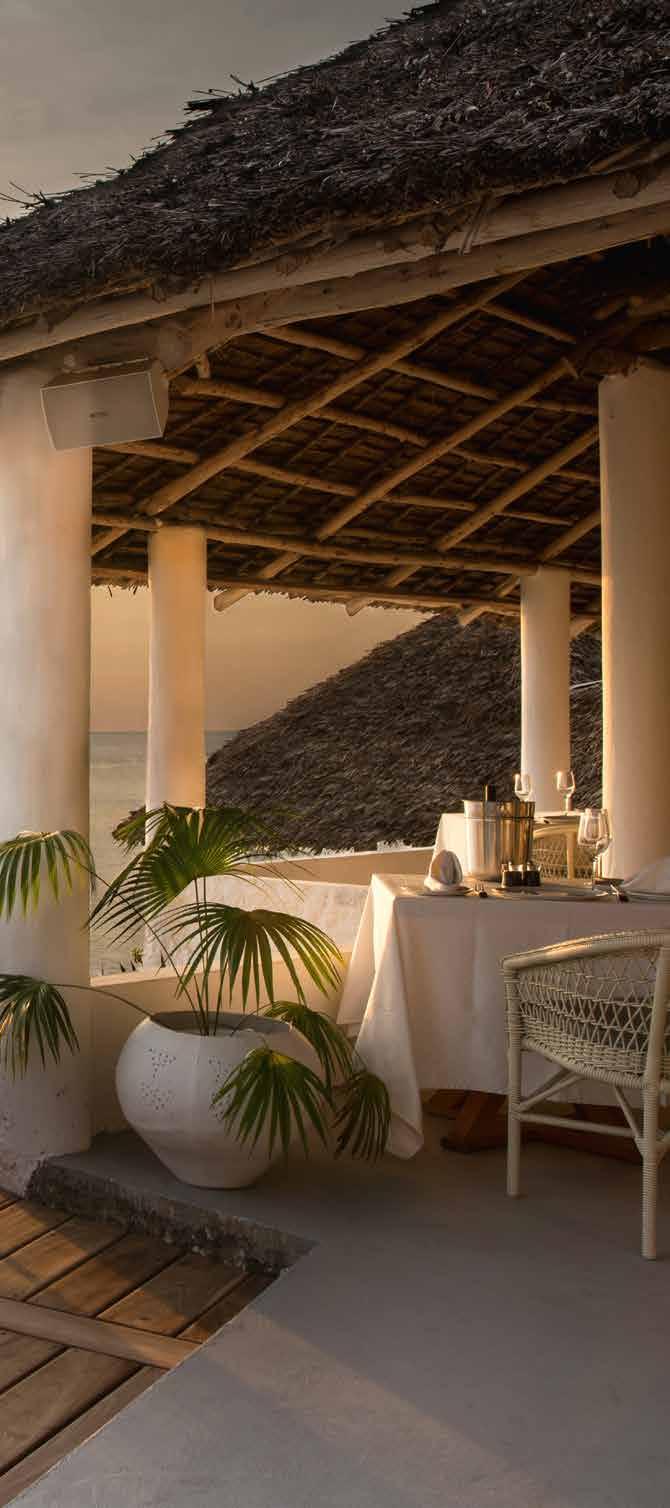
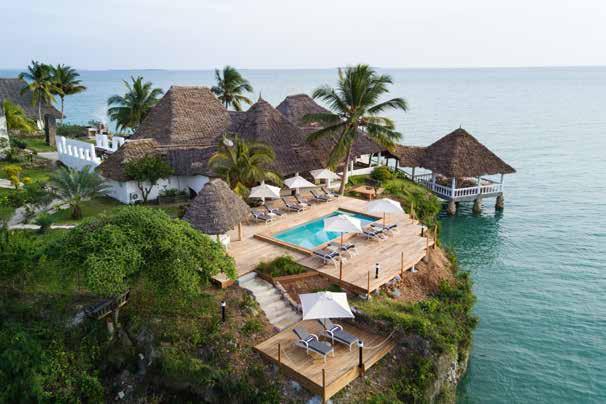
WHAT A LOCATION
Chuini is situated in a peaceful location on the west coast, 12km north of Stone Town. From the airport, visitors take a 30-minute drive to reach the lodge. Compared to other luxe hotels on the island – many of which can be a 90-minute drive away in heavy traffic – this alone could be a reason to stay. It does mean that you’re further from some of the island’s most popular beaches, such as Nungwi Beach and Paje Beach. However, with a setting such as this, off the beaten track and away from the crowds, many check in and simply stay put. The lodge’s grand wooden doors open in a wide welcome of true Swahili tradition. Its local architecture style boasts the ancient ruins of Chuini Palace, built for the Zanzibar Sultan, Sayyid Bargash, in 1873. The lodge is blessed with an abundance of lush greenery and natural shade, including tall coconut palms and hibiscus trees with their beautiful cup-shaped bright-red flowers. The air is perfumed with frangipani.
BEACHY MINIMALISM
The 13 thatched rooms and one villa are all stand-alone bungalows cooled by ceiling fans and air conditioners. The Deluxe Sea View Rooms, where we stayed, exude beachy minimalism and are just steps away from an idyllic, sunset-facing beach. You can catch a glimpse of the ocean from the room, but it’s the proximity to the shore that truly stands out. A level above, the Superior Rooms and Junior Suites are designed with privacy in mind. In the two-bedroom Villa with dramatic cliffside views, guests can expect even more space. Entry-level Deluxe Garden View Rooms also have a generous balcony. Regardless of the accommodation type, the interiors manage to feel spacious, stylish and right for the setting. And nothing adds a sense of place quite like the salty ocean breeze that ensues. Pale woods, hanging lights, natural woven grass rugs and cool cement floors decorate the whitewashed rooms and private terraces (the perfect spot to have your morning coffee).
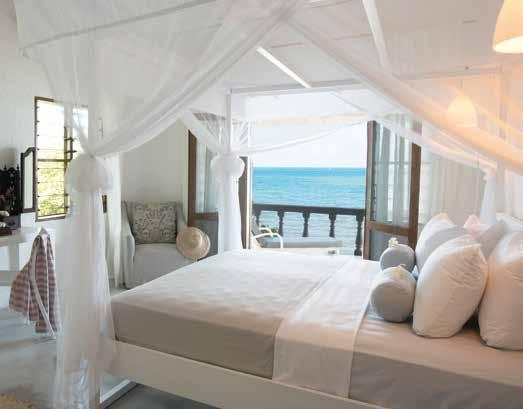

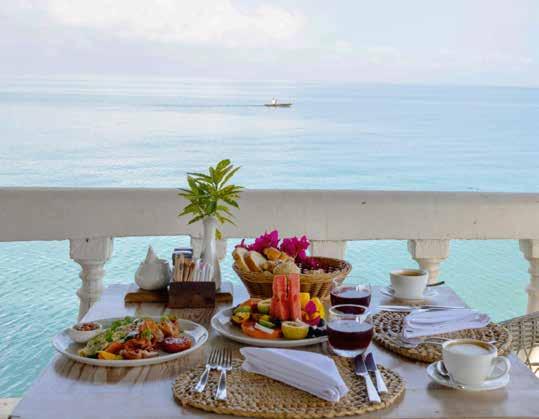
FOOD AND DRINK
Chuini has a reputation for delicious interpretations of local cuisine – the lodge offers flexible meal plans, including bed and breakfast, half-board and full-board. We recommend opting for the half-board option, which includes both breakfast and dinner. For lunch, the lodge’s à la carte menu offers a range of delicious options. With exceptional hospitality and everything you need on-site, you really don’t ever have to leave the property. The real star of a stay here is dining in an open-air dining room called Sea Breeze Restaurant & Bar, the main place to eat overlooking a private beach. Breakfast is a treat, especially the freshly squeezed ginger shots, tropical fruits and eggs Benedict pancakes. During the day –and on warm nights – tables are set outside, within eye line of white dhows on a blue ocean and earshot of lapping waves. The emphasis is on fresh seafood and produce, both of which are caught and grown on the island itself, while the wine list features some of South Africa’s finest wines. Popular dishes include tuna tartare, harissa fish tacos, seafood tagliatelle, octopus risotto, and a plate of fish and seafood tempura served with green papaya salad that we’re still thinking about. The dreamy courtyard, dripping with magenta bougainvillea and filled with birdsong, is a very lovely spot for a pre-dinner passionfruit paloma. Breakfast is served in-room for when you want to lie low the morning after sampling the bartender’s magic. For
dinner, order the seafood platter – a highlight of our stay – to feast on all-local lobster, jumbo prawns, octopus and calamari paired with lime butter, hand-cut chips and garden vegetables.
ACTIVITIES AND EXPERIENCES
At Chuini, some of the greatest pleasures are the simplest ones. Waking up at dawn and strolling along an empty beach, lounging alongside the infinity pool as the dhows drift by, watching local fishermen hauling up daily catches, soaking in the knee-trembling sunset views. This is the real beauty of Chiuni. While the shoreline is naturally rugged and coral-strewn, it adds to the area’s charm and authenticity. Guests can cool off in the lodge’s two outdoor pools, with colourful fishing boats resting on the sand, completing a picture-perfect African coastal scene.
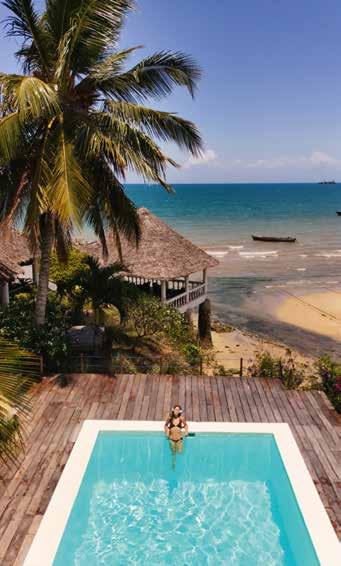
WHEN TO VISIT
The dry season from June to October is the most pleasant time to visit, with temperatures averaging 25°C and minimal rainfall. This period also coincides with Tanzania’s safari high season, making Zanzibar a popular post-safari destination. In contrast, the rainy season in April and May offers a quieter, more laid-back experience, ideal for travellers who enjoy a slower pace and the refreshed, cooler atmosphere that follows the hot East African summer. While some seasonal closures may occur, this time of year reveals a different, more tranquil side of the island.
SCAN TO BOOK
CHUINI ZANZIBAR BEACH LODGE




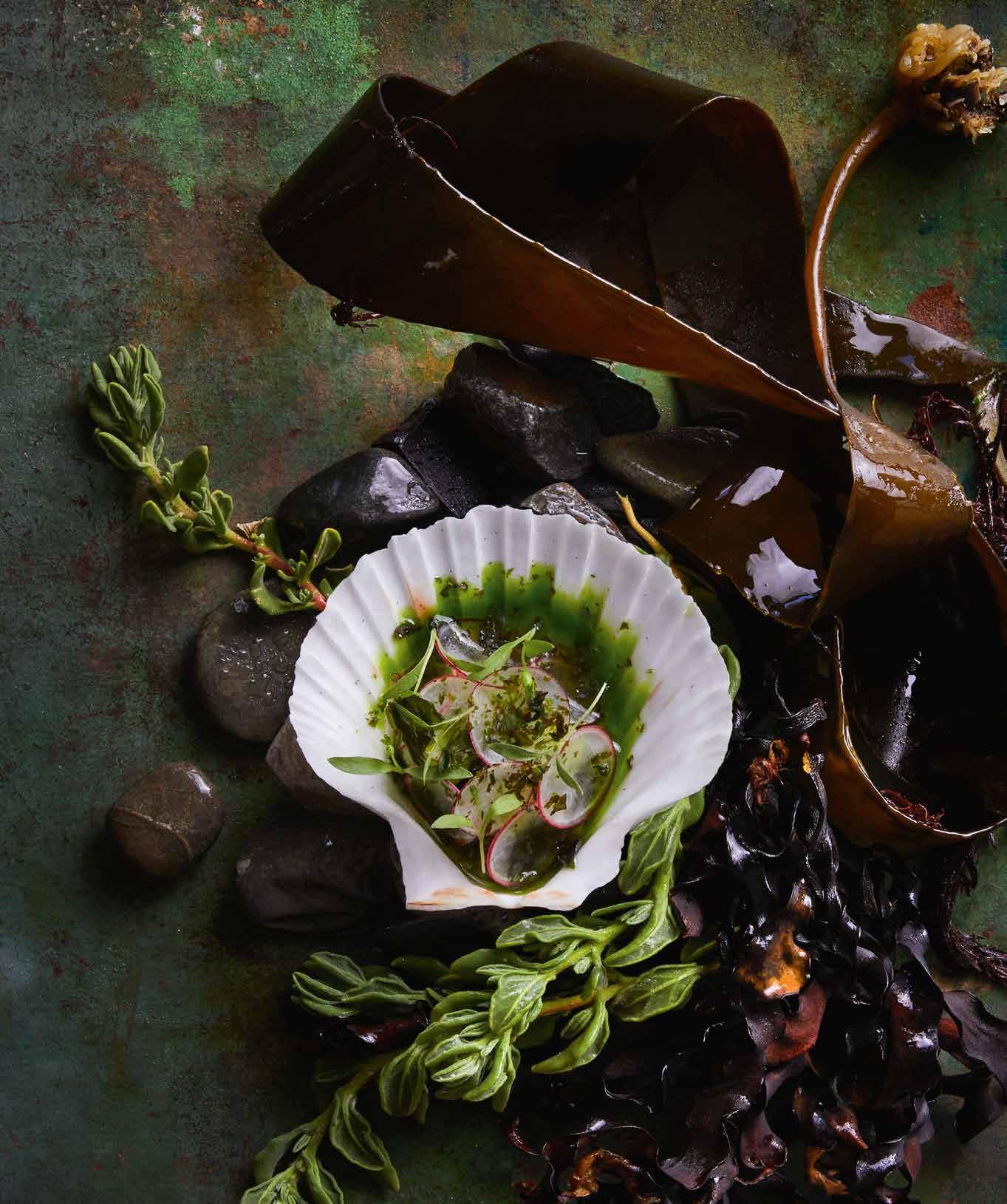
Laid-back
FINE DINING AT TERRARIUM
Newmark Hotels & Reserves Group Head Chef Chris Erasmus shares the vision behind this relaxed V&A Waterfront restaurant
BY PIPPA DE BRUYN
PHOTOGRAPHS BY MICKY HOYLE
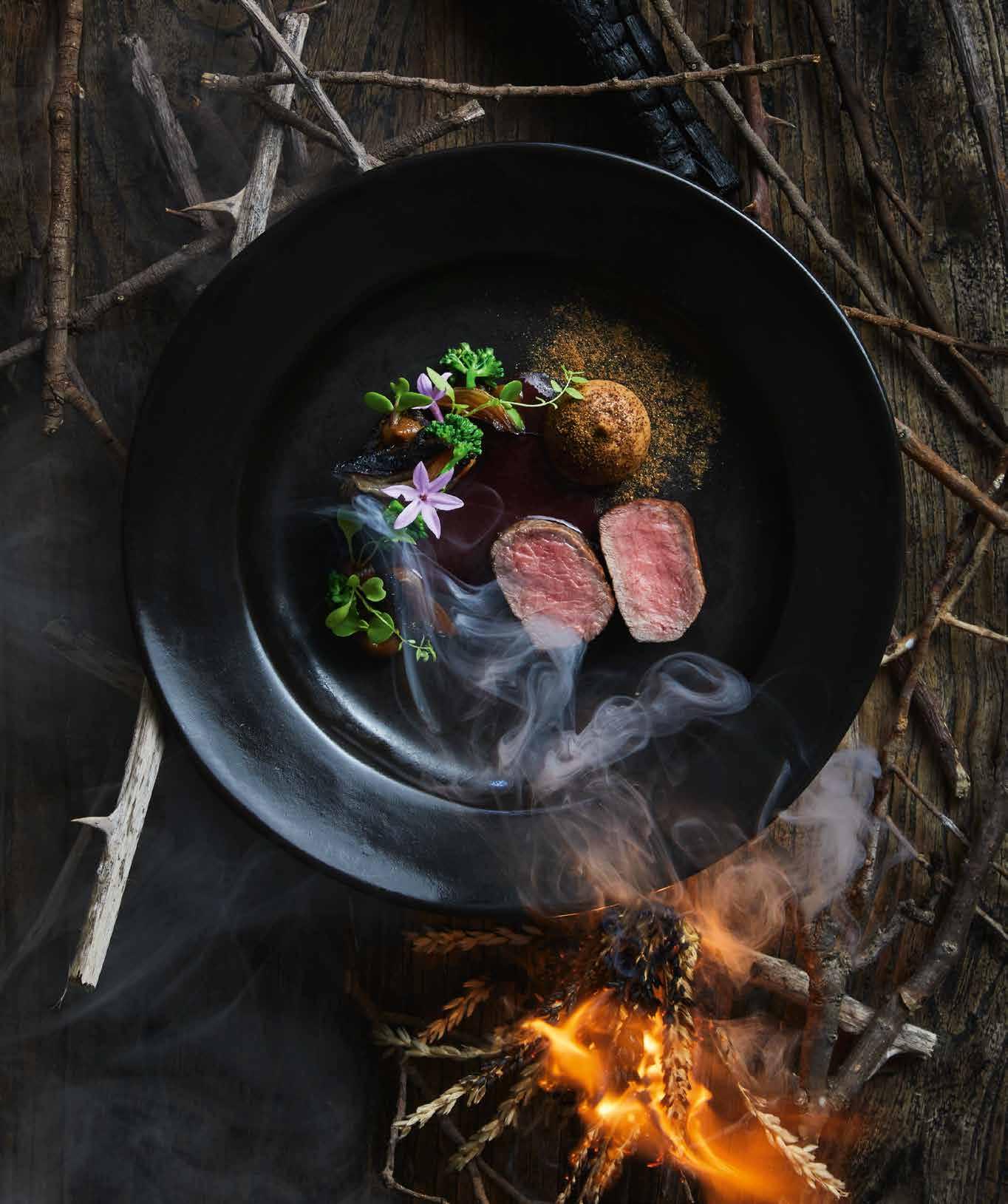
“I’d much rather eat here than La Colombe,” the foodie opposite me says. We’re seated at a spindly Gregor Jenkin table in Terrarium, the new fine-dining destination at the V&A Waterfront.
La Colombe is generally the Cape’s benchmark dining experience, certainly if the World’s 50 Best Restaurants voting panel is to be believed. “It’s quieter, more relaxed here. Less ostentatious. Yet still very interesting. It’s like sitting down for a personal dinner with a really great chef, serving dishes that impress but in the simplest way.”
We’re working our way through the two parallel eight-course tasting menus, given equal weight by their presentation on the table – Flora, rolled up in a hollow bamboo, is not only vegetarian but arguably the best plant-based fine dining to be had in the city. Fauna, rolled up in a marrow bone, is clearly the carnivore’s choice, albeit not exclusively meat. We have in fact both just wolfed down the tomato tartar: a medley of tomato varieties and preparations – pickled, chopped, infused – the culmination of which is a perfect distillation and celebration of this humble workhorse fruit. One of the most popular dishes on the menu, it’s sure to stay a signature. I suspect the kingklip – stained purpleblack by fermented blueberries, the inside tender white flesh –may be another.
Terrarium was launched by Group Head Chef Chris Erasmus and his handpicked head chef Anlou Erasmus (no relation) at the end of 2024. Surprisingly, it has not yet blipped the local awards radar. Not that this is primary to purpose. As Chris points out when we meet in the bar of the Queen Victoria Hotel, the convivial preprandial spot adjacent to Terrarium, “I don’t think we should judge food. At least, not like that. What about all the simpler places, places that have real soul? That’s more important than stars, or hats, or rosettes.”
FORAGED BEGINNINGS
One of four, raised by a single mom – “someone who knew how to make a little go a long way” – Chris learnt to forage before he could cook, starting with the vegetables in their back garden in Nylstroom. Later, when they moved to the Karoo, she took him into the semi-arid veld to search for edible and medicinal herbs, planting in her son a deep love for and abiding appreciation of the land: what grows at a particular
time, in a particular place; how to pick and preserve it. Superseasonal, hyper-local, nose-to-tail – almost clichés now, but the frugal Erasmus family lived this philosophy decades ago on the Karoo veld.
“Foraging has always been as much about mental health for me as it is about cooking. I pick mainly for myself, on privately owned land – it’s not fair to the forest to forage at scale. But it’s important for us to add some foraging elements to our menu. We also make regular foraging expeditions with the COOKtastic students [the NPO culinary training school Newmark Hotels & Reserves supports] to show them what’s out there, to encourage a conscious connection to nature, and what it provides.
THE ROAD TO TERRARIUM
Chris made his name as chef-owner of Foliage, the casual Franschhoek bistro he launched in 2014, and fondly refers to as somewhat of “a psychiatric institution, staffed by weirdos and outcasts”. By then he had done his time, working in the kitchens of the world’s best – in Pied à Terre in London; Per Se in USA; Olympe in Brazil; Ciel Bleu in Amsterdam; Ikarus in Salzburg; and Le Quartier Français and Pierneef à La Motte in Franschhoek. He spent a month at Noma in Copenhagen, learning why René Redzepi, the chef initially derided for his ground-breaking decision to work only with Nordic ingredients, has been voted number one five times by the World’s 50 Best judges.
At Foliage, Chris was vocal about the importance of cooking the bits that others would discard. It was great food, affordable, and I was one of those who every so often took the 90-minute drive from Cape Town to lunch at one of his tables. Neil Markovitz was another.
Neil – the visionary founder of Newmark, who opened the first Waterfront hotel in 1989, a very difficult time in South Africa – respected Chris’ food philosophy. He’d already asked him to consult in 2018; when he heard that Chris had been forced to close Foliage during Covid, he had a plan. “Most hoteliers are pretty shitty at running restaurants. They are stuck in a certain mentality that produces the fairly sterile ‘hotel restaurant’. I wanted a more unconventional approach, to turn it around. To have a restaurant that just so happens to be in a hotel.”
Opposite page, clockwise from top left: Beets – a vibrant small plate; Bone & Yeast from the Fauna menu; a bowl of Kingklip; Tomato tartar – a Flora small plate. Previous spread: Melon & Seaweed from the Flora menu; venison.
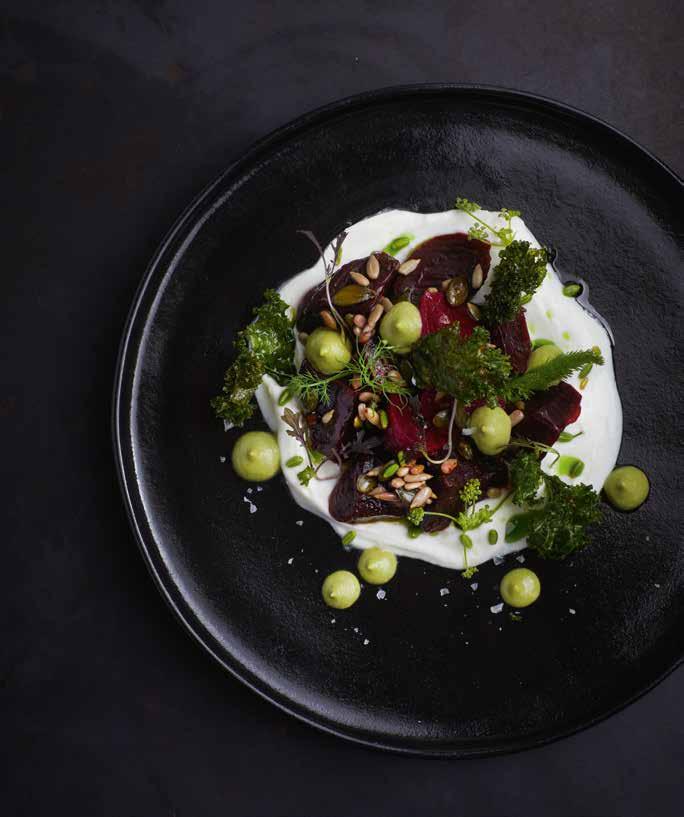
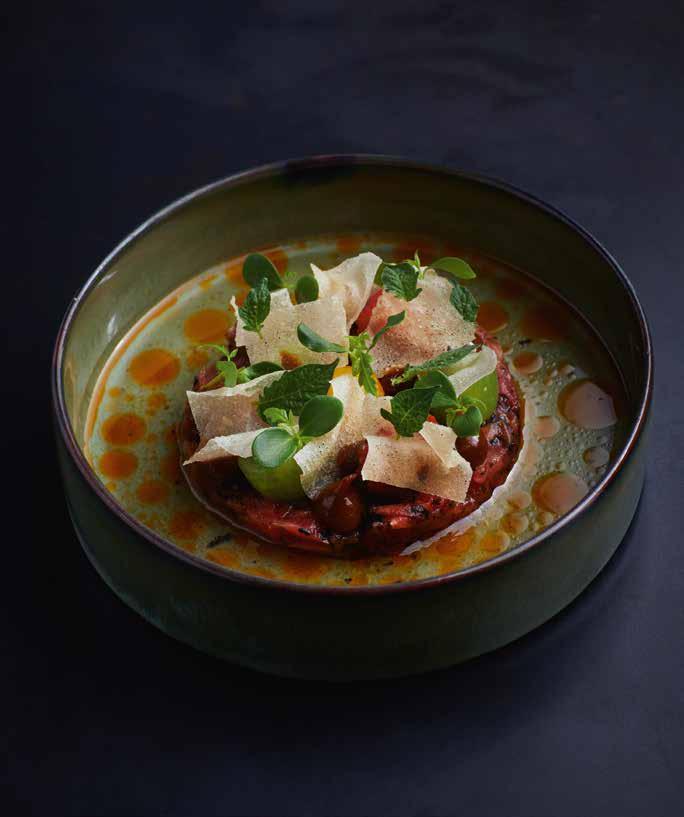

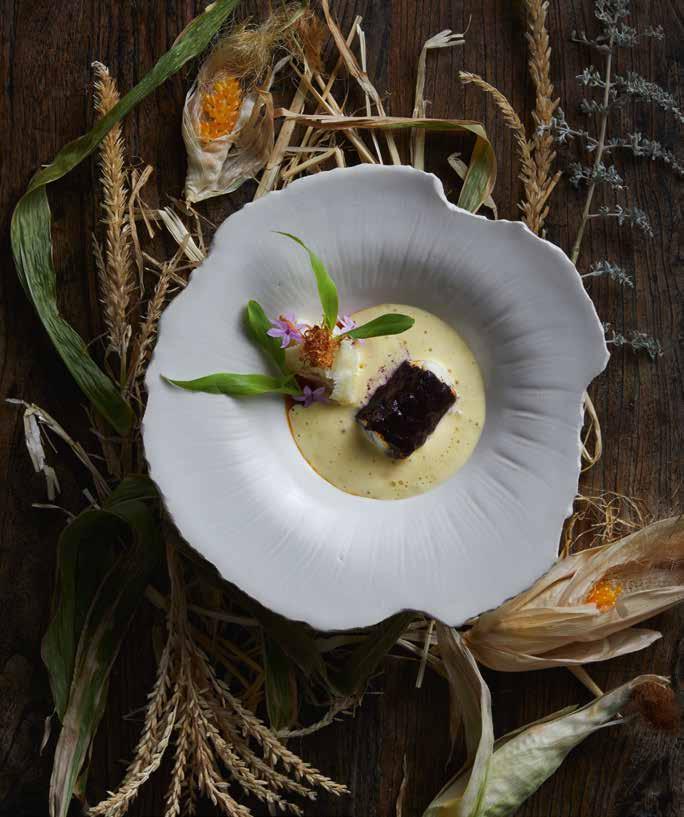
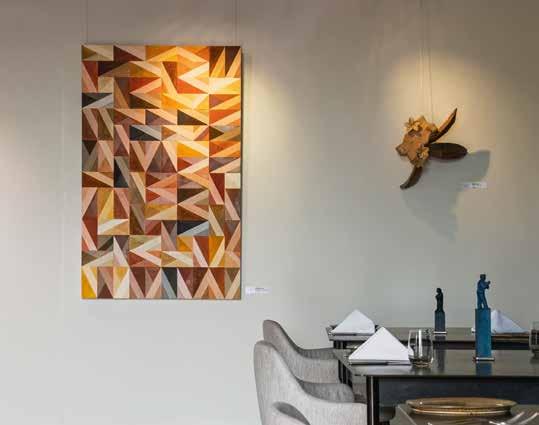
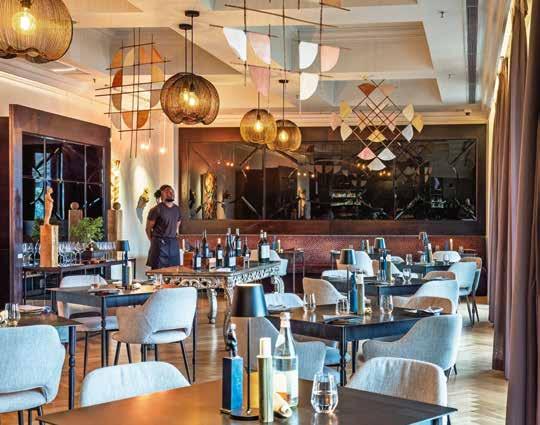
“IT’S LIKE SITTING DOWN FOR A PERSONAL DINNER WITH A REALLY GREAT CHEF, SERVING DISHES THAT IMPRESS BUT IN THE SIMPLEST WAY.”
CHANGING THE GAME
According to Chris, Neil literally pulled him over at a traffic light on a Thursday evening and invited him back to Queen Victoria Hotel, his flagship in the Waterfront, “to talk”. According to Neil, Chris agreed but initially declined a glass of wine. “But four bottles of wine later we were really getting into it! I told him, we have to work together. Chris is a non-conformist, a true creative, but also generous with his time and knowledge. Completely unpretentious, as much at ease skinning, butchering and cooking on an open fire in the bush as he is using his classical training to produce a plate that looks and tastes like art. And he really cares – where things come from, who we support and teach, what the overall aim is. Exactly what I wanted. I told him he would have free reign, that I wouldn’t clip his wings.”

Chris is sanguine about the challenge of working at the helm of some 20 properties with more than 40 chefs. “It’s an entirely new ball game for me. But I was hired to not only improve the dining experience but implement local sustainable processes that are still profitable. So wherever we have a property, we now involve local small-scale suppliers and growers. We’ve shifted our procurement from running a few accounts with one-stop companies with overseas bank accounts to hundreds of small suppliers, local to each hotel or lodge. The accountants don’t love me but I tell them we can
all sleep better at night knowing we are buying from local familyowned businesses who can pay school fees and mortgages, thanks to our support.” Kudos to this ethos, because at R795 for the Flora and R1095 for the Fauna, Terrarium also offers exceptional value to the diner.
THE A TEAM
For Anlou – who too has fine-dining form, having spent time in some of the top kitchens in the Cape (including, incidentally, a four-year stint as sous chef at La Colombe) – collaborating with Chris was the perfect culmination of a relationship that started when Chris took him out foraging for mushrooms in the Boschendal estate nine years ago.
“When Chris asked me if I wanted to open a restaurant with him, I was like, ‘Hell yeah, let’s do it!’ Together we worked on devising a really laid-back fine-dining experience. I like technical expertise, great presentation, but I’m over the ‘poshness’ associated with most fine dining. Chris and I both wanted people to experience something special but without the need to dress up, or feel overwhelmed in an eating marathon.”
These things are, of course, relative. If what you want are theatrics, a name to drop, a phalanx of waitstaff spouting long explanations, this is perhaps not for you. But any foodie worth their salt should book a table here, if only to join the ranks of those who will casually say, “Oh yes, Terrarium. We loved going there, before it became impossible to get a table.”
A terrarium is a self-sustaining ecosystem – both the meaning behind the restaurant’s name and its approach to food. Opposite page: Enjoy the welcoming atmosphere of the
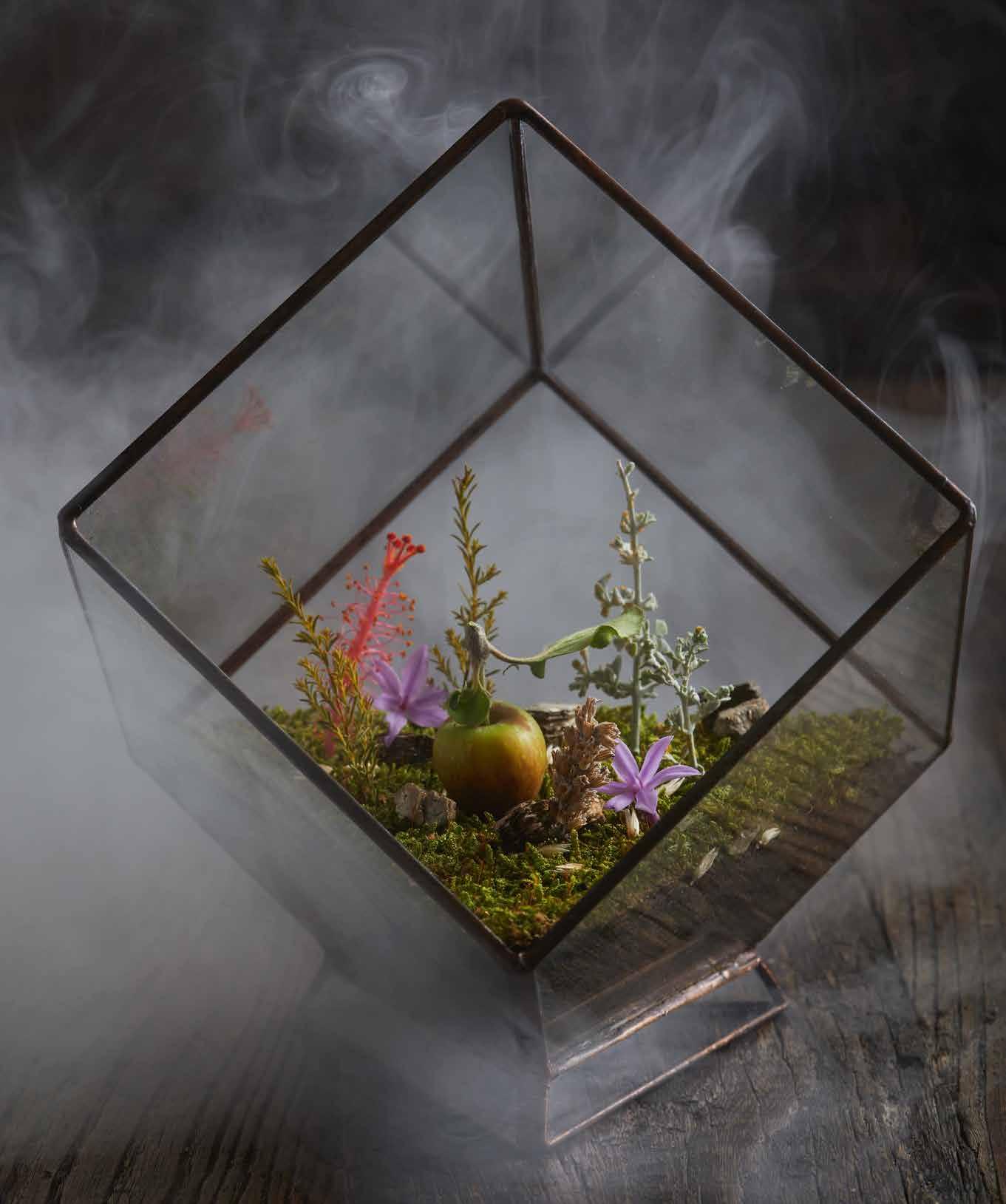
restaurant at the Queen Victoria Hotel.
A POSTCARD PARADISE
A stay at Mystic Lifestyle Boutique Hotel is balm for the soul
BY JUSTYN SPINNER
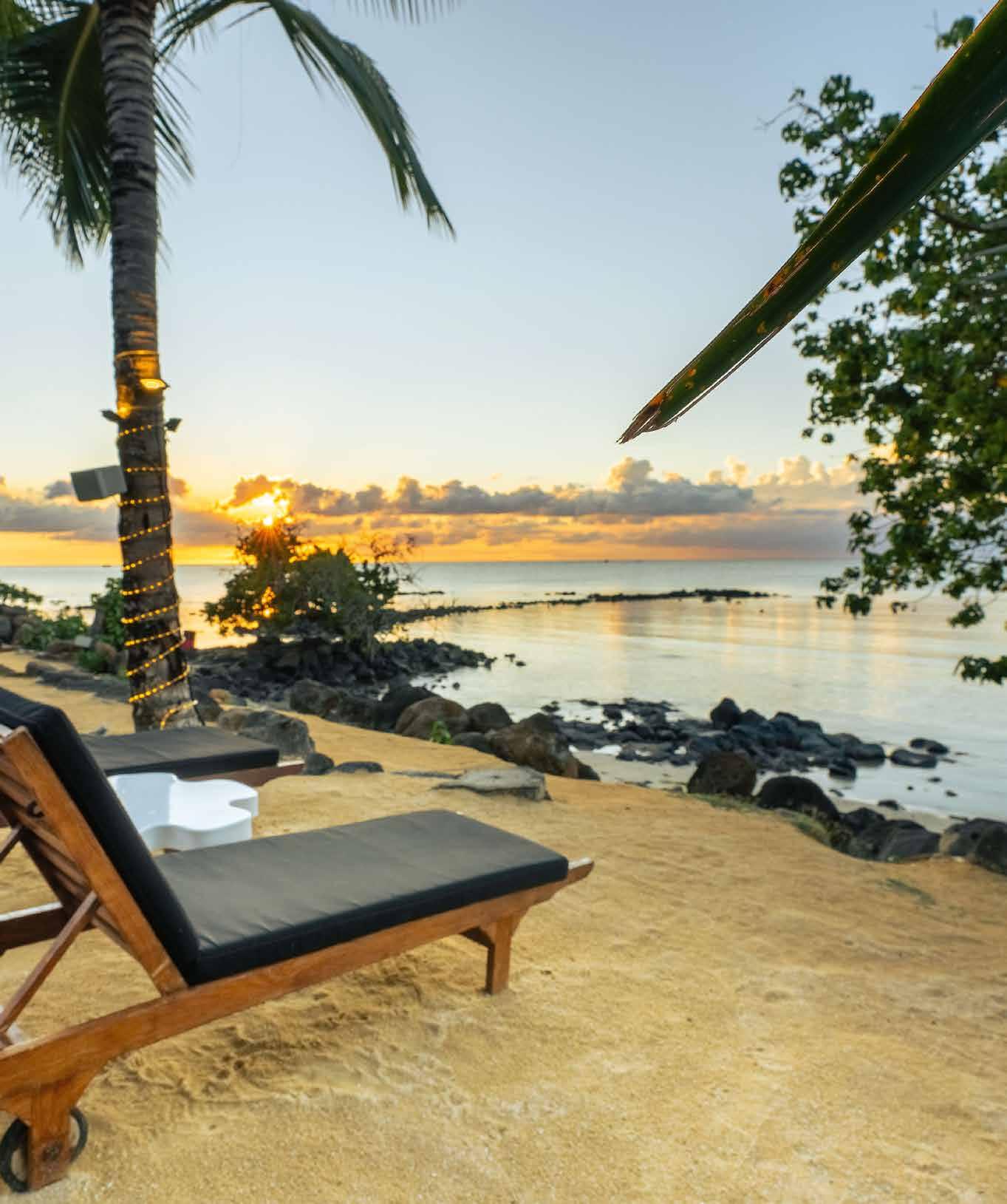
Nestled on the northwest coast of Mauritius, where the sands of Mont Choisy Beach dissolve into the azure of the Indian Ocean, Mystik Lifestyle Boutique Hotel embodies the spirit of the island. It encourages you to slow down, sense the rhythm of the tropics in the sway of the palm leaves and pass the time watching the hours tick by in the pinks and oranges of the horizon.
From the minute you arrive, you’re struck by the fact that this isn’t just another mega-resort calling for your attention. Instead, Mystik opts for the subtle: clean, white architecture punctuated by vivid splashes of colour; relaxed staff with a memory for names, and a view that appears as if it were built for postcards. Check-in happens to the sound of the waves, with a welcome drink in hand and toes almost touching the sand.
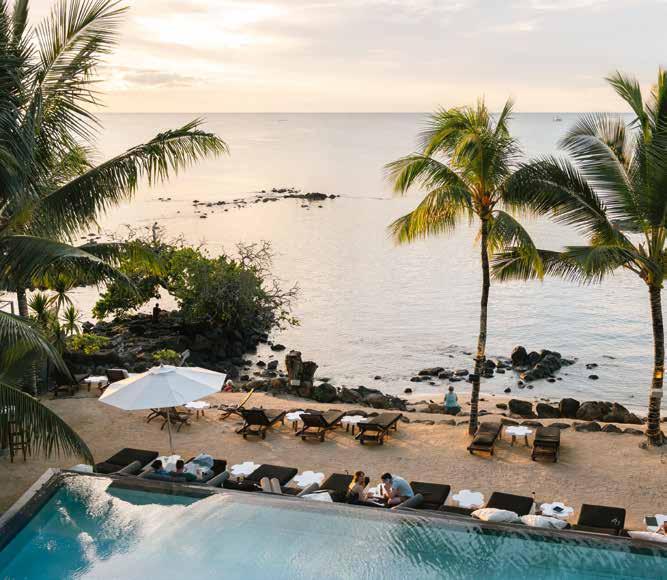
SERENE SANCTUARY
One of Mystik’s best features is its location – secluded enough to be peaceful, but close enough to the action in Grand Baie to experience Mauritian culture at any time. Quick and easy to reach from Sir Seewoosagur Ramgoolam International Airport (about an hour by car) and a mere 12km from the lively coffeehouses, boutiques, and nocturnal activities of Grand Baie, the hotel becomes a vibrant oasis for its guests. A short 10-minute drive delivers guests to the centre of the village, where markets overflow with spices and textiles, and local eateries dish out fragrant curries and fresh roti beneath plastic awnings.
WHAT MAKES MYSTIK SPECIAL
Unlike larger resorts that serve the masses, Mystik was made for connection – with others, with nature, with oneself. This is a boutique hotel that promotes reflection and relaxation. Its intimate proportions provide a sense of warmth and closeness between visitors and staff, and the design, service, and focus on food convey a polished experience. There’s no spa, no kids’ club, and no sprawling buffet. And that’s the point. Mystik isn’t trying to be all things to all people – it’s aiming for the perfect fit for the kind of traveller who seeks space, style, and authenticity. Whether it’s a romantic getaway, a solitary reset, or a trip with friends, the experience stays with you long after the flight back home.
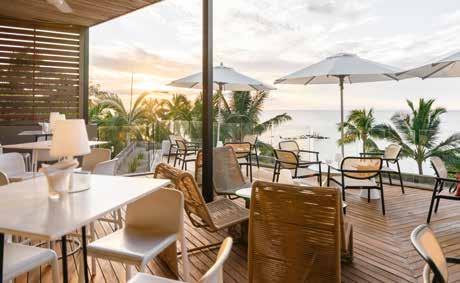
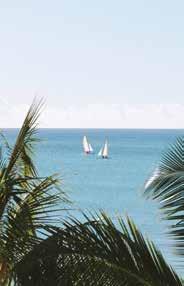
ISLAND COMFORT
Mystik’s rooms reflect the island’s carefree, relaxed vibe – light, bright, and breezy. There’s a deliberate simplicity to the design: crisp white linens, pops of tropical colour in art and scatter cushions, and sliding glass doors that lead out to private balconies. Each space feels crisp and modern but also anchored, a place that’s not trying too hard in any way. It’s island comfort without all the bells and whistles. The true luxury here is the view, the ocean breeze, and the ease of privacy.
ADVENTURES AROUND TOWN
NOT A RESORT, BUT A RETREAT – WHERE SIMPLICITY IS THE REAL LUXURY.
Though Mystik itself is less resort than retreat – there are no jarring water sports or obtrusive animations on the premises – it makes an ideal jumping-off point for discovery. A few steps away, Mont Choisy Beach boasts soft white sand and placid waters, setting the stage for windsurfing and kayaking, as well as more adventurous endeavours like scuba diving and deep-sea fishing. Operators are arranged along the beachfront, and day trips can be booked at the last minute.
Mont Choisy Le Golf, designed by Peter Matkovich, a former professional golfer, is an 18-hole course offering picturesque play just a five-minute drive away. With broad fairways, volcanic formations, and views over the coastline, it’s an inviting experience for all levels of players.
For nature and hiking enthusiasts, Mauritius also does not disappoint – local guides offer hikes in the island’s lush interior. Whether you want a meditative walk or a mountain summit, there’s something to fit the bill at every pace.
The hotel can also organise customised experiences for guests seeking to delve a bit deeper into Mauritian culture, including visits to historical sites and artisan workshops that illuminate the island’s heady history.
A MATCH MADE IN… MAURITIUS

The boutique hotel is the perfect spot for couples and the romantic Sunset Indulgence package shouldn’t be missed. Catering to couples looking for a unique getaway, the two-night special comes with a complimentary room upgrade (based on availability). One of the most charming added touches is the personalised cocktail-making class at the rooftop SkyBar. When the sun sinks beneath the horizon and shimmers it with gold, couples are encouraged to shake, stir, and sip their own creations as they indulge in this idyllic paradise.
FINDING YOUR PEACE
Whatever your goals for your stay at Mystik, you’ll hit your stride at this boutique hotel. Mornings are started with barefoot sand strolls, afternoons blend into the soundtrack of the sea and nights are spent under star-strewn skies, cocktail in hand. Mauritius is famous for its beauty, but for Mystik that beauty is personal.
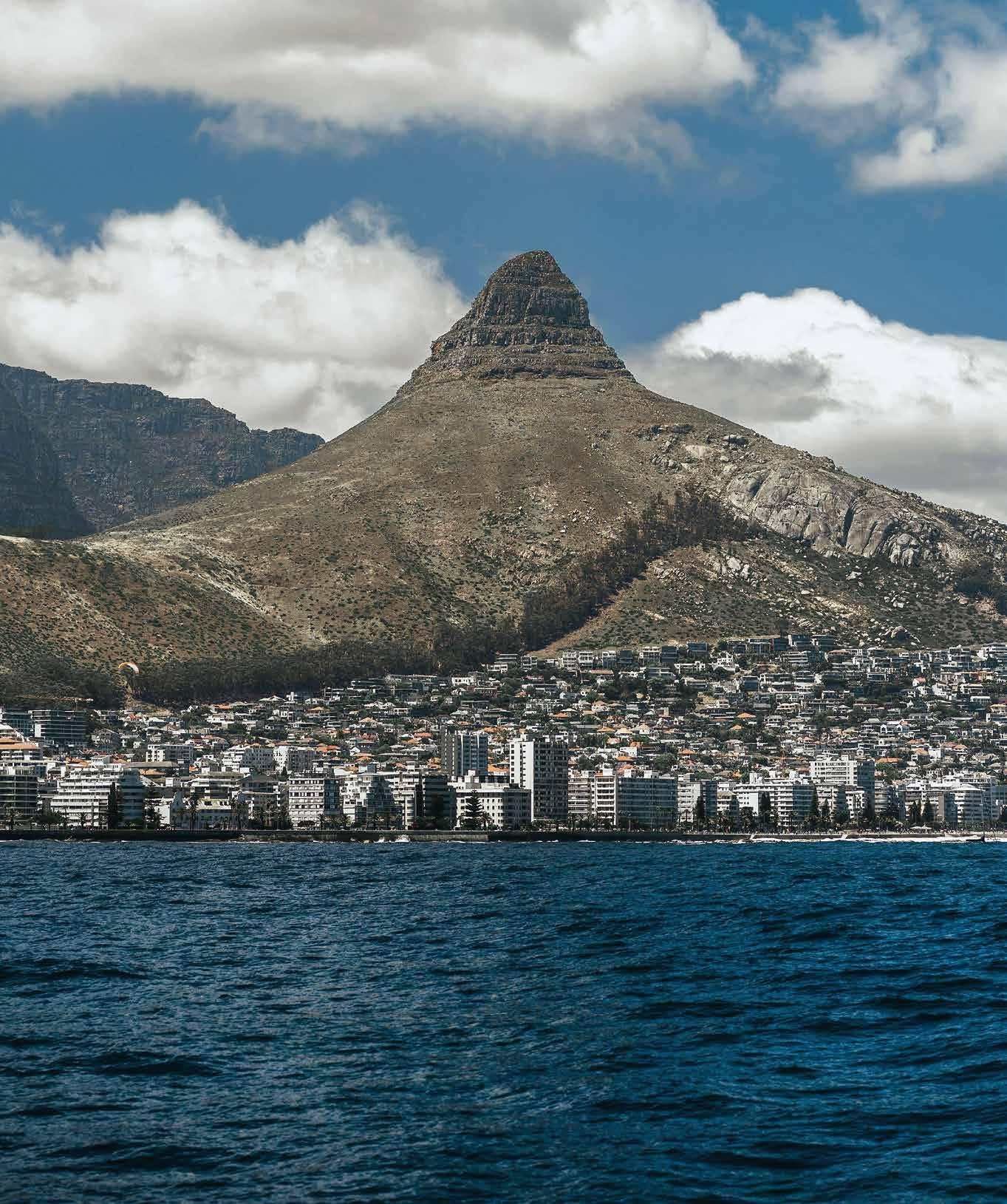
From Dawn To Duskies
A Cape Town stay where the wild ocean meets the city
BY ANDREW THOMPSON
Explore the bay minutes from your base at La Splendida. Opposite page: Suited up and safety-checked, fingers crossed you’ll be paddling with dolphins at dusk.
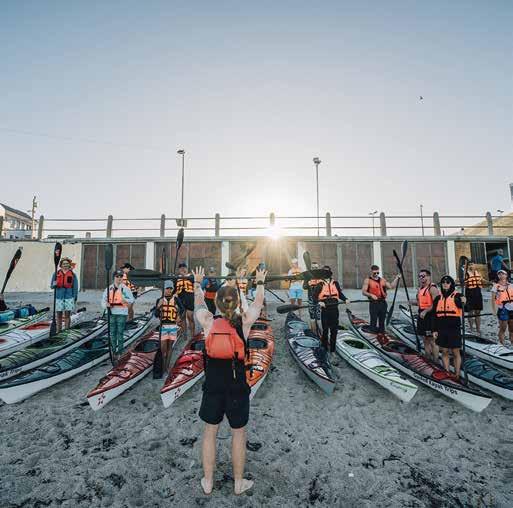
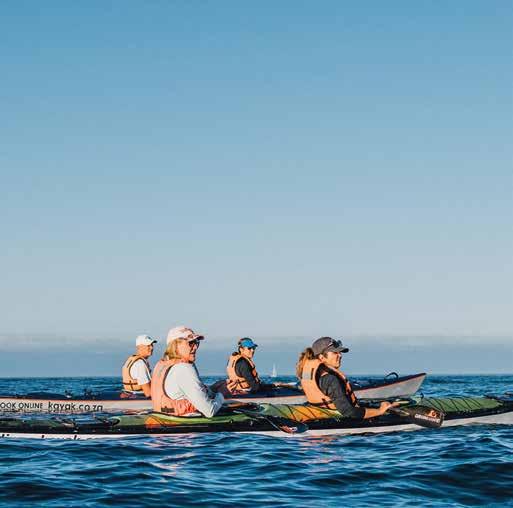
There are few better ways to start your day in Cape Town than with a coffee in hand, barefoot on the balcony of your room at La Splendida, eyes trained on the shimmering blue curve of the Atlantic as it awakens with the golden sunrise.
From certain rooms in this compact hotel on Mouille Point’s waterfront strip, the view stretches across the ocean like a living canvas, shifting with wind and tide, just out of reach – until you paddle out to meet it. And if you look closely, it’s not unusual to spot the quicksilver flash of dolphins slicing through the waves just beyond the iconic red and white lighthouse.
What many travellers don’t realise is that the coastal waters outside La Splendida are among the more active dolphin corridors on the Cape Peninsula. The dolphins most often spotted here are dusky dolphins, known for their acrobatic leaps, playful slinking, and the easy elegance with which they move through the swells. Compact, curious, and full of character, they’re smaller but no less thrilling than the more familiar bottlenose, with distinctive two-tone flanks and a reputation for showmanship. These dusky dolphins tend to move in groups, sometimes dozens strong, and favour cooler, nutrient-rich waters like those along the Atlantic Seaboard. Here, the upwelling from
the Benguela Current provides a marine pantry of sardines, anchovies and small schooling fish. This abundance attracts dolphins throughout the year, and their proximity to the coastline makes this stretch of Cape Town an excellent place for sightings – particularly for those willing to venture beyond the paved Promenade above the rocky shoreline.
This is why it’s worth drinking that balcony coffee, gearing up, and heading out before breakfast. Just a short walk from La Splendida is Cape Kayak Adventures, which offers guided sea kayaking trips that provide an opportunity to experience this marine life up close. The company has been paddling these waters for over 30 years and offers one of the more engaging and environmentally low-impact ways to explore the Atlantic: from sea level, with paddle in hand.
Cape Kayak Adventures’ small group tours run daily when the weather cooperates and don’t require prior experience or any grand levels of fitness. The guides, as knowledgeable as they are passionate and safety conscious, offer both a primer on sea kayaking and insight into the marine ecosystem. And from the comfort of a stable double kayak, the route hugs the coastline past the lighthouse visible from La Splendida and into deeper water, where wildlife sightings are more likely.
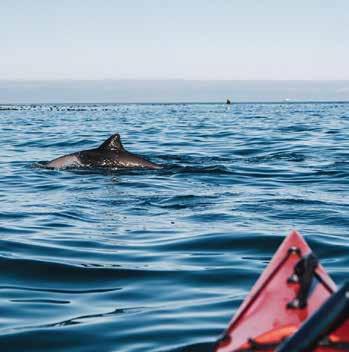
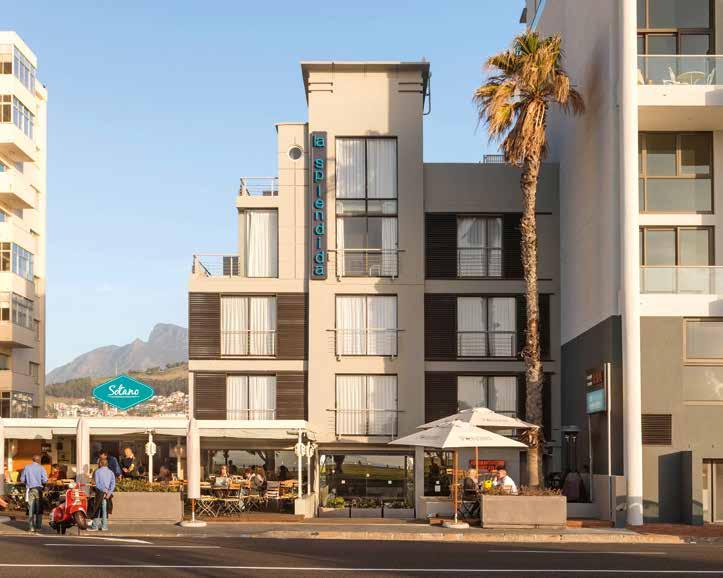
THE DOLPHINS YOU MIGHT GLIMPSE FROM YOUR WINDOW IN THE MORNING COULD VERY WELL BE THE SAME ONES KEEPING PACE WITH YOUR KAYAK LATER THAT DAY.
While no wildlife encounter is guaranteed, dusky dolphins are frequent visitors and surprisingly comfortable around humans, often appearing silently and without warning: racing alongside the kayaks, ducking beneath the bows and reappearing with almost intentionally surprising bursts of air. For the lucky who get out early, some might launch into aerial displays above the water.
However it happens, the experience of spotting dolphins from this perspective is exhilarating and humbling, and a memory likely to outlast many others acquired during your visit to the Cape.
Afterwards, it’s a relaxed stroll back to La Splendida, where you can regroup and pore over blurry dolphin photos over brunch at Sotano – the ground-floor restaurant with outdoor tables that spill onto the pavement. Its Mediterranean-style menu and laidback atmosphere make it a reliable spot to linger with a postpaddle drink while watching the ebb and flow of activity along the popular Promenade.
On sunny days, the tables fill quickly with a mix of hotel guests, dog walkers, cyclists and Mouille Point regulars who’ve come to sip spritzes and share tapas under the palms. And while it’s a great brunch and lunch spot, it’s just as lively in the evenings, when the sea breeze cools the strip, and the sunset draws a quiet crowd.
If you’ve timed it right, it’s a good place to raise a glass – not just to the view, but to the dolphins who may have passed by earlier that morning.
La Splendida, upstairs, also holds a unique claim to fame: it’s the only true hotel on Mouille Point’s iconic seaside stretch. While the surrounding area has seen a boom in upmarket apartments and short-stay rentals, La Splendida has remained
a classic. It has become a part of the neighbourhood’s identity for locals and visitors alike – and for those who stay there, it provides a unique offering.
The hotel has just 24 rooms – all modern and bright – with floor-to-ceiling windows that frame views of the sea, the mountain, or the lush park and golf course. Rooms facing the ocean are especially appealing at the bookends of the day, and in the hour before sunset, the water often turns gold as the clouds cycle through shades of pink and mauve, giving way to dusk as the lighthouse beam begins its slow sweep across the bay.
For couples, it’s a romantic base with chilled walking options and low-key activities, like carefree bicycle rides. For solo travellers or small groups, accessibility and the hotel’s comfortable atmosphere make it a practical choice close enough to the action without being swept up in it.
What sets La Splendida apart, though, is the direct connection to the golden mile on the Mouille Point beachfront and the ocean just beyond, with its captivating, often-overlooked marine life. The dolphins you might glimpse from your window in the morning could very well be the same ones keeping pace with your kayak later that day.
This slice of Cape Town offers a rare combination: an urban address with a strong sense of nature just offshore – and for travellers seeking a balance of city energy and ocean calm, La Splendida makes a quietly compelling case.

SCAN TO BOOK LA SPLENDIDA
Above: Grab breakfast at Sotano at La Splendida before your early-morning paddle.

A SENSE OF ADVENTURE

Whatever your destination, make sure you’re prepared
CHOPARD
Mille Miglia Classic Chronograph

BEN GRIB
This watch is clearly intended for drivers seeking to surpass themselves: competitive spirit and sense of camaraderie; energy and dynamism; speed and style. It epitomises Italy’s celebrated 1000 Miglia Italian classic car race that Chopard has been annually expressing for the past 35 years through the watches of the Mille Miglia collection. The new 2025 model is no exception to this philosophy.
POA
bhhboutique.co.za
@BHH_Boutique +27 11 669 0790
South African National Park
Badges
Consider yourself a bit of an explorer? Check out local nature illustrator Ben Grib’s badges of all 20 South African national parks. From forests to deserts, oceans to mountain tops, visit them all and tick them off as you go along. Bonus quest: If you can prove that you have visited them all, he’ll give you a poster for free!
Challenge accepted.
R699
bengrib.co.za @ben.grib

FROM HIGHVELD TRAILS TO COASTAL DRIVES AND COFFEE STOPS ALONG THE WAY, EVERY ADVENTURE CALLS FOR GEAR THAT’S
AS READY AS YOU ARE.
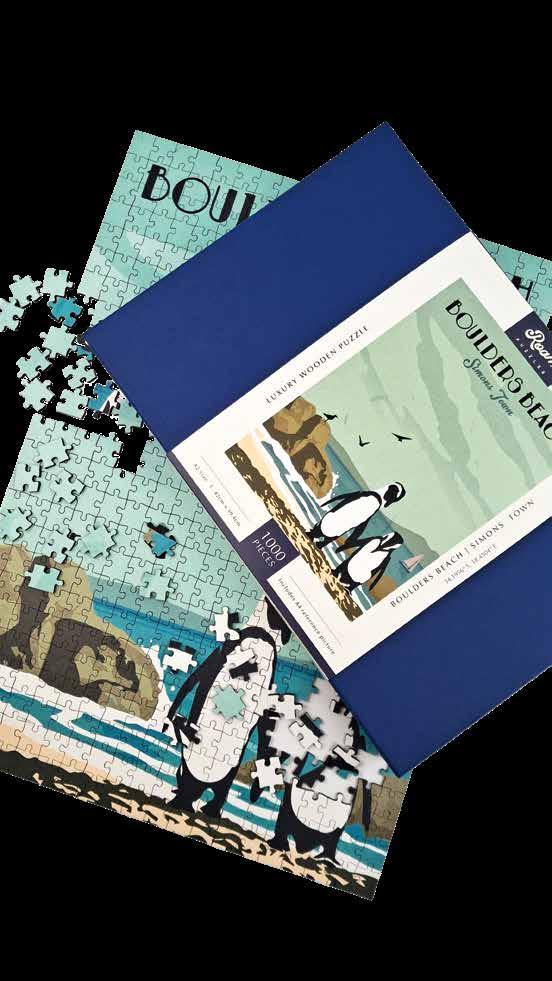

Wood Puzzle
Stop scrolling and start puzzling. Roam travel posters celebrate the country’s most iconic places through their vintage-style illustrations now reimagined as premium wooden puzzles. The Roam Boulders Beach puzzle showcases a beautifully illustrated scene of the beloved African Penguin-filled beach. Available in 500, 1000, or 2000 pieces. Get cracking.
R749 roamposters.co.za @roam_travelposterco


ORIAL
Insulated Flask
Stay hydrated in style. The 946ml Orial Commute 2.0 is a double-walled insulated flask with airtight seal that ensures contents stay hot or cold for 12 hours. Don’t get lost in the bush without it.
R519 orialoutdoor.co.za @orialoutdoor
TUDOR
Black Bay 58
A classic timepiece named after the first-ever TUDOR dive watch in 1958. Known as the “Big Crown” among collectors, the design of the Black Bay 58 makes aesthetic references to this historic model. This year, a METAS Master Chronometercertified burgundy execution joins the family.
R87 300 tanur.co.za @tanur_collection

Ponchini
Cool evenings on the veld? A locally handmade mohair ‘ponchini’ is what you’re looking for. This style of poncho is knitted with extra-fine and boucle (unbrushed) mohair yarn, which gives it a textured corduroy look. Elegant, warm and lightweight, it will enhance any outfit for any occasion.
R699 mohairmillshop.com @themohairmillshop

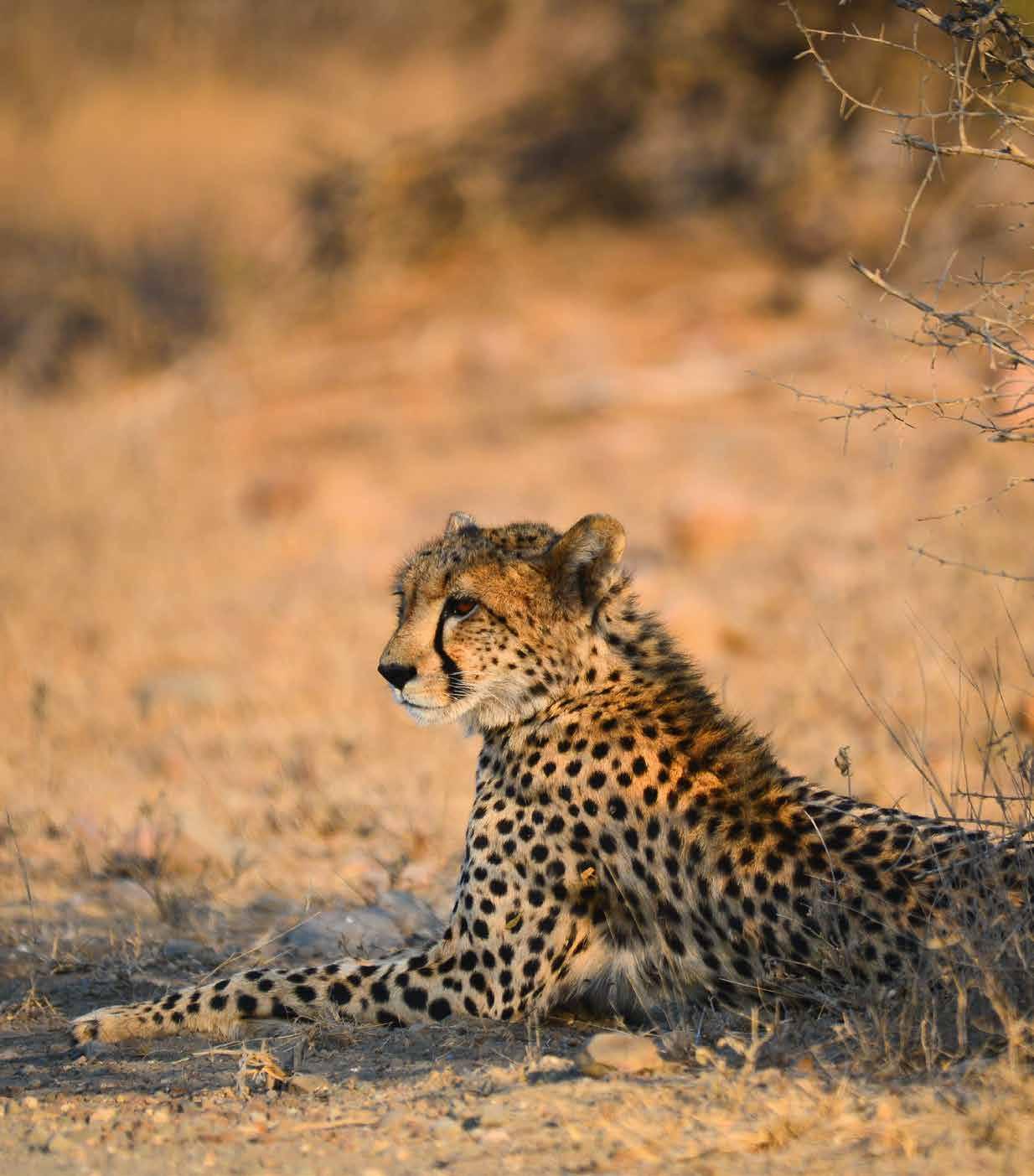
Winter Is Wild In The Bush
Enjoy a contemporary adventure in an ancient landscape at Nkomazi Private Game Reserve
BY RICHARD HOLMES
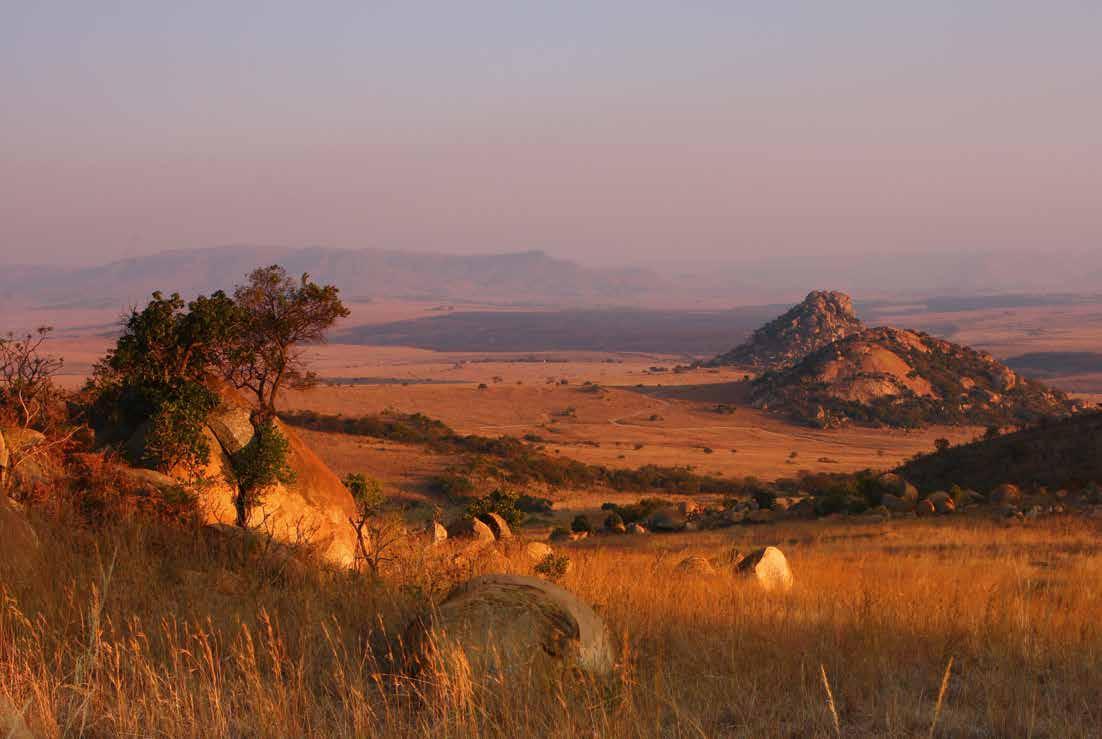
It’s winter in South Africa’s eastern province of Mpumalanga and the sunrise throws a golden hue across the grasslands of Nkomazi Private Game Reserve.
It’s been months since the summer rains fell, yet this remarkable reserve is lush. Valleys of green thicket frame the vast, open plains, and animals descend on the waterholes that flow throughout the year. In the deepest valley, the clear waters of the Komati River rush onwards to the Indian Ocean. It’s the most magical time of the year on the reserve.
While many safari travellers flock to the Lowveld region (which includes the iconic Kruger National Park and Motswari Private Game Reserve) in the summer months, drawn by the migrant birds and balmy days spent at the pool, those who’ve been on safari a few times will always tell you: winter is best.
And that is certainly the case in Mpumalanga, where grassy plains stretch towards a horizon of ancient mountains that rise in rugged silhouettes. At Nkomazi Private Game Reserve, winter is both the dry season and a time of stark beauty and striking clarity: the air is clear and crisp, and alchemy transforms emerald grassland into a sea of honeyed gold.
“Nkomazi means ‘the place of water’, and even in the dry season, we have a lot of natural springs – and the Komati River running through the reserve – which means the environment
stays greener than you’d expect,” explains Derek McBride, assistant head guide for the 15 000-hectare reserve.
What surprises many first-time safari travellers is that winter is actually often the best time of the year for game viewing.
“In the winter months, with the grass thinning out, you get these wide, open views,” says Derek. “You can see the animals more easily, and the plains take on this beautiful, flowing look when the wind moves through the golden grasses.”
Framing the reserve is the outline of the Makhonjwa Mountains, which form part of the Barberton Greenstone Belt, one of South Africa’s 12 UNESCO World Heritage Sites.
While to the untrained gaze the mountain range is little more than an eye-catching rocky ridge, the Barberton Greenstone Belt is a marvel of geology. It is one of the world’s oldest geological formations, dating back over 3.5 billion years, and preserves some of the earliest evidence of life on Earth.
These ancient hills also hide ancient artworks, and hikes to San rock art sites offer a cultural immersion in step with Nkomazi’s wildlife experience.
“The paintings are tucked away in the hills, and at one of the sites, you can even see old spearheads and grinding stones,” explains Derek. “It’s a bit of a hike but incredibly rewarding.”
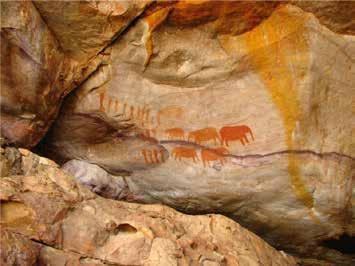
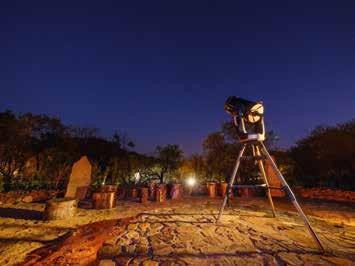
STARGAZING AT NKOMAZI IS SPECTACULAR IN WINTER, WITH CLEAR SKIES AND NO LIGHT POLLUTION.
While this timeless landscape of lustrous chromatite koppies offers a glorious backdrop to the reserve, it’s the wildlife that brings most guests to Nkomazi. These lush grasslands support healthy populations of zebra, wildebeest, red hartebeest, eland, and blesbok, with the herds gathering in large numbers on the open plains. The reserve is also home to the Big Four (lion, leopard, elephant and buffalo), but it’s the less-expected sightings that often linger in memory.
Cheetahs, for example, thrive on Nkomazi’s open grasslands.
“We have a female with four cubs at the moment,” says Derek. “You often see cheetahs lying out on the chromatite outcrops, scanning the plains for prey.”
And just as humans adapt their behaviour to the cooler winter months, the same goes for Nkomazi’s wild residents. Cooler temperatures shift behaviour patterns, offering rare glimpses of creatures that often remain hidden.
“A real highlight of winter safaris is that nocturnal species like aardvark come out a little earlier to avoid the coldest parts of the night,” Derek explains. “I’ve spotted aardvark in the late afternoon, in broad daylight, which is really special.”
Crepuscular species – active in the twilight – are easier to spot, with the likes of serval cats and elusive brown hyenas more active at dusk and dawn in winter.
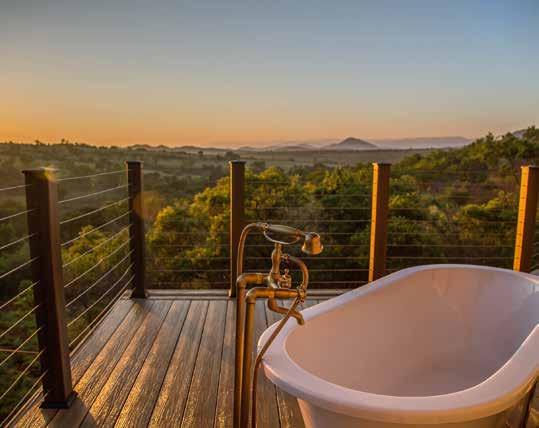
“There aren’t many places in this region where you can see brown hyenas, and winter definitely gives us a better chance,” says Derek.
Birding, too, remains rewarding in the dry winter season. While summer migrants may have departed, resident species, including the African finfoot, jackal buzzard, and African fish eagle, offer memorable sightings.
“In the winter, I also like to focus my birding on what we call ‘the little brown jobs’,” says Derek with a laugh. “Birds like the swee waxbill, orange-breasted waxbill and wailing cisticola are all lovely sightings to aim for.”
Although morning game drives begin in the chill of dawn, guests are kept cosy on the safari vehicles with blankets and hot-water bottles, so they can be rewarded with radiant sunrises and the thrill of early sightings. Evening drives ease from mild afternoons into clear, star-filled nights. And with almost no light pollution, the sweep of southern stars over Nkomazi offers a dazzling spectacle.
“At the lodge, we have a dedicated stargazing area with a Celestron telescope, and if guests are interested, we offer astronomy sessions before dinner,” adds Derek. “I also like to share the old African stories about the stars; the Khoisan people, in particular, have some beautiful tales.”
The lodge certainly reveals layers of charm in the winter, with the 14 luxury en-suite tents set overlooking the Komati River. Each suite, decorated with a sense of vintage glamour, boasts expansive indoor living areas that spill onto an outdoor deck complete with a private plunge pool. However, in the crisp winters, the indulgent outdoor ball-and-claw bath is perhaps a better option, offering the perfect way to warm up after a game drive.
“It’s only two months of the year that are quite cold, and winter is such a magical time to visit,” says Nkomazi’s general manager, Debbie Olivier. “The Komati River runs lower, but it’s crystal clear. That makes it great for fly-fishing, and the picnics on the riverbank are always a winter favourite.”
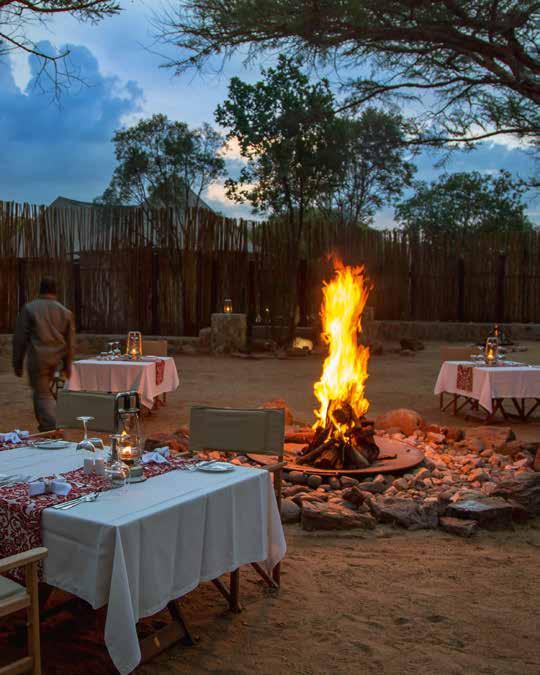
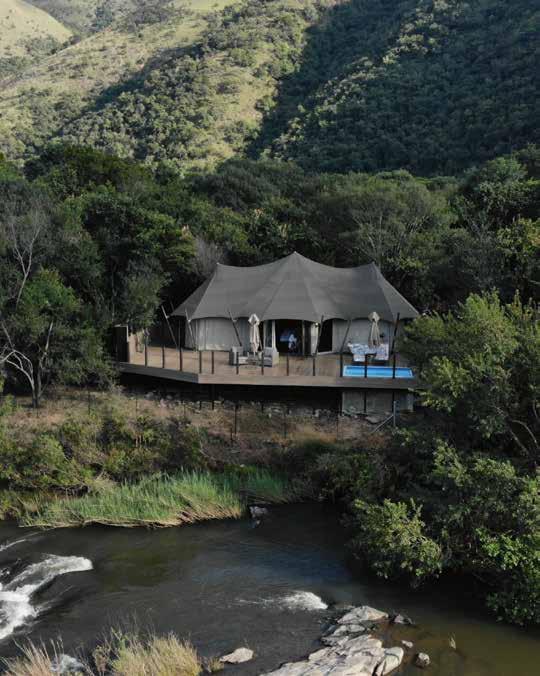
The Nkomazi spa also becomes a warm sanctuary during the cooler months. Two dedicated treatment rooms are available, but if the sun is out, guests can opt for massages on their private decks, and the larger honeymoon suite can even accommodate couples’ treatments.
There’s indulgence of a different sort around the table, too, and evenings at Nkomazi come alive with fireside storytelling and slow-cooked feasts.
“When we think winter, we think fire, we think red wine, we think moreish food,” says Newmark’s Group Head Chef Chris Erasmus. “There’s a lot more slow cooking in winter, and we focus on cooking over flames.”
That truly comes to life in Nkomazi’s boma beneath the stars. With its wood-fired oven and crackling fire pit, it sets the scene for long dinners under the stars, where guests can trade tales from their day.
“Our boma dinners are an unforgettable bush offering,” says Chris. “There’s usually a lot of meat on offer, and at Nkomazi, we focus on game meats like venison, wildebeest, and even crocodile. Some of my personal favourites are the wild boar ribs slow-cooked in the wood-fired oven, and the incredible venison shanks.”
The boma menu at Nkomazi also leans into South African culinary traditions with a refined bush twist. “The chakalaka,
a spicy South African relish, that we make is next-level,” enthuses Chris. “And Mama G, one of our local chefs, brings real heart to the kitchen. We serve creamed morogo, samp and beans to include some traditional African dishes on the menu.”
Along with his dedication to sustainable nose-to-tail cooking, Chris puts enormous energy into hyper-local sourcing.
“All our suppliers are small, family-owned businesses in the area,” he explains. “That way, the fingerprint of each dish reflects a genuine, local impact on the surrounding communities. It’s good to know that with each plate, we’re helping local families pay their rent and put their kids through school.”
Whether it’s a lantern-lit dinner in the boma, a steaming bath beneath the stars, or an unforgettable sighting of a cheetah on the hunt in the pre-dawn chill, winter at Nkomazi Private Game Reserve is certainly not a time to retreat indoors. Instead, savour the chance to see the bush more clearly, to dine with indulgence, and to feel the landscape more completely. Here, the chill in the air is simply an invitation to draw closer to the fire, pull the blanket around you a little tighter, and revel in this wild corner of South Africa.

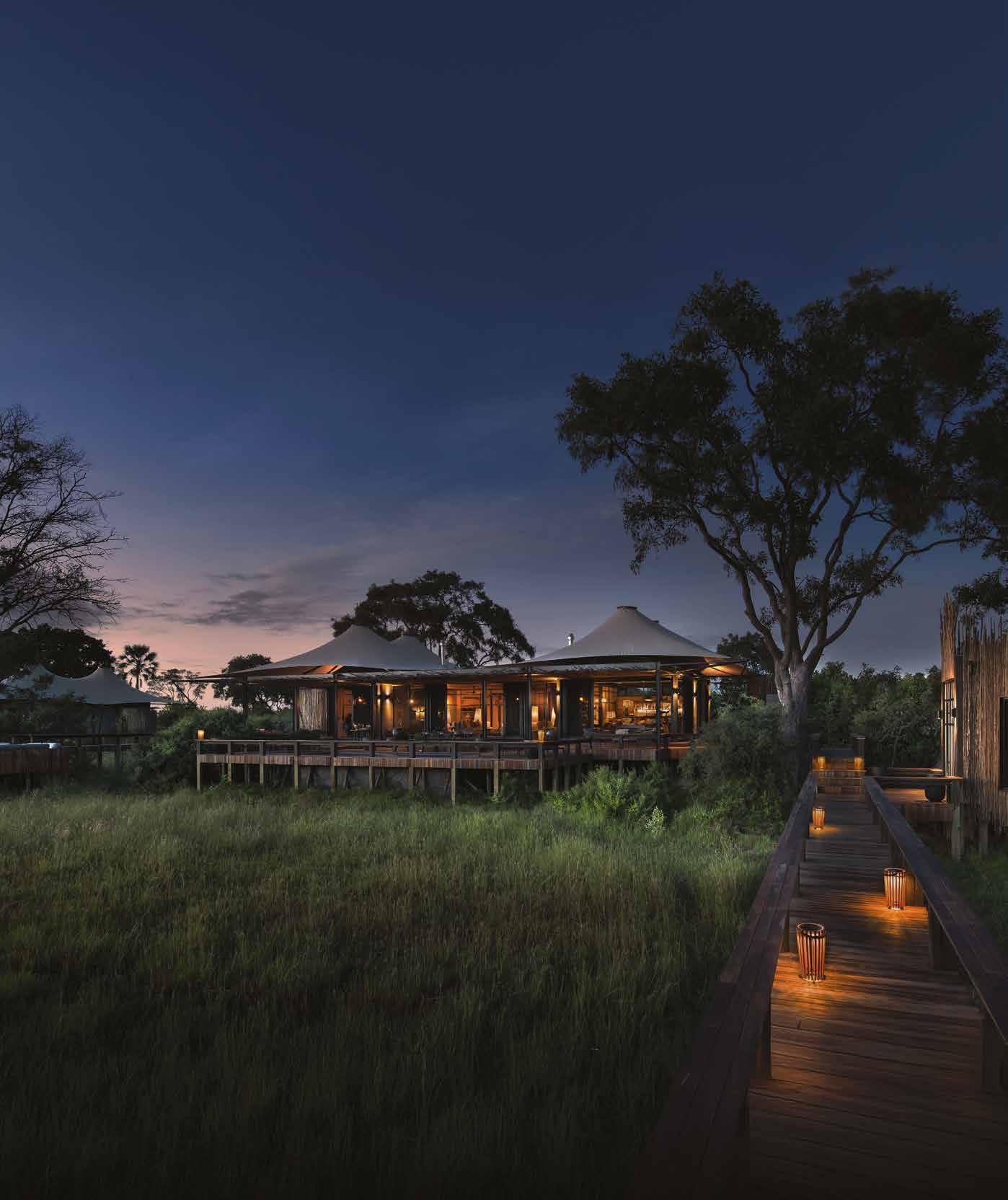
SCAN TO BOOK
Step

Designed for impact. Built to endure. Styled to inspire.

Not a
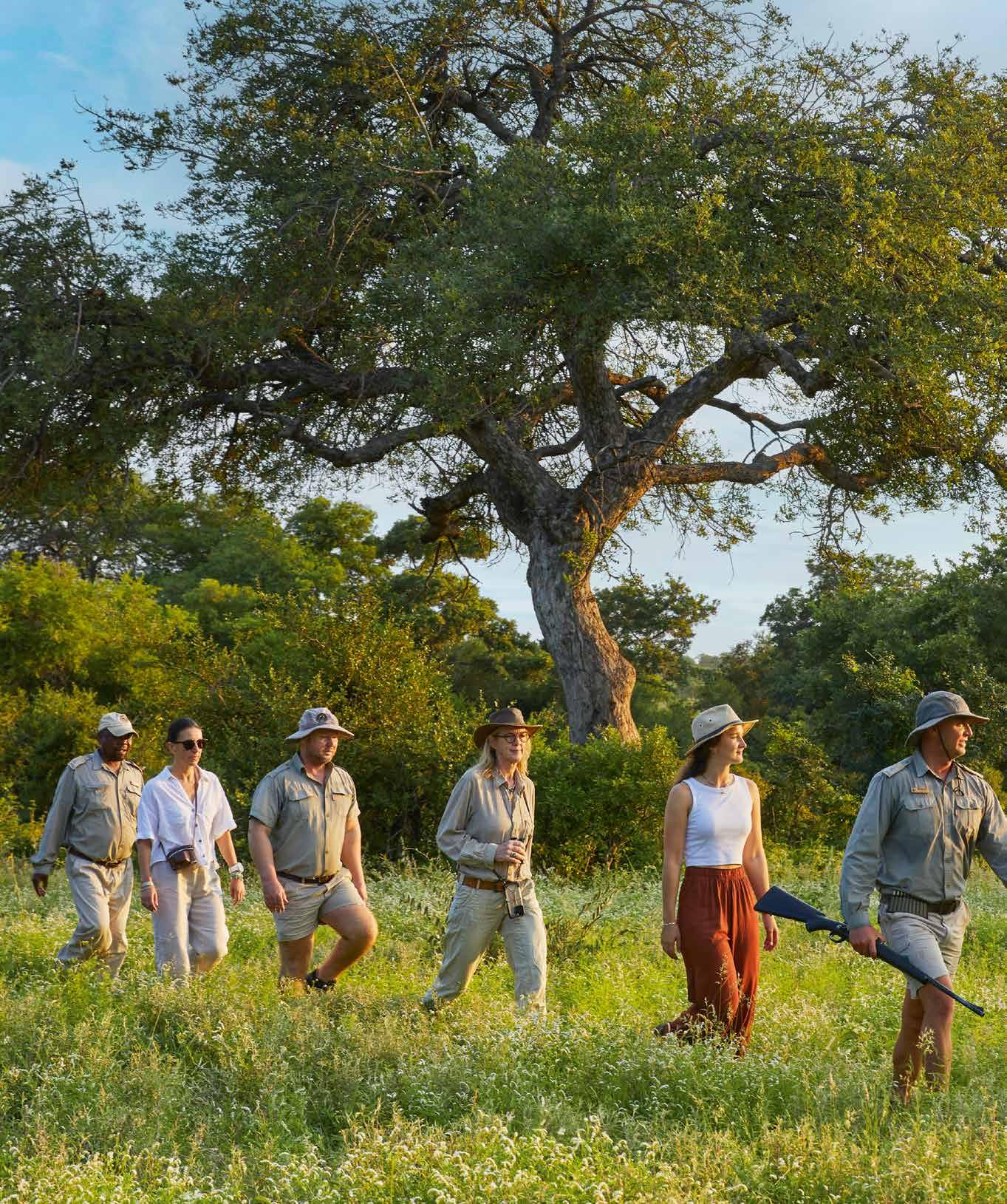
not a
hike,
trek. This is a slow, mostly silent, deliberate amble through wilderness made complete with interesting facts delivered by guide, Jeremy Schreiner, about the plants and the wildlife around you.
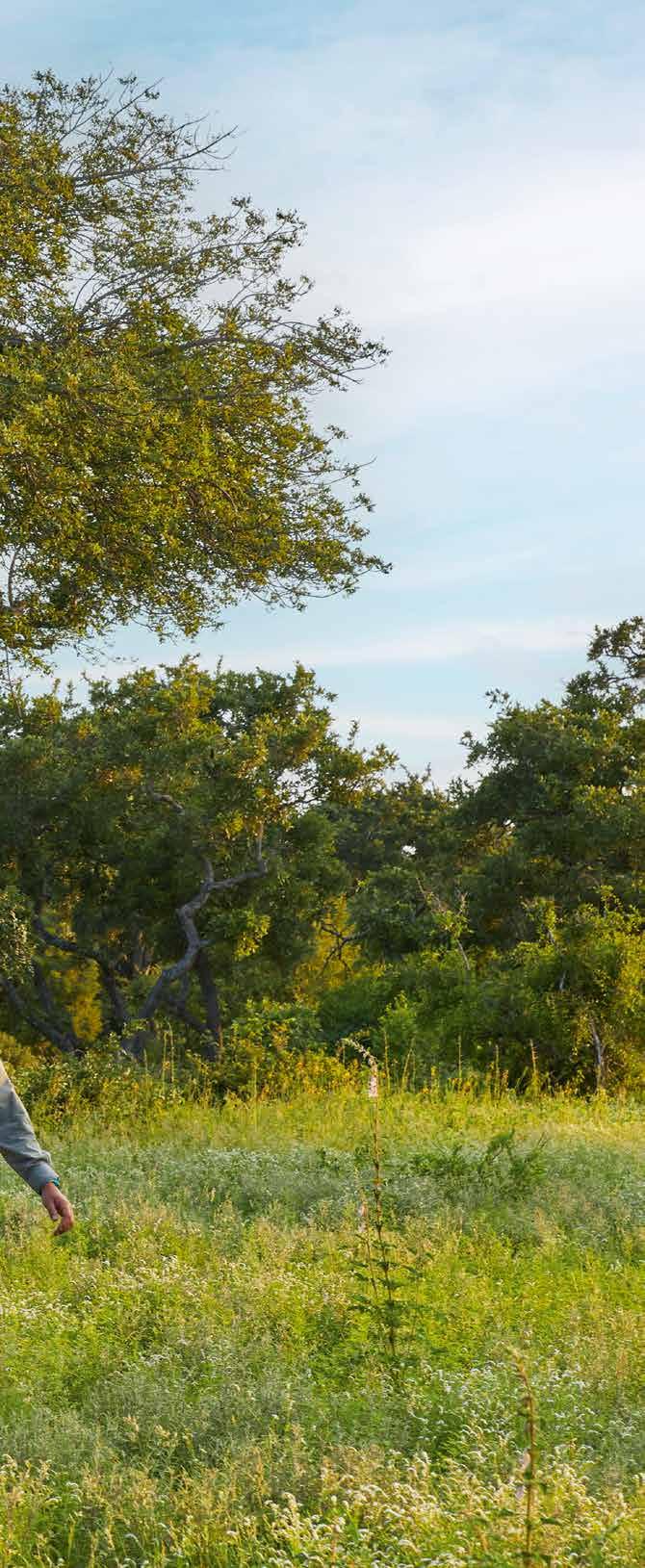
The Meditative Power Of Walking
At Motswari African Retreat & Walking Safaris, the bush is transformed into a place of introspection and contemplation
BY ANDREA NAGEL
The African bush, as described in the classic writings of authors like Ernest Hemingway (Green Hills Of Africa), Peter Hathaway Capstick (Death In The Long Grass) and Robert Ruark (Horn Of The Hunter), was once a theatre of masculine assertion. In those days, you came here to kill things. Sweating under cork helmets with moustaches like misplaced brushes and rifles carried around like unresolved issues, men – almost always unbearably pleased with themselves – stood astride their conquests. Lions, leopards, the odd unlucky buffalo, all sprawled like plundered heirlooms beneath the boot of empire and ego. If you didn’t shoot something, were you even on safari?
It is, mercifully, a different story now. In the era of mindfulness and magnesium supplements, the only thing people want to shoot these days in places like the Timbavati Private Nature Reserve, which lies within the Greater Kruger National Park, is high-res raw footage on the latest Canon or, for the less inclined to carry around the equivalent of a rifle case of zoom lenses, on the excellent camera of their smartphone. In a world where trophies are for algorithms and not walls, the safari has undergone a revolution. What was once a sideshow of conquest and all the obvious tropes of masculinity is now an ecoconscious, bush-scented journey toward inner peace and outer stillness, which together promise to foster a lasting connection with nature and the land while showing only the deepest respect for all living things. Nowhere is this more evident than on a bush walk, and nobody does a bush walk quite like the Motswari African Retreat & Walking Safaris.
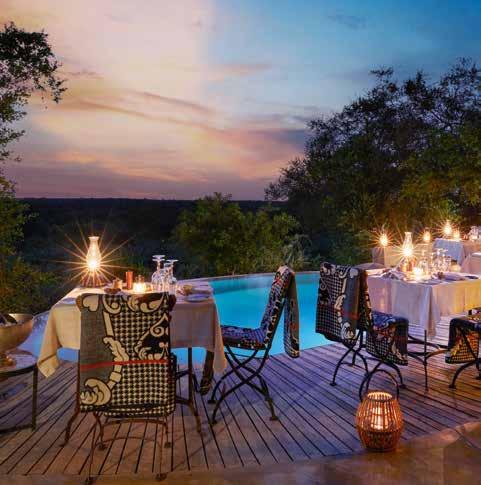
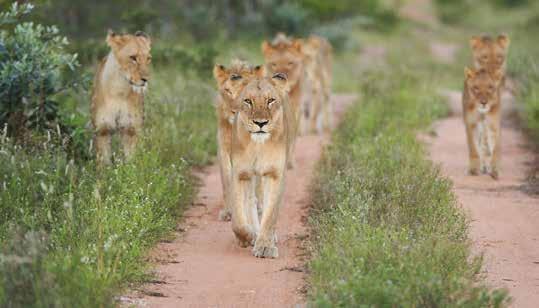
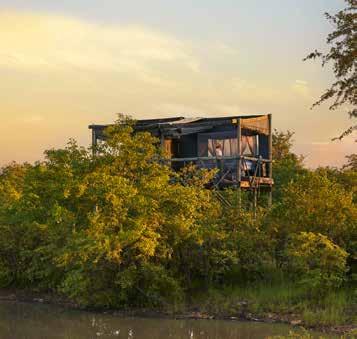
Motswari – which means “to conserve and protect” in Tswana – is no stranger to the beautifully curated wildlife experience. The main lodge is a subtle composition, a sort of luxurious, though unostentatious, still life in muted watercolour, where owner Marion Geiger’s artistic touch quietly embellishes every elegant surface. It’s pure class without pretension. Close by is Geiger’s Camp, an exquisitely remote satellite, more like a beautifully decorated private home on a game farm – Geiger’s touch again. And then there’s also Giraffe’s Nest, a rather mad, rather marvellous treehouse for two, which sounds like the punchline to a riddle but is actually an elevated fantasy of al fresco sleep.
Motswari African Retreat & Walking Safaris is a set of four private bungalows orbiting a tranquil circular studio (used for any number of wonderful experiences) like wellness planets around a sun made of sage and self-care. This is where I had the pleasure of participating in a walking safari. Not a hike, not a trek. This is a thing unto itself: a slow, mostly silent, deliberate amble through wilderness – less Bear Grylls survival and more meditative yogic flow on meander mode complete with interesting facts delivered by our guide, Jeremy Schreiner, about the plants and the wildlife – both huge and minute – that we explored on foot.
Schreiner is the perfect guide – but then most people would say that about their game ranger, the person whose hands you deliver your life into as you walk unprotected among Africa’s untamed and unpredictable beasts. This is the joy of the bush
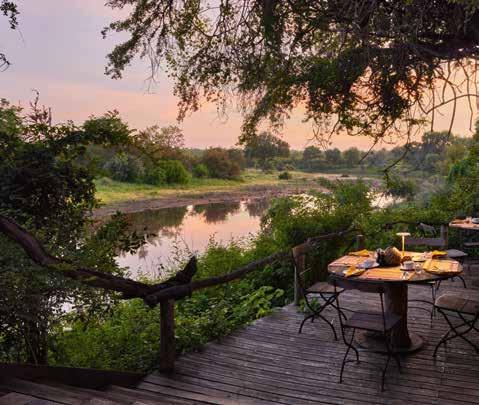
walk. You feel the crunch of sand and dry leaves underfoot, looking out for scorpions, beetles or snakes on the path and spotting herds of buck grazing on grasses and bush while scanning the middle distance for the movement of a predator. As directed by Jeremy at the start, our group walks in single file, silently switching positions as we progress so that each of us gets a turn to walk behind the expert, who frequently imparts titbits of bush lore and fascinating information. As a group, we don’t so much walk as glide through the landscape like we belong there, each of us entranced by the beauty of it all and taking in the info while simultaneously inhabiting our own thoughts and senses. When Jeremy speaks, which is rarely, it’s with the measured gravitas of a man explaining the birth of a planet. He tells us – quietly, reverently – about the white lions of the Umbabat area of the Greater Kruger, creatures so rare they seem the stuff of myth and Photoshop. These animals, he explains, are not merely zoological anomalies but revered beings to the Pedi and Tsonga peoples, thought to be the reincarnations of ancient chiefs and the sun’s own progeny. They are, he says, “the most sacred animals of the African continent.”
We see no white lions. We see no lions at all. There is a noticeable absence of drama and that suits us all just fine. There’s no roaring, no stampedes, not a tusk in sight.
If we’d come expecting Attenborough’s Greatest Hits, we might feel short-changed. But that, I realise halfway through
From left: The dinner setup at Geiger’s Camp; lionesses walking along the path during a game drive; Giraffe’s Nest treetop sleep-out; breakfast at Motswari overlooking the river.

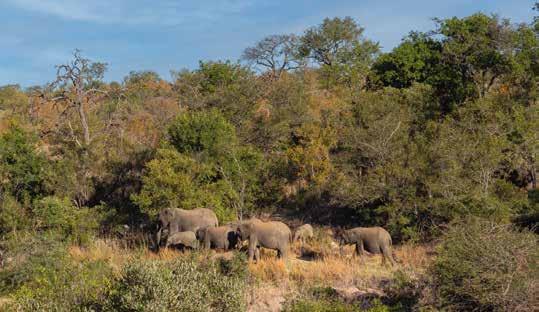
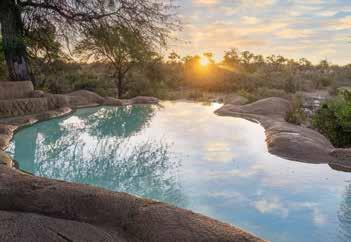
hour two, is the point. This isn’t a safari of spectacle. It is a kind of moving meditation – a pilgrimage in restoring everything our draining, concrete jungle lives take out of us.
We walk largely in silence. And not the forced, awkward silence of city group tours. This is silence that’s meditative, absorbing, almost holy. Each step is a benediction. Our thoughts, usually as noisy and insistent as a WhatsApp group chat, slowly quiet themselves. I stop worrying about emails, unpaid bills, or the disintegration of Western civilisation and start noticing birds – hundreds of them, calling in playful song to each other as they scout the brush on behalf of its creatures. There are leaves of all colours. Dung of all textures. Bark that begs to be touched. We begin to care, deeply and irrationally, about beetles.
Every now and then, Jeremy stops to point out something tiny and marvellous. A caterpillar that pretends to be a snake. A tree that bleeds red sap, like it’s been wounded. He tells us about plants used for fertility, toothpaste, stomach aches and curses. The bush, it turns out, is Africa’s original apothecary. Everything here either heals you or eats you. Sometimes both. And then, just when we thought the experience had become too spiritual, too full of gongs and grounding energy, we came upon a flat rock set like a stage in the middle of the wilderness. And on that rock: a surprise picnic breakfast. Now, let me clarify. This was not a soggy-croissant-andlukewarm-coffee affair. It wasn’t trail nuts and peanut
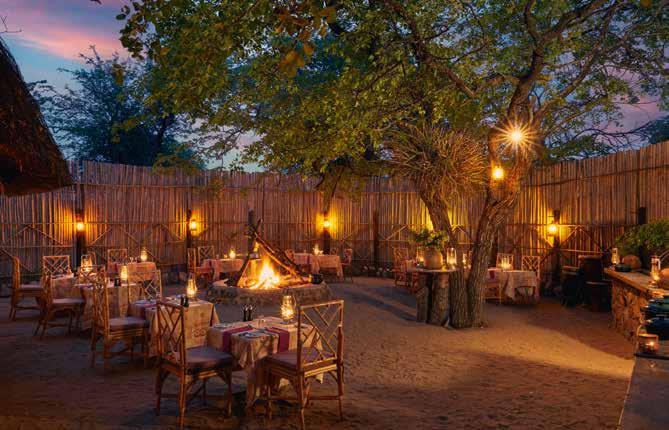
THE BUSH, IT TURNS OUT, IS AFRICA’S ORIGINAL APOTHECARY. EVERYTHING HERE EITHER HEALS YOU OR EATS YOU. SOMETIMES BOTH.
butter sarmies. This was a spread, a veritable gastronomic hallucination. Champagne and orange juice, silverware attracting the crows, eggs cooked precisely the way you forgot to ask for, tropical fruit arranged like a painting so that you didn’t want to ruin it, but just couldn’t help yourself. It was – in the best possible way – almost absurd. And perfect. If you’re going to attempt transcendence, it should absolutely come with a bush walk and breakfast, fully spread on a picnic blanket.
Afterwards, full of frittata and feelings, we padded quietly back to camp. My legs were tired, my phone untouched, my soul refreshed.
This is the genius of Motswari’s walking safari. It doesn’t shout its credentials. It doesn’t try to dazzle you with the Big Five or wall-to-wall Wi-Fi. It simply invites you to be present. To walk slowly. To listen. To let go of the need to document every moment. And in doing so, it offers something increasingly rare: a very good feeling. Not of conquest, but of connection. Not domination, but participation.
You arrive hoping to see a lion. You leave remembering how to be human.

SCAN TO BOOK MOTSWARI AFRICAN RETREAT & WALKING SAFARIS
Clockwise from top: Elephants walking along the path at African Retreat & Walking Safaris; dinner around the fire at the boma at Motswari; poolside at Motswari African Retreat & Walking Safaris.
Tracks, Tales And Family Ties In The Waterberg
Deep in the untamed beauty of the Waterberg, LETAMO at QWABI Private Game Reserve is reimagining the bush as a place not just for game viewing, but for shaping young minds and rekindling family bonds
BY RYAN ENSLIN

In the heart of the Waterberg, tucked away in South Africa’s Limpopo province, lies a rugged wilderness of rolling hills, ancient rock formations and untamed natural beauty. Although renowned for its thriving wildlife, rich biodiversity and malaria-free safaris, this UNESCOdeclared savannah biosphere is now gaining recognition as an off-the-beatenpath haven for budding conservationists, with LETAMO at QWABI Private Game Reserve leading a new wave of multigenerational travel: the family safari. These adventures bring together wildlife, education and quality family time, echoing similar global trends toward sustainable, multi-generational travel.
LETAMO transforms the bush into a classroom for eager minds. “We love being the ones to guide a young person on their first bush experience,” shares Dane Johnsen, LETAMO lodge manager. Here in the Waterberg, Dane and his team of specially trained guides are shaping experiences rooted in hands-on learning, designed to ignite a lifelong sense of environmental responsibility in conservationists-to-be.
Integral to this approach is the pack each child receives from the lodge at the start of their journey. This includes animal and bird checklists, a spoortracking guide, stimulating nature-based puzzles and space to sketch what they encounter when out on a game drive. Rhino collaring information is also shared in the pack, as the children are guided towards a conservation-first approach to age-appropriate fun in the bush. “Our guides engage with the young guests on their level, often stopping to point out spoor or identify a bird,” shares Dane. “Their checklists are usually filled with information upon departure,” confirms head guide Damien Fourie.

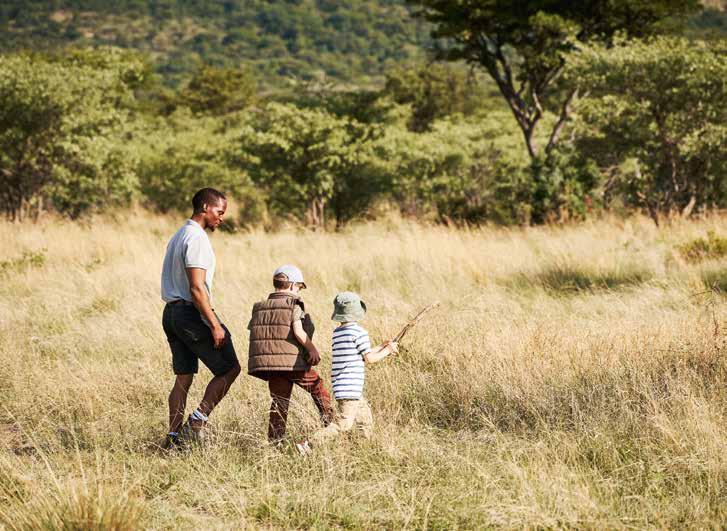
Specially trained guides shape experiences designed to ignite a lifelong sense of environmental responsibility. Opposite page: LETAMO transforms the bush into a classroom for eager minds.
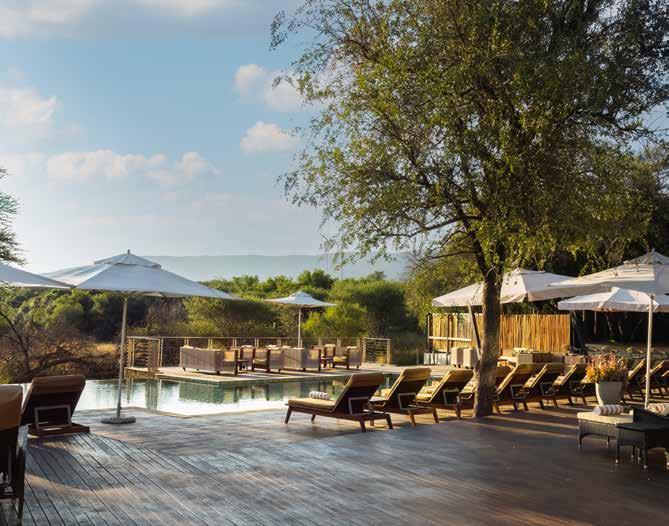
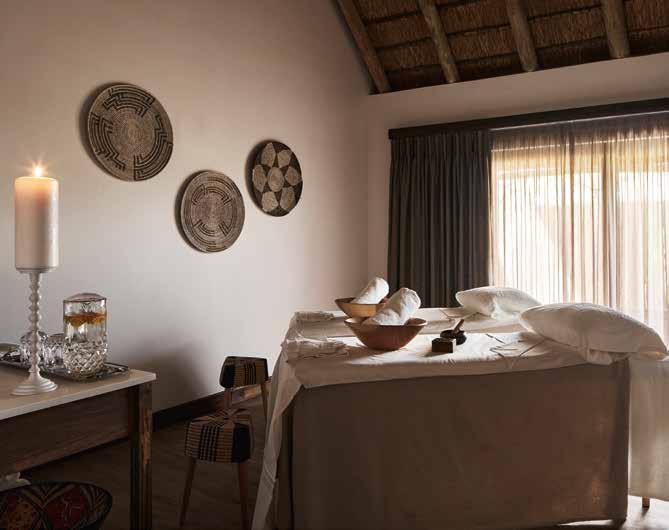
JUST AS THE SPA NURTURES THROUGH THE HEALING RHYTHMS OF THE LAND, DINING AT LETAMO IS A CONTINUATION OF THIS SENSORY JOURNEY.
The impact of this approach is clear – it cultivates genuine family connection. Removed from screens and the pace of daily life, families rediscover each other in the stillness of the bush. They share game drives, tick off sightings together beneath fiery sunsets and bond over laughter at dinner tables set deep in the bush. “This outdoor learning space is a window for exploration and learning through doing,” points out Dane.
While out on a game drive, eco-warriors are given the opportunity to identify a spoor they would like to cast. With the necessary materials on hand, the guide makes a cast right there in the bush. Having dried overnight, young eyes have been known to glow the following morning when the cast is handed back to them, a keepsake from their time at LETAMO.
The emphasis on unplugged, naturebased experiences aligns with growing
research in the field of human-computer interaction. A recent study by Kawas et al, involving 15 families, with 23 children aged 8 to 12, revealed that time spent in nature can significantly reduce screentime tensions between parents and tweens, a time when independence starts to assert itself. In an age where digital devices often dominate daily routines and family interactions, shared experiences in the bush can offer an essential counterbalance.
The study found that nature-based activities foster stronger communication, co-operation and emotional connection among family members, particularly in the tween years. When immersed in the sensory richness of a game drive, children become fully present, engaging with the world around them rather than the digital one in their hands.
At lodges like LETAMO, this intentional approach naturally displaces
the pull of screens without needing strict rules or digital-detox mandates. Instead, the bush becomes the medium through which deeper bonds are formed, curiosity is sparked, and children learn to pay attention to something far bigger than themselves. It’s a gentle recalibration of focus, where attention is reclaimed not through restriction, but through meaningful connection.
Beyond child-centric game drives in the Waterberg, LETAMO delivers all the refined luxuries discerning guests have come to expect from a property of this calibre. The beauty of nature continues into the Wellness Spa at LETAMO, where a sanctuary of indulgence and serenity inspired by the spirit of the bush awaits. A curated menu of treatments boasts local herbs, natural earth elements and plant-based extracts to uplift both body and soul.

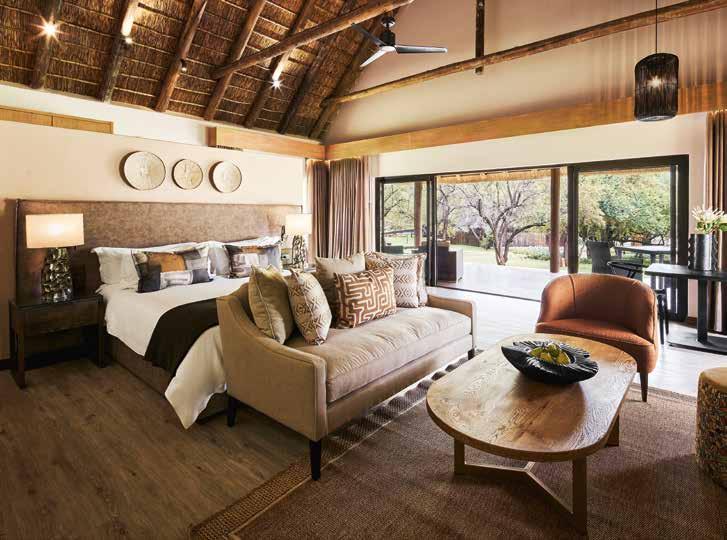
OUR GUIDES ENGAGE WITH THE YOUNG GUESTS ON THEIR LEVEL, OFTEN STOPPING TO POINT OUT SPOOR OR IDENTIFY A BIRD.
Just as the spa nurtures through the healing rhythms of the land, dining at LETAMO is a continuation of this sensory journey. From breakfasts to generous high teas and African dinners, each meal is crafted as an extension of the bush experience. The culinary team honours local traditions, bringing bold flavours and soulful storytelling to the plate. It’s food that restores, delights and lingers in memory.
Not to be left out, the LETAMO Kids’ Club offers a home base for little explorers, a welcoming space where they can unwind between bush adventures, under the supervision of the trained Kids’ Club team. Here, games and toys spark imaginative play, while activities, like clay modelling and crafts, keep curious minds engaged. For quieter moments, there’s a cosy corner for storytelling or screen time. Outside, a jungle gym and kids’ pool offer the perfect setting for carefree fun under the African sun.
Family safaris at LETAMO at QWABI Private Game Reserve are fostering powerful, regenerative journeys, blending shared discovery, active conservation, education and deeply meaningful multi-generational bonding. From kid-focused guides to authentic engagement, the approach is both purposeful and emotionally resonant. A shift from passive tourism to experiences that inspire the next generation of environmental stewards. One safari at a time.

SCAN TO BOOK
LETAMO AT QWABI PRIVATE GAME RESERVE
Family safaris foster powerful, regenerative journeys, blending shared discovery, active conservation, education and deeply meaningful multigenerational bonding. Opposite page: LETAMO delivers all the luxuries discerning guests have come to expect from a property of this calibre.
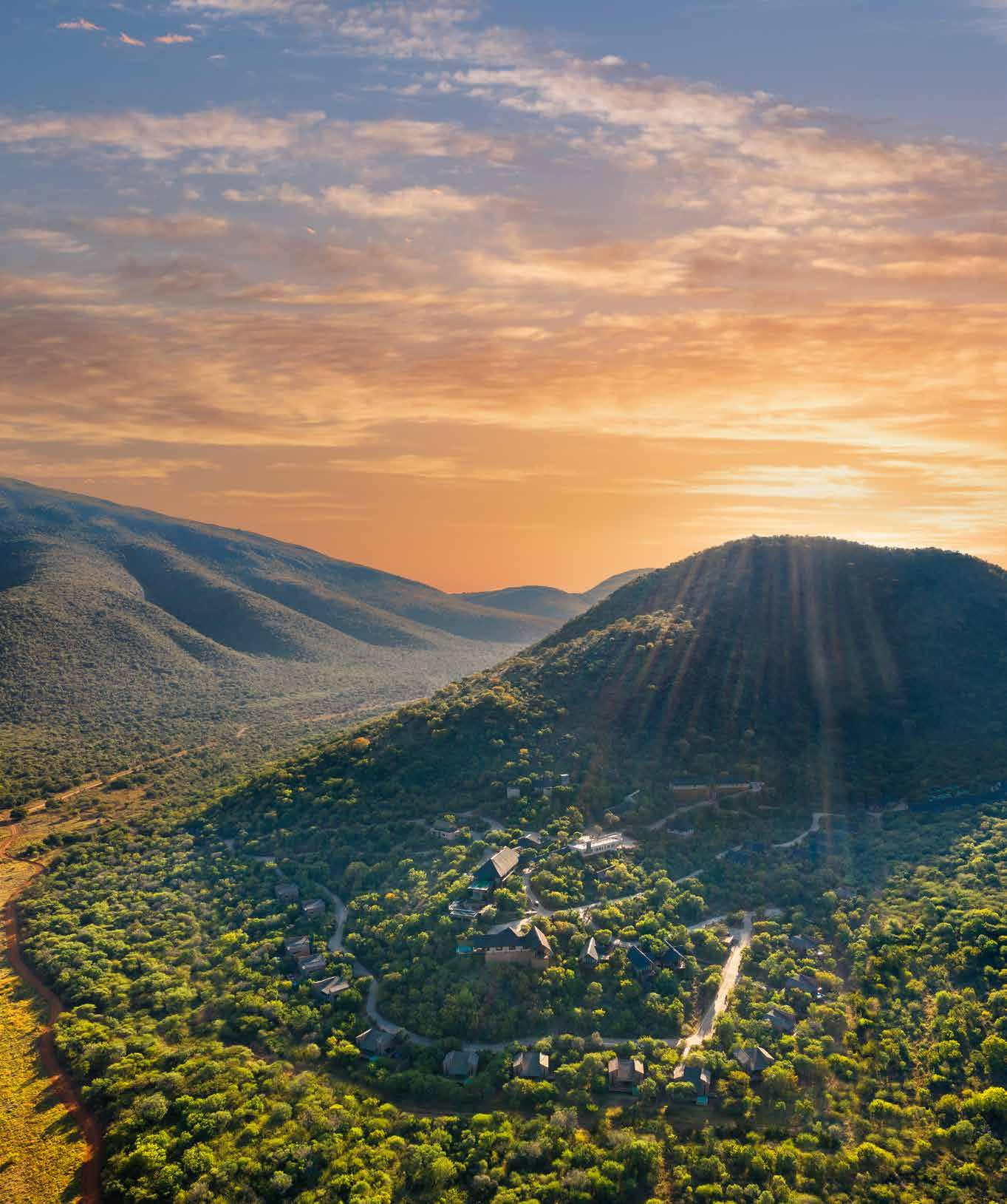
THE QUIET LANGUAGE of SCENT
Lost on a dirt road in the Waterberg, you’ll stumble into something unexpected – a journey guided not by maps, but by scent
BY RYAN ENSLIN

Frustration tempers my excitement as I make an illegal U-turn on a dirt road deep in the Waterberg. I’m headed for BABOHI Lodge at QWABI Private Game Reserve, but having arrived at the second of only one advised checkpoint, I accept that I am lost. A bead of sweat traces its way down my right temple as I pause to take in the raw, dramatic beauty of this untamed corner of Limpopo, wrestling back control of the situation in an earnest attempt to restore my excitement quotient.
In time, I would come to understand the moment to be a welcome harbinger of what was to come.
Composed once more, I arrive at QWABI, a broad smile evident for the attendant to see. Excitement mounts as I hand over my keys and climb onto the game viewer for the short ride to BABOHI, the luxury lodge perched on a hillside in the reserve, my home for the days ahead. This break in the bush feels perfectly timed, a chance to recalibrate after too long living at a frantic pace.
A QWABI WELCOME
There’s a quiet honesty to the land here, I reflect, as we make our way to BABOHI. Tyres grind over loose rock, a sound I embrace as my personal welcome to the bush. Taking in the beauty of nature all around me, I breathe in deeply, catching a slightly herbal scent carried on the wind. In that moment, I’m transported to memories of my grandfather, himself an avid explorer, albeit only of the infamous South African back road. It’s a good space for me.
Curious, I ask Joe van Rensburg, my guide for the duration of my stay, about the fragrance that’s stirring something within me. He brings the vehicle to a halt, jumps out and heads for a grey shrub with the ease of someone who belongs here. “That’s the camphor bush,” he calls back, plucking a small leaf and rubbing it between his fingers. “We probably crushed a leaf while driving over the rocks.” He walks back, holding out the leaf for me to smell.
The air is now infused with its distinct fragrance – resinous, earthy and woody. As we continue, I notice how the scent seems to ground me while igniting a quiet sense of adventure deep within my soul.
ARRIVING AT BABOHI
As we enter BABOHI, the vehicle wades through a body of water, sending dramatic ripples in every direction. A familiar, musty fragrance hangs in the air, but my attention is captured by the elegant arc of water rising beside me. The name BABOHI draws on the symbolism of water, a nod to the cycles of renewal and flow of the land. Water is an ever-present element in this sanctuary of refinement in the heart of the African bush, a place where every detail is curated for discerning travellers.
I’m greeted at the lodge with warm smiles and a handwashing ceremony, a simple yet meaningful ritual that marks my arrival. Inside the beautifully appointed lounge, Samke Mthembu welcomes me with quiet grace. The space is a blend of earthy tones, wooden finishes and warm fabrics, seamlessly merging with modern copper accents and sophisticated hues that echo the drama and subtlety of the bush. She offers a brief introduction to life at BABOHI.
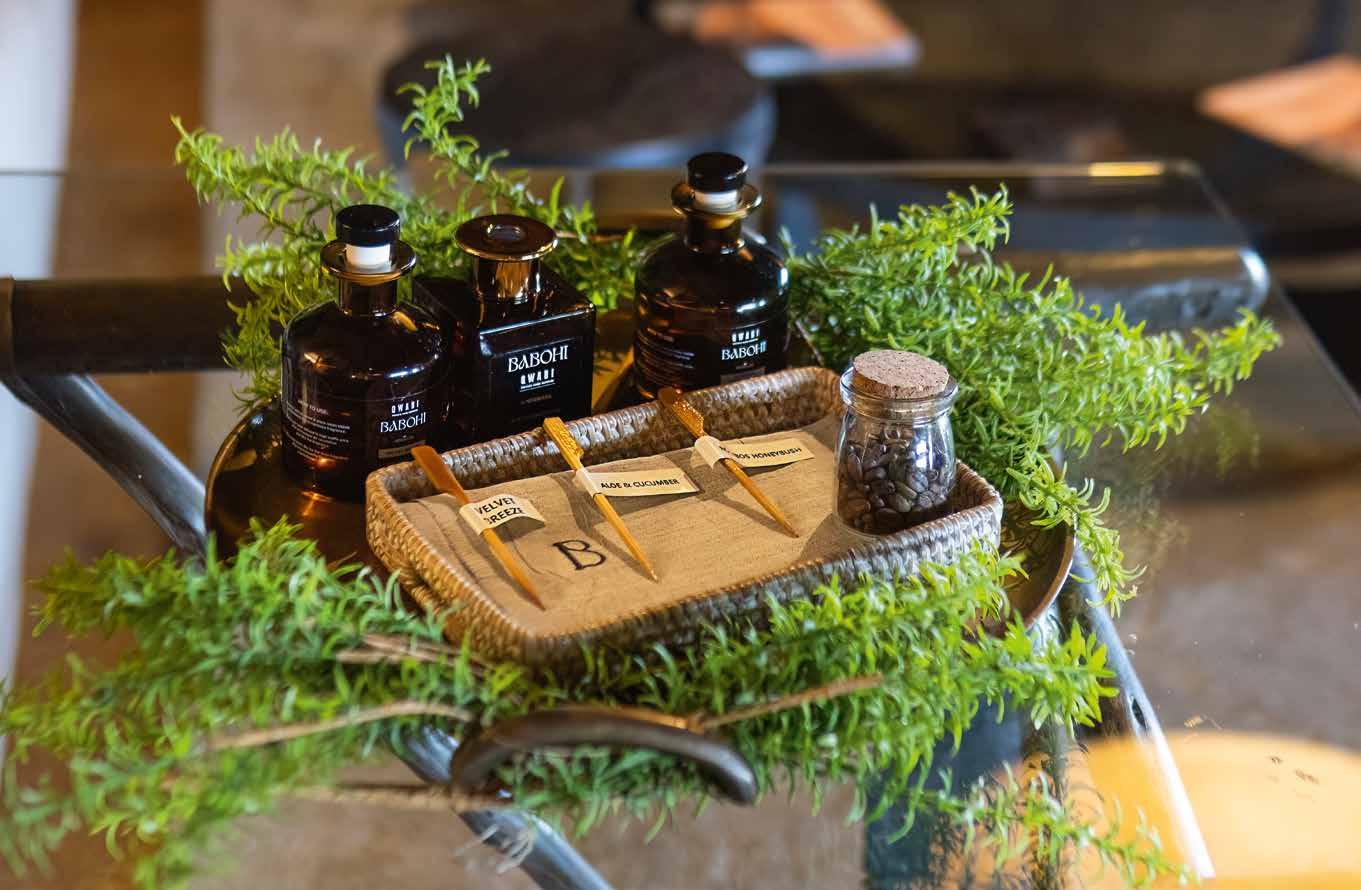
A FRAGRANCE JOURNEY
As her smile deepens, she presents a trio of aromatic oils. “The smells of the bush are primaeval,” she says, “mirroring the very meaning of life since the dawn of time.” I lean in, invited to breathe in the layered notes of aloe and cucumber, rooibos honeybush and velvet breeze. The sensory thread from earlier in the day picks up again, weaving me deeper into the rhythm of this place. “These scents were chosen to stir memory and emotion,” Samke explains, “to create a bridge between your world and the one just outside.” She watches with interest as I make my selection, a moment that feels both intimate and quietly transformative.
Drawn in by its gently sweet, quietly floral yet earthy notes, reminiscent of my earlier encounter with the camphor bush, I choose the rooibos honeybush fragrance. Samke explains that my selection will subtly infuse my suite, from the room diffuser to the air freshener, each detail designed to extend the sensory thread. That night, I discover a rooibos honeybush linen mist on my pillow, a small, comforting turndown gesture that lingers with surprising warmth.
In the evolving world of luxury hospitality, where experience is everything and differentiation is key, fragrance is emerging as an invisible yet unmistakable signature of high-end hotels and lodges. More than just an ambient flourish, scent has become an emotional anchor, a carefully curated olfactory identity that lingers long after checkout.
Some establishments now offer scented souvenirs. Candles, diffuser oils or room sprays allow guests to carry a trace of the experience home. At BABOHI, these thoughtful touches are available in the curio shop, and during my stay, I even had the chance to craft a candle in my chosen fragrance. That candle has been lit more than once since my return, its earthy notes unfurling through my home like a memory rekindled, taking me back to quiet bushveld evenings on the reserve.
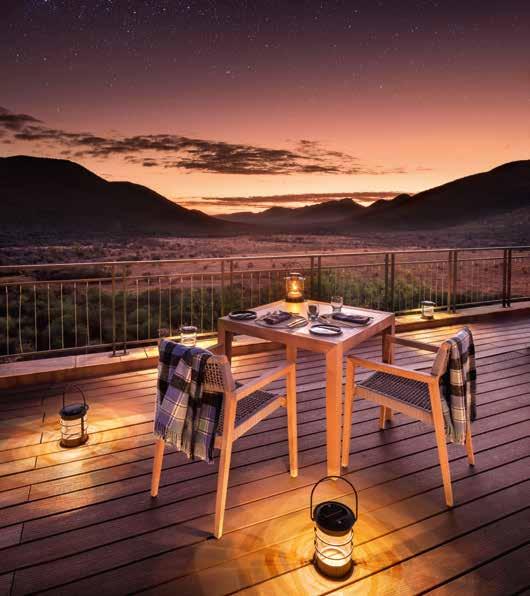
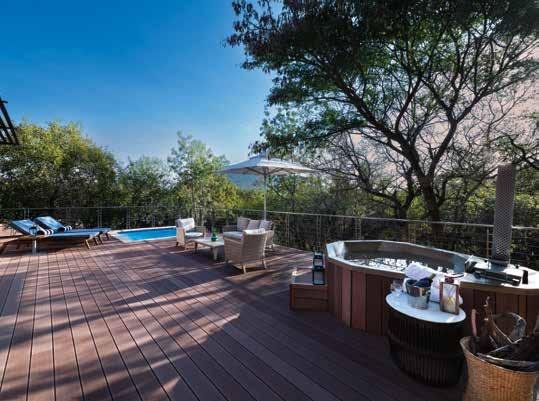
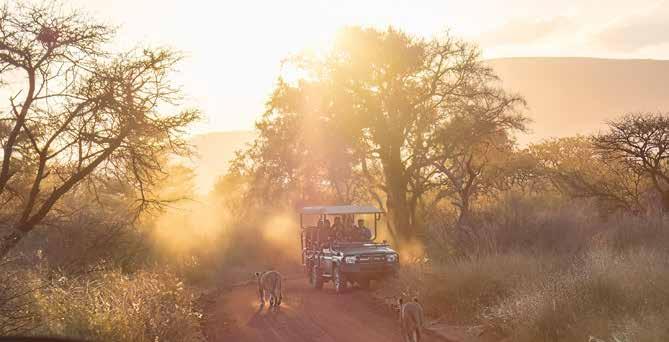
SCENTS IN THE BUSH
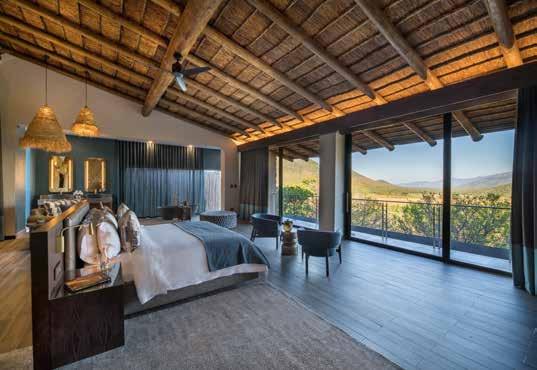
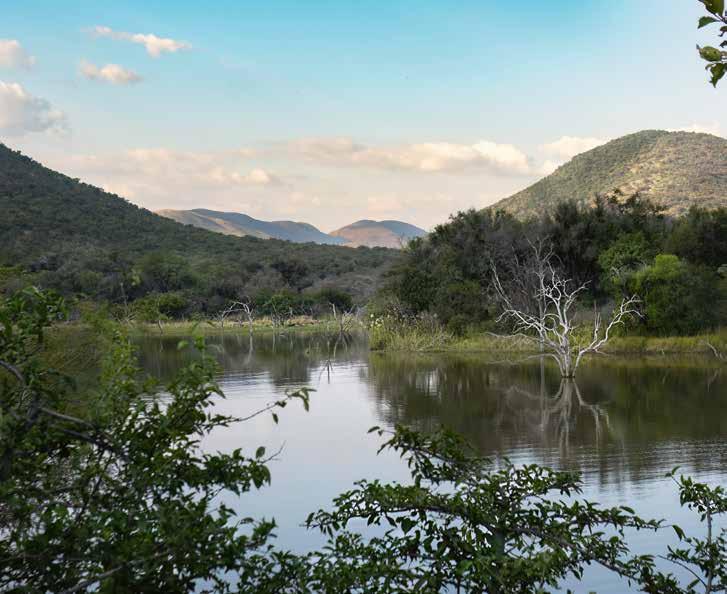
Later that afternoon, I’m back on the game viewer, crossing the same stretch of water that marked my arrival. That familiar, musty scent rises again, curling through the air. It registers briefly in my mind, but my attention shifts. The guides had mentioned a lion sighting earlier, and the possibility awakens something primal within me.
As we weave through the bush, my senses remain alert. Another fragrance drifts past, one I used to call the “Port Elizabeth smell” – herbaceous, spicy, with a dry, straw-like edge. In an instant, I’m back in the Eastern Cape, on holiday with my grandparents and my younger siblings in tow. I smile at the memory and ask Joe about the scent. “That’s the curry bush,” he says, and we carry on. As the afternoon deepens and we move through the bush, I surrender to the warmth of those remembered days, wrapped in the quiet comfort of being.
The sun begins its slow descent as we stop for sundowners. The bush quiets.
A wildebeest, clearly unsettled, charges past us. He stops, glances back. We follow his gaze to where a pair of lions emerge from the bush. They take note of us briefly, then move on, continuing the age-old rhythm of predator and prey.
And in that reverent, timeless moment, it struck me. Getting lost had only served to heighten my senses, forced me to find my way, and it was indeed the beginning of my BABOHI journey. This heightened state would prepare me for the quiet language of scent, both curated at the lodge and right there in the bush. It took getting lost to truly arrive, not just at BABOHI, but back to my senses.

SCAN TO BOOK BABOHI AT QWABI PRIVATE GAME RESERVE
Whether it’s on a game drive or from your private deck, you’re surrounded by a unique blend of scents from your surroundings. Opposite page: Create your own fragrance to match your experience of the scents of the bushveld.
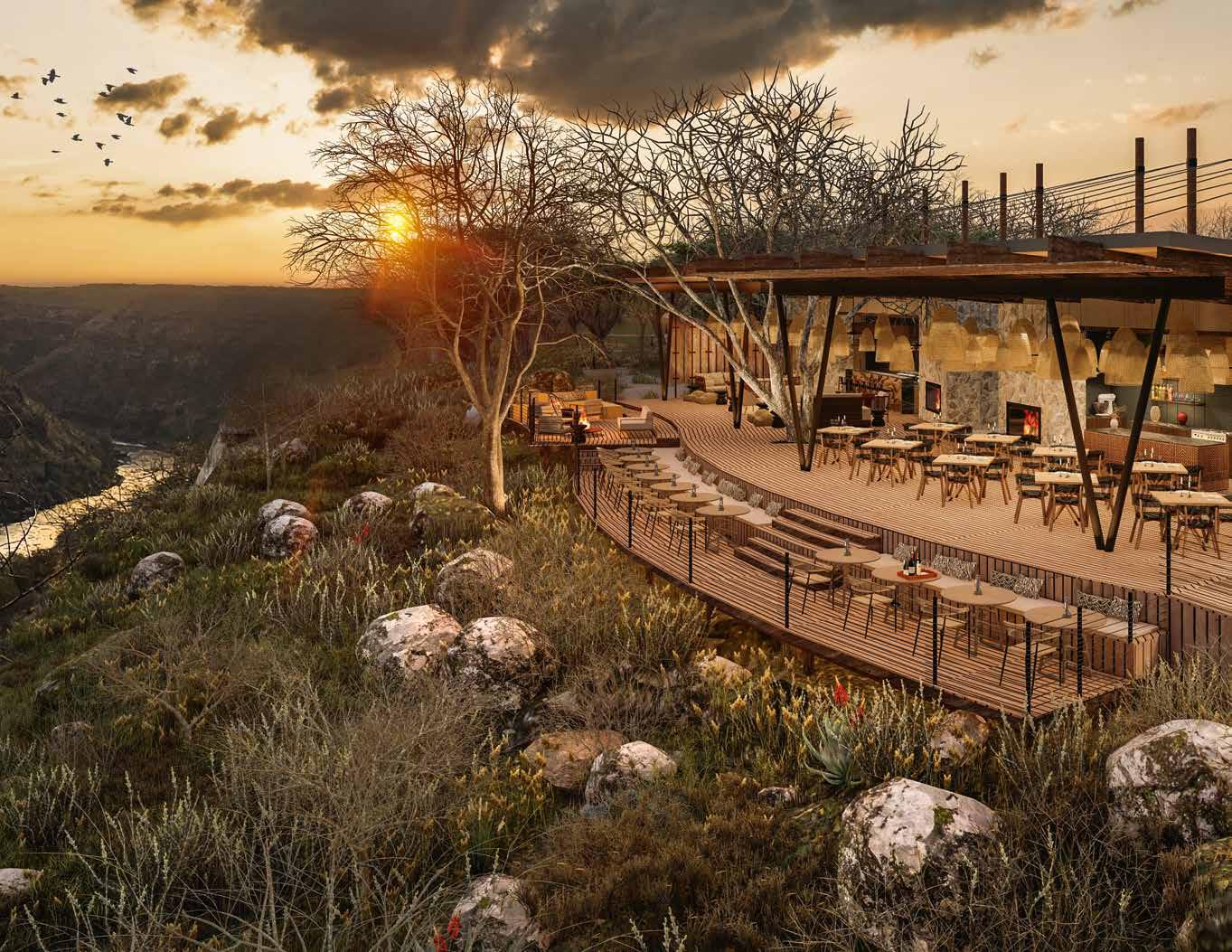
A New Landmark Lodge Launches In Zimbabwe
Clinging to the cliffs above the Zambezi, Bupenyu Lodge blends dramatic design with soulful stillness
BY RICHARD HOLMES
This year heralds a new era in luxury tourism for Zimbabwe with the opening of Bupenyu Lodge, perched high above the tumbling waters of the Zambezi River. Located on the edge of Zimbabwe’s world-renowned Batoka Gorge, just a 45-minute drive from Victoria Falls International Airport, Bupenyu Lodge boasts an utterly unique position in one of southern Africa’s most iconic destinations.
Above: Located on the edge of a gorge, Bupenyu offers unparalleled views.
Opposite page: Immersive luxury awaits guests.
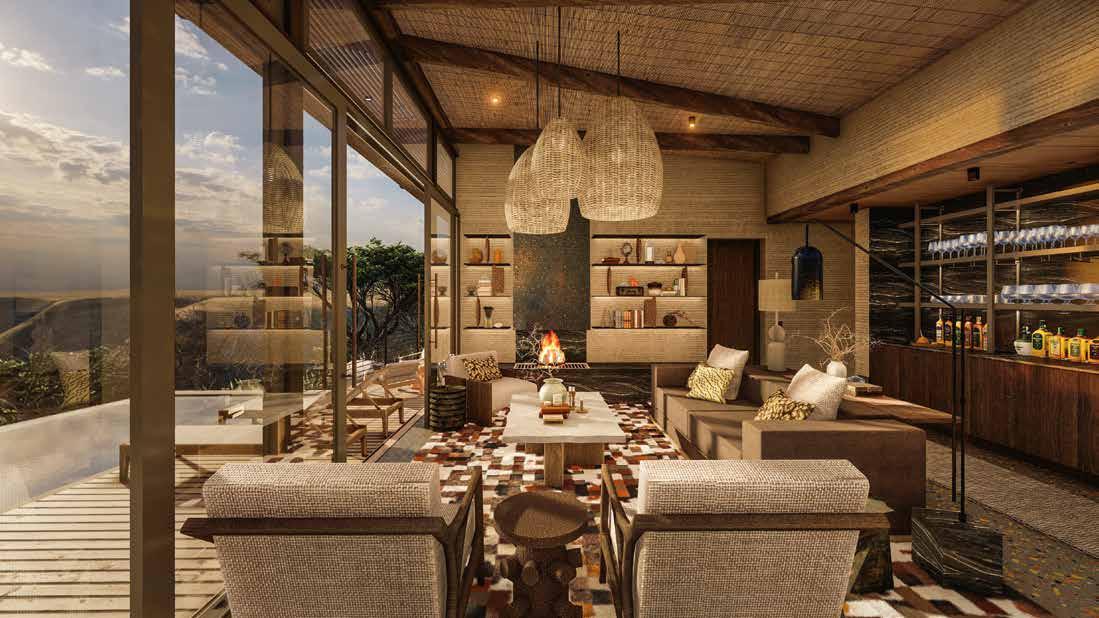
“We’re thrilled to be expanding the Newmark portfolio into our sixth African country with the opening of Bupenyu Lodge on the Zimbabwean side of the Zambezi River,” says Neil Markovitz, CEO of Newmark Hotels & Reserves. “As with all our properties, our vision for Bupenyu is to offer guests an experience that is immersive, authentic and with a real sense of place. We can’t wait to welcome guests to this extraordinary corner of Africa.”
While most luxury lodges near Victoria Falls – one of Zimbabwe’s five UNESCO World Heritage Sites – are situated along the tranquil riverbanks upstream, Bupenyu Lodge enjoys a dramatic cliffside location downstream. Perched on the very edge of the gorge, the lodge provides a unique view of the Zambezi River as the tumbling waters thunder down the ancient canyon carved from a landscape of solid basalt.
“In the entranceway, we’ve used stone-clad passageways that echo the narrowness of the gorge. These basalt-clad walls lead you to a dramatic reveal of the gorge view, while the structures are cantilevered to enhance that feeling of openness and light.”
“AN EXPERIENCE THAT IS IMMERSIVE, AUTHENTIC AND WITH A REAL SENSE OF PLACE.”
– NEIL MARKOVITZ, NEWMARK HOTELS & RESERVES
It was these dramatic Zambezi landscapes that inspired the design and architecture of the lodge, explains Nick Randall, director of Experience Architects who took on the project.
“We wanted the architecture to be a subtle frame for the landscape,” explains Randall, who found inspiration in the rock striations, as well as the pioneering spirit of early explorers, to create a lodge that is both striking in its design, yet at ease in the landscape.
The result is a design that harmoniously blends gravitydefying engineering with organic warmth: soaring roofs and tensile cables impart an airy aesthetic to the lodge, while raw stone, textured wood, and suspended platforms help anchor it to the terrain. Subtle architectural details echo the environment – the switchbacks of the gorge reflected in the chevron-patterned cladding; the layered striations of the basalt that inform the design of the striking bar. Even the open-air cliffside boma, affectionately known as the Falcon’s Nest, incorporates wooden contours inspired by the nests of vulnerable Taita falcons that inhabit the gorge below.
The main lodge features three unique dining platforms, each offering expansive views of the river and a selection of shaded lounges. Guests can enjoy a range of leisure and wellness facilities, including an infinity pool, gym, spa pods, an exercise deck, a running track, and a secluded bird hide for quiet observation.
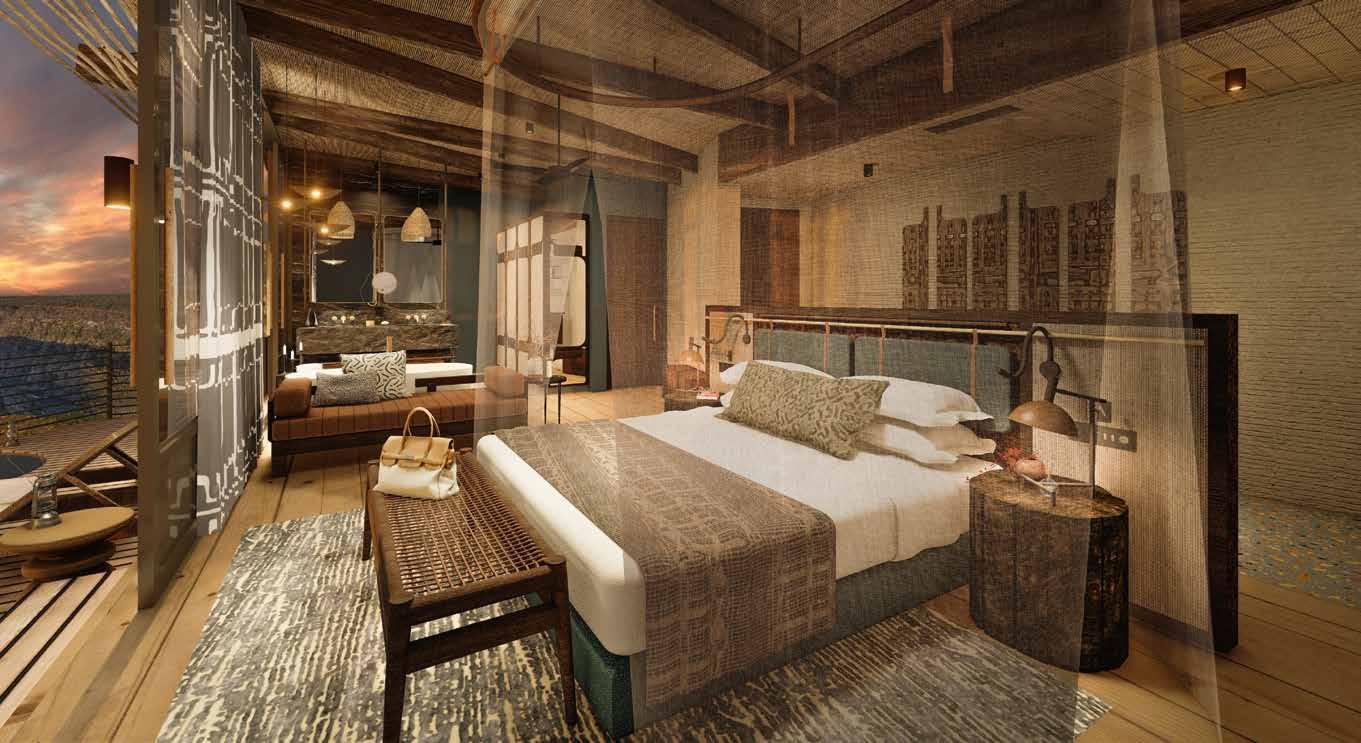
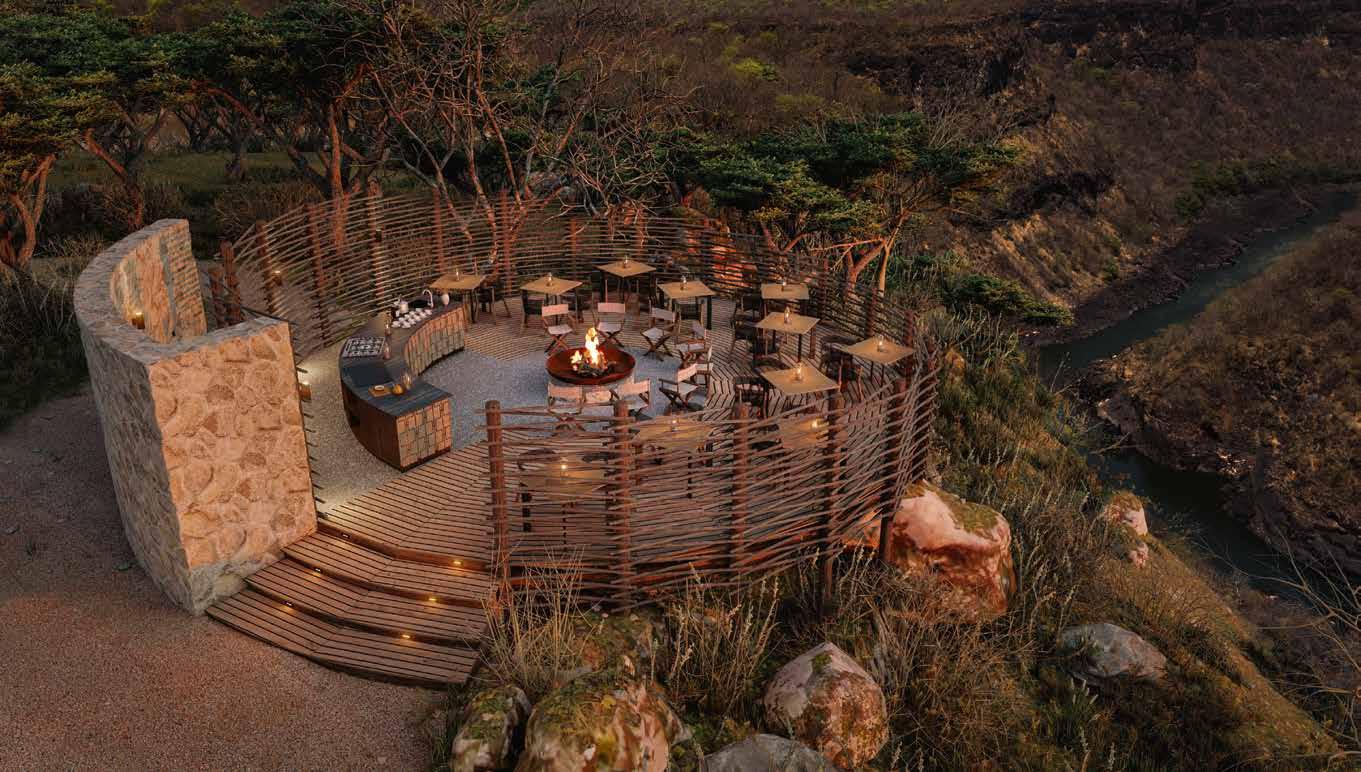
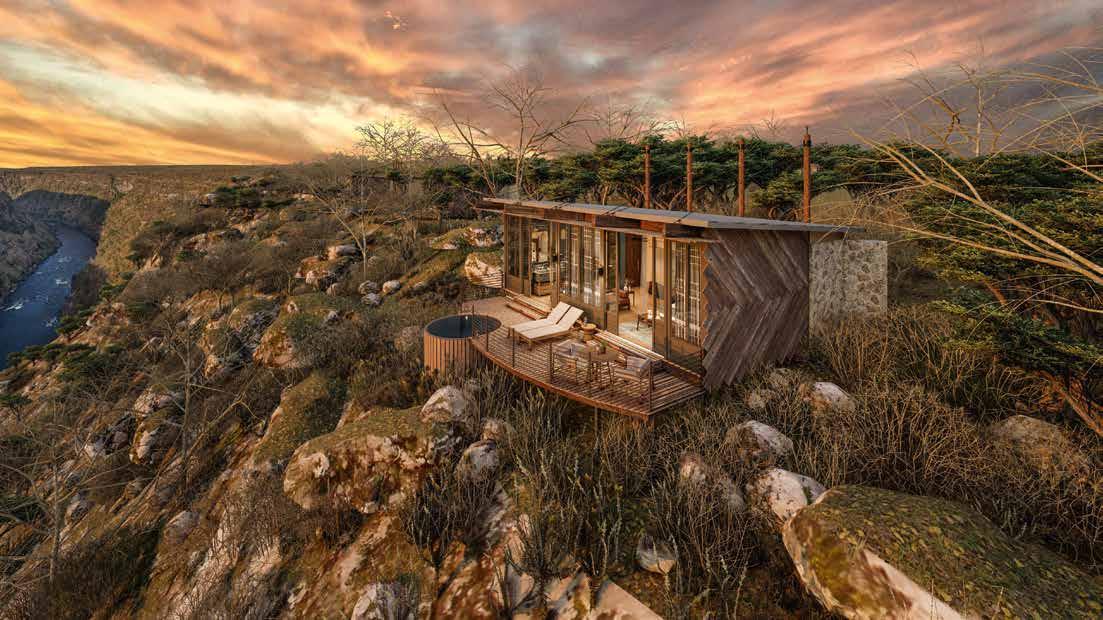
“WE WANTED THE ARCHITECTURE TO BE A SUBTLE FRAME FOR THE LANDSCAPE.”
– NICK RANDALL, EXPERIENCE ARCHITECTS
Accommodation at Bupenyu is equally spectacular. In addition to an exclusive two-bedroom family villa, the lodge features 11 freestanding suites, each designed to maximise space, comfort, and privacy. With floor-to-ceiling glass, generous decks, and private plunge pools, every suite opens up to breathtaking views of the gorge and beyond.
Step indoors and the aesthetic features a refined blend of natural tones and contemporary African creativity thanks to interior designer Amy Kidger of Hinterland Studio.
“We took inspiration from the landscape, which is reflected in patterns used throughout the interiors, but we also referenced the local Tsonga people, incorporating their traditional motifs in cabinetry and textiles,” says Kidger. “We also included local basketry and weaving for texture, finding a balance between local and contemporary African design.”
The result is a tactile, layered interior where basketry, handwoven textiles, and artisan-made decor provide a sense of place, while the modern finishes ensure seamless comfort. Although major furnishings were sourced from South Africa, much of the intricate detail work – including ceiling panels and decorative pieces – was produced in collaboration with local craftspeople, many of whom were also involved in the lodge’s construction.
From the suites, a network of natural pathways weaves through stands of rare miombo woodland, leading to the main lodge, pool, and wellness areas. This journey through nature embodies Bupenyu’s invitation to slow down and reconnect with the landscape.
Because underpinning the Bupenyu Lodge experience is an ethos of restorative luxury. It’s a place to exhale, to sleep late, indulge in breakfast in bed, take a meditative dip in your plunge pool, or unwind with a spa treatment overlooking the gorge. But for those who do feel called to adventure, the myriad experiences of Victoria Falls are just a short drive away.
Head into town for a guided tour of Mosi-oa-Tunya: ‘the smoke that thunders’. Thrill-seekers may choose white-water rafting, ziplining across the gorge, or bungee jumping off the Victoria Falls Bridge, before returning to the lodge for cocktails on the terrace and dining under the stars.
Bupenyu means ‘life’ in Zimbabwe’s Shona language, and this extraordinary lodge delivers just that: a life-affirming escape that fuses architecture, place and purpose into one remarkable experience high above the rushing waters of the Zambezi.

SCAN TO BOOK BUPENYU LODGE
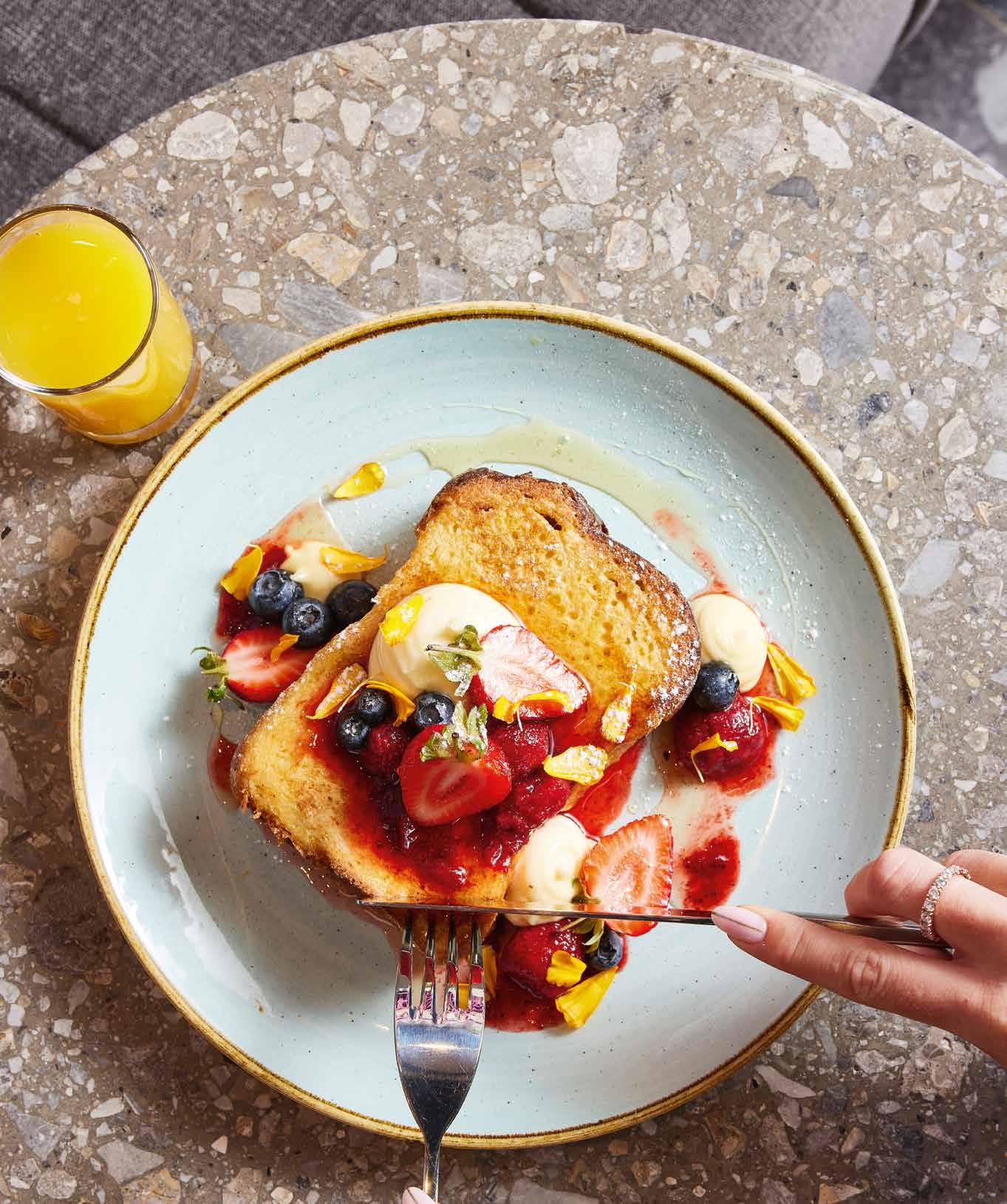
MAKE SUNDAYS COUNT
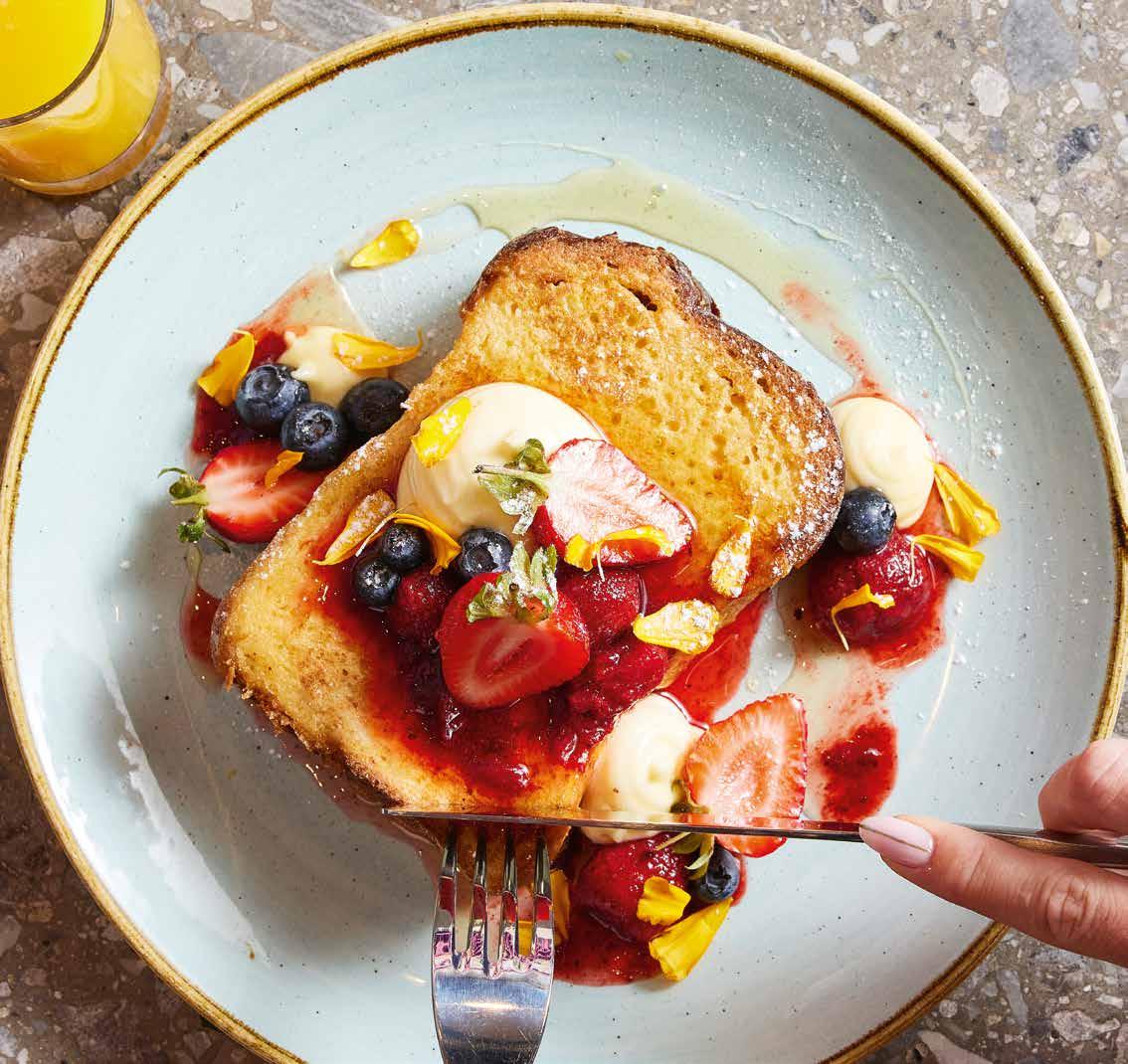
BY ANDREW THOMPSON
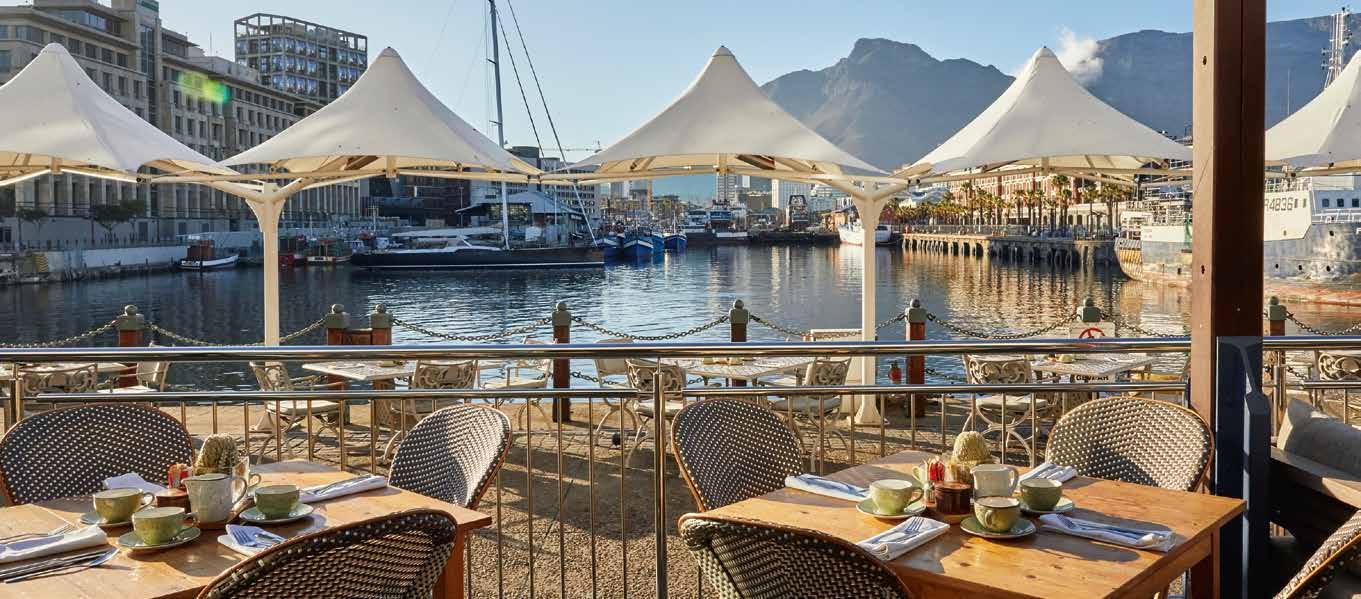
There’s something sacred about a Sunday morning done right, whether you’re staying put in your home city or exploring a new one. Not the frantic kind filled with laundry, a dash to the supermarket, or a croissant scoffed en route to your tour group. But the slow, luxuriant kind: the clink of cutlery on porcelain, a perfect flat white, the pop of a second bottle of bubbly. In Cape Town, you might also add the murmur of the ocean, the honk of a departing ship, or the soft strains of courtyard jazz. Like many cosmopolitan cities, Cape Town has turned brunch into a practised art, but here, it rarely calls for polite silence or proper shoes. It’s part theatre, part lavishly laid-back feast, and always memorable.
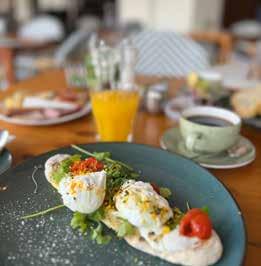

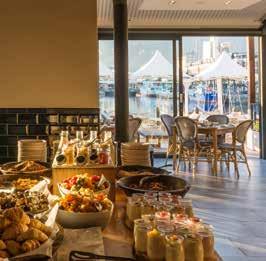
1Brunch With A View At Ginja
Let’s begin where brunch ticks all the boxes: Ginja Restaurant. Located between the water’s edge and the vibey V&A Waterfront, with views of both, Ginja doesn’t just serve brunch – it stages it. This is where camera-toting tourists, their hair tousled by the southeaster, mix with locals dressed for Sunday comfort. Guests come to stare wistfully at the yachts and ponder the day’s most complex questions, like “Do I want the eggs Benedict or the fluffy flapjacks?” (The answer is yes.)
Ginja’s indoor-outdoor space, framed by floor-to-ceiling glass, channels European chic, while the food stays rooted in what’s local and seasonal. The real draw is outside, where the terrace opens onto one of the best panoramic views in Cape Town. But if the weather turns, the indoor seating offers a front-row seat to an approaching storm.
There’s something quietly confident about how brunch at Ginja unfolds. No gimmicks, no bottomless mimosas shuffled out in sticky glasses. Just a glass of fine bubbly with top-quality local produce, a heady mix of local and foreign company, and the comforting possibility of a third croissant without judgement. The team doesn’t hover or rush – this is brunch, after all, and it only winds down in the mid-afternoon – but they ’re somehow always there when you need them.
When you eventually roll out, you’ll be right in the heart of the Waterfront, perfectly placed to walk off the feast. If you’re lucky enough to be staying in the Victoria & Alfred Hotel upstairs, you could also hop aboard an Up Cycle bicycle outside the main entrance and get a few kilometres behind you. But who are we kidding? You’ll most likely be tempted back up to your suite for a continuation of the famous Cape Town views.
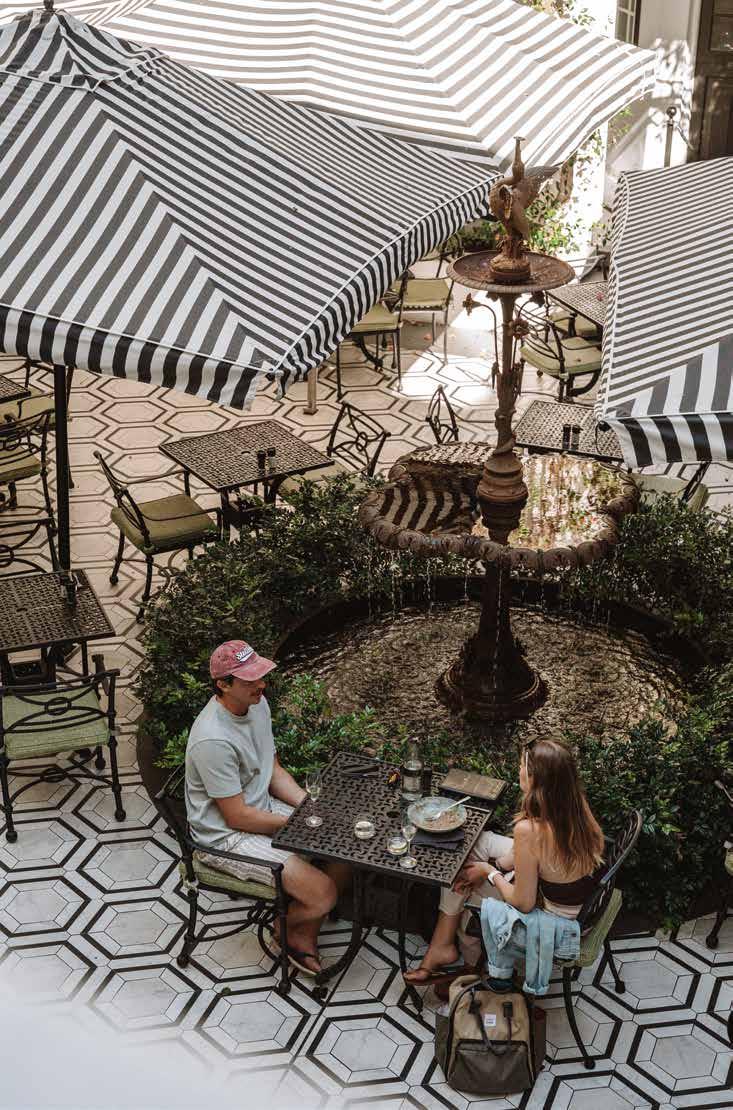

Across Town, A Courtyard Classic
Ten minutes away, but a world apart in mood, is The Winchester Hotel. If Ginja is your stylish aunt, who once, allegedly, modelled in Milan, The Winchester is your debonair grandfather, who drinks spicy Bloody Marys and spins the most infectious yarns. Here, the Sunday vibe is different: less marina, more manor.
Shoreditch, the hotel restaurant, spills from the outside balcony to indoor comfort and onto a lush courtyard filled with pink and purple bougainvillea. It’s achingly photogenic and always buzzing with light chatter from brunchers. The menu is quietly glorious, with a smoky South African twist woven through the classics. The brunch standards are all there – eggs Benedict with homemade rosti, bruschetta with smoked salmon, and classic shakshuka are favourites – but mixing it up with pancakes or waffles is also perfectly acceptable.
Some hotel brunches feel like you’ve accidentally walked into a conference, but at The Winchester, it feels like you’ve arrived at a members’ club. There’s a reason to linger, to order another pot of tea or that extra glass of bubbly. And then there’s the Promenade, just outside, where you can take a walk afterwards to justify getting the bruschetta and the waffles.
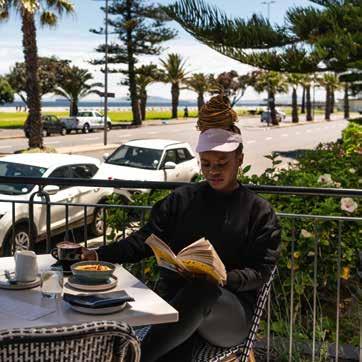

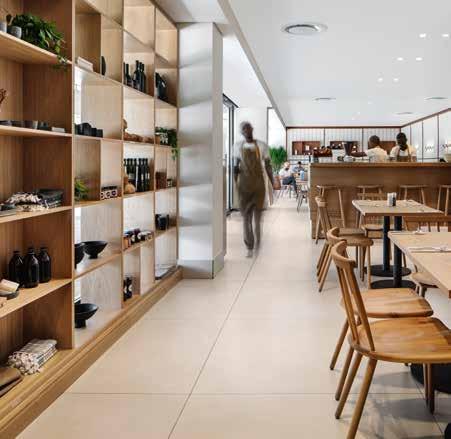

Bonus: Downtown Brunching

In the heart of the city, on the ground floor of The Onyx Hotel, MRKT offers a more casual but no less classy take on the brunch tradition. This isn’t the mimosa-fuelled frenzy you’ll find at some city spots; it’s clean-lined, contemporary, and confident. The kind of place you could come alone with a book or meet a friend who’s running late but worth waiting for – especially over the exquisite coffees created by the passionate barista.
Expect crisp service, seriously good coffee, and a menu that leans into fresh bakes, buttery croissants, and breakfast bowls that are almost too pretty to eat. Almost. Of course, there are also breakfast wraps, warm winter oats, perfectly fried eggs on freshly baked bread, and all the thoughtful touches that make it feel like a New York-style breakfast – minus the rush. It’s Cape Town at its most refined: unhurried, stylish, and secretly satisfying.
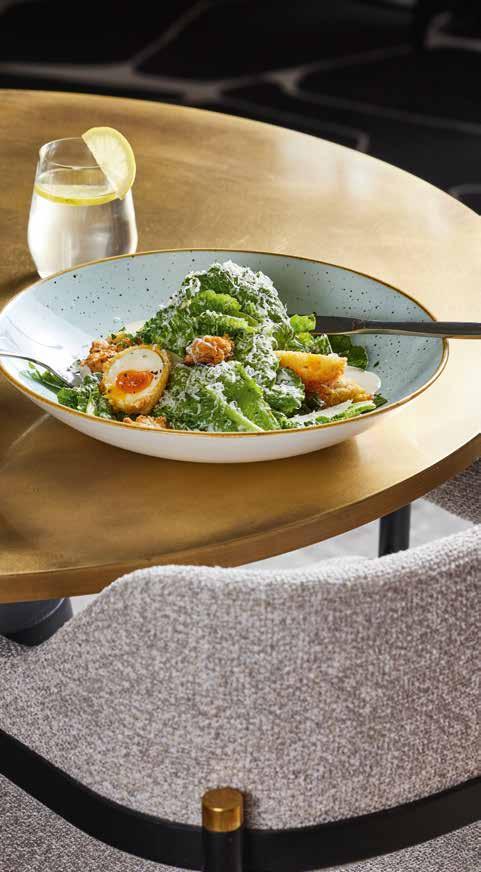
The Rockefeller’s Urban Hub
For those who see brunch less as a sunrise celebration and more as damage control after Saturday night, The Rockefeller Hotel has you covered. This is breakfast rebranded: designer interiors, a moody lounge buzz, and a full English or Continental buffet that will silence any hangover-induced regrets.
The space is open-plan and buzzing, with a come-as-you-are vibe that makes even yesterday’s eyeliner feel intentional. There’s no need to dress up, but you’ll leave feeling a little more fashionable if by a strange form of osmosis.
Alongside the generous buffet, you’ll find eggs every which way, fresh fruit, yoghurt, and coffee strong enough to reset your weekend. Or, if you want to continue the party, lean into the all-you-can-drink Prosecco mimosas available as an add-on to any weekend breakfast until noon.
Make It A Habit, Not A One-Off
Brunch sceptics will say it’s just breakfast with better PR. But honestly, who’s keeping score? There are few better ways to spend a Sunday than in a beautiful setting with a coffee in one hand, something flaky and buttery in the other, and nowhere else to be. So, this Sunday, consider opting out of chaos. Skip the hurried lobby croissant and coffee chaser or the to-go box eaten in the back of your tour van, and slow your morning down. Whether it’s mountain views at Ginja, courtyard charm at The Winchester, a chic urban coffee at MRKT, or a fashionable foreshore feast at The Rockefeller, the city has its Sunday rhythm sorted. You just have to show up hungry.
WELLNESS
BY THE SEA
Revitalise your mind and body at The Winchester Hotel on Cape Town’s Atlantic Seaboard
BY WANITA NICOL
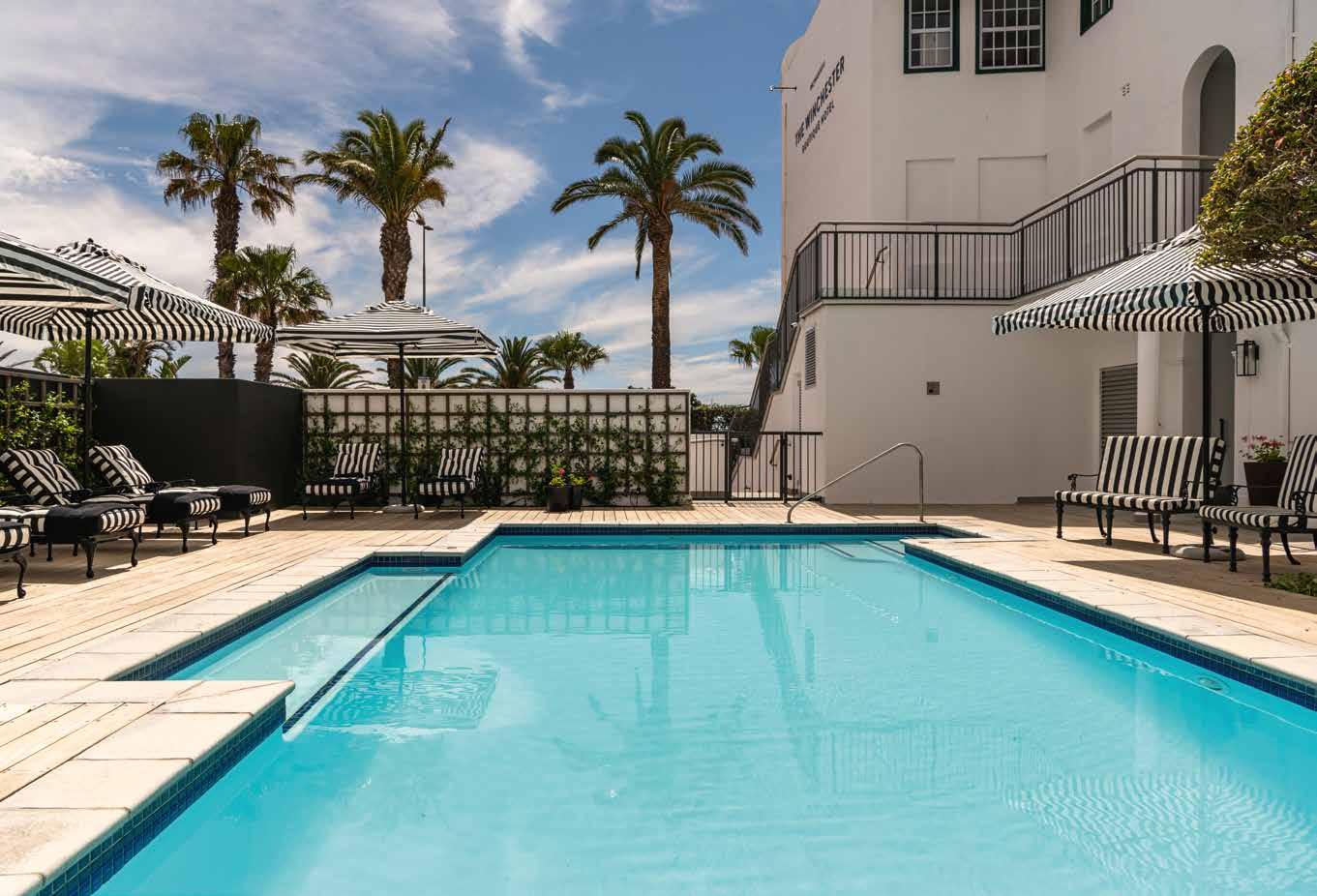

SCAN TO BOOK THE WINCHESTER HOTEL
Travelling does wonders for the mind. A break from routine can be just what a weary brain needs to reset, de-stress and escape the panic-loop of anxiety. When it comes to the body, however, stepping out of your routine can have the opposite effect, derailing your exercise habit and even setting you back – cardio fitness and muscle mass start to decrease after a two-to-three-week hiatus. The wellness offerings at the Winchester Hotel by Newmark are designed so you can rejuvenate your mind while still maintaining a healthy body.
POWER WALKS
Staying active doesn’t have to mean packing your regular gym routine into your suitcase. Brisk walking is an underrated form of exercise that does wonders for your cardiovascular system – and Cape Town’s famous seaside Promenade is one of the most beautiful walking paths in the country.
A guided power walk with personal trainer Dazza Reid will take you past iconic landmarks like Green Point Lighthouse, Green Point Park, and Cape Town Stadium, which hosted several nail-biting matches during the 2010 FIFA World Cup and is now home to the DHL Stormers rugby franchise, as well as World Rugby champions, the Springboks, when they’re in town.
Consider it interval training –you’ll stop frequently to take in the undulating swell of the Atlantic Ocean stretching to the horizon, with kelp forest canopies bobbing in the waves, and perhaps even frolicking dolphins or seals.
If you’re a dog person, you’ll likely pause to pet friendly pooches, too – the Promenade is a popular spot not only for Cape Town’s joggers and outdoor gym communities but also a favourite for local hounds to enjoy scenic walkies
STRENGTH/STRETCH AND TONE
For those looking for a more comprehensive and structured workout, Dazza offers both private and group training sessions in the hotel gym, which is well equipped with Technogym cardio equipment, a broad range of dumbbells and kettlebells and a variety of functional training tools.
After hours cooped up in a plane, a guided stretch session will ease the stiffness from your muscles. And if lifting is what your antsy body needs, Dazza will tailor a session to suit your needs and fitness level.
“As a fitness studio owner, my goal has always been to make every guest feel like they belong, and that fitness can be enjoyable, not intimidating,” he says. “My approach is to create a welcoming, nonjudgmental environment where every guest feels seen and supported. I start by listening, asking questions, and getting a feel for the guest’s fitness level and goals. This also helps break any awkwardness. Every session is personalised, keeping it creative. Whether they’re in their 20s or 70s, I modify exercises to suit their fitness level and energy that day.”
REST AND RECOVERY
Aside from staying active, recovery is essential for both your body and mind. Be sure to visit the Sanctuary Spa at the Winchester at least once during your stay.
Tranquil surroundings, refreshing herbal teas and essential oils infused with fragrant local fynbos combine with touch therapies to create a multisensory restorative experience.
From CBD sports massage to lymphdrainage therapy to a special jet-lag massage, there’s a treatment for every need – as well as a selection of purely indulgent therapies. Consider it a gift from you to you.
Whether you’re travelling for work or leisure, turn your trip into a retreat – emphasis on treat!



The New Nomad
South Africa’s hybrid hotels are calling the world’s remote workers
BY ANDREW THOMPSON


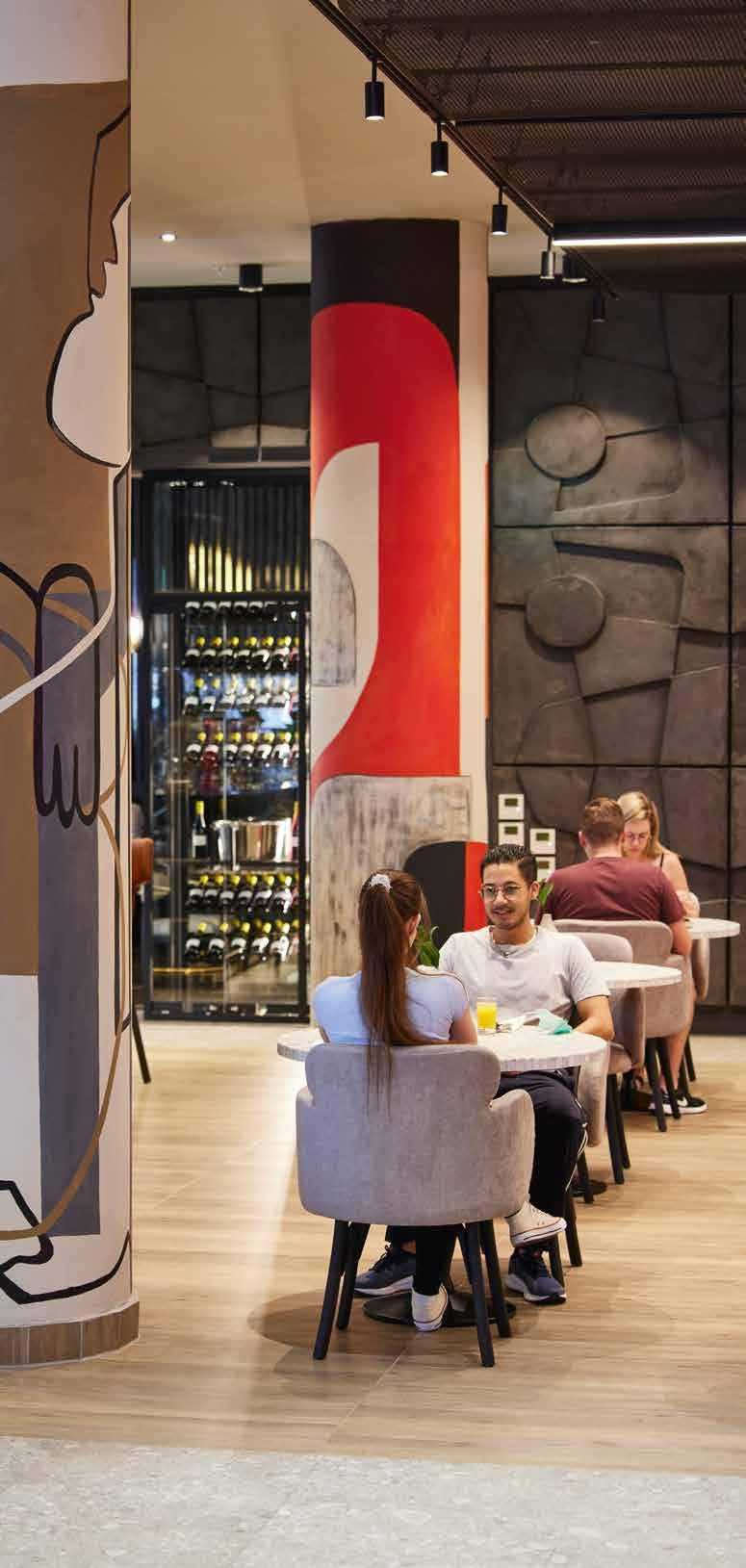
At an oak table in a trendy Cape Town Foreshore hotel coffee shop, removed from the low hum of rush-hour traffic, a laptop screen lights up with the white of a blank document. A cortado sits at the guest’s elbow alongside a fresh pastry. Two tables down, someone quietly closes a deal in Dutch. And a few floors up, a guest answers morning emails on his phone while waiting for the elevator to his room after a quick gym session. It’s not quite an office, not quite a hotel, and not home – and it’s all by design.
Across South Africa’s major cities, hybrid properties have emerged as home bases for a new kind of traveller – part explorer, part executive, part holidaymaker – who increasingly favours lifestyle-rich hotels over isolated rentals or conventional workspaces.
With South Africa’s long-awaited remote work visa now finally in play, the country is positioning itself as one of the world’s most compelling destinations for long-stay professionals seeking more than fast Wi-Fi. And the country’s hospitality is ready to accept them with open arms.
WELCOME TO VISA-FRIENDLY LIVING
After several years of anticipation, South Africa officially introduced its version of a remote work visa in 2024. The permit, like many in place worldwide, allows qualifying foreign nationals to live and work in South Africa for up to three years while maintaining their employment abroad.
The criteria are relatively accessible and include: applicants must earn the equivalent of R650 796 per year, show proof of employment or self-employment outside South Africa, and provide evidence of good health without needing to prove existing insurance.
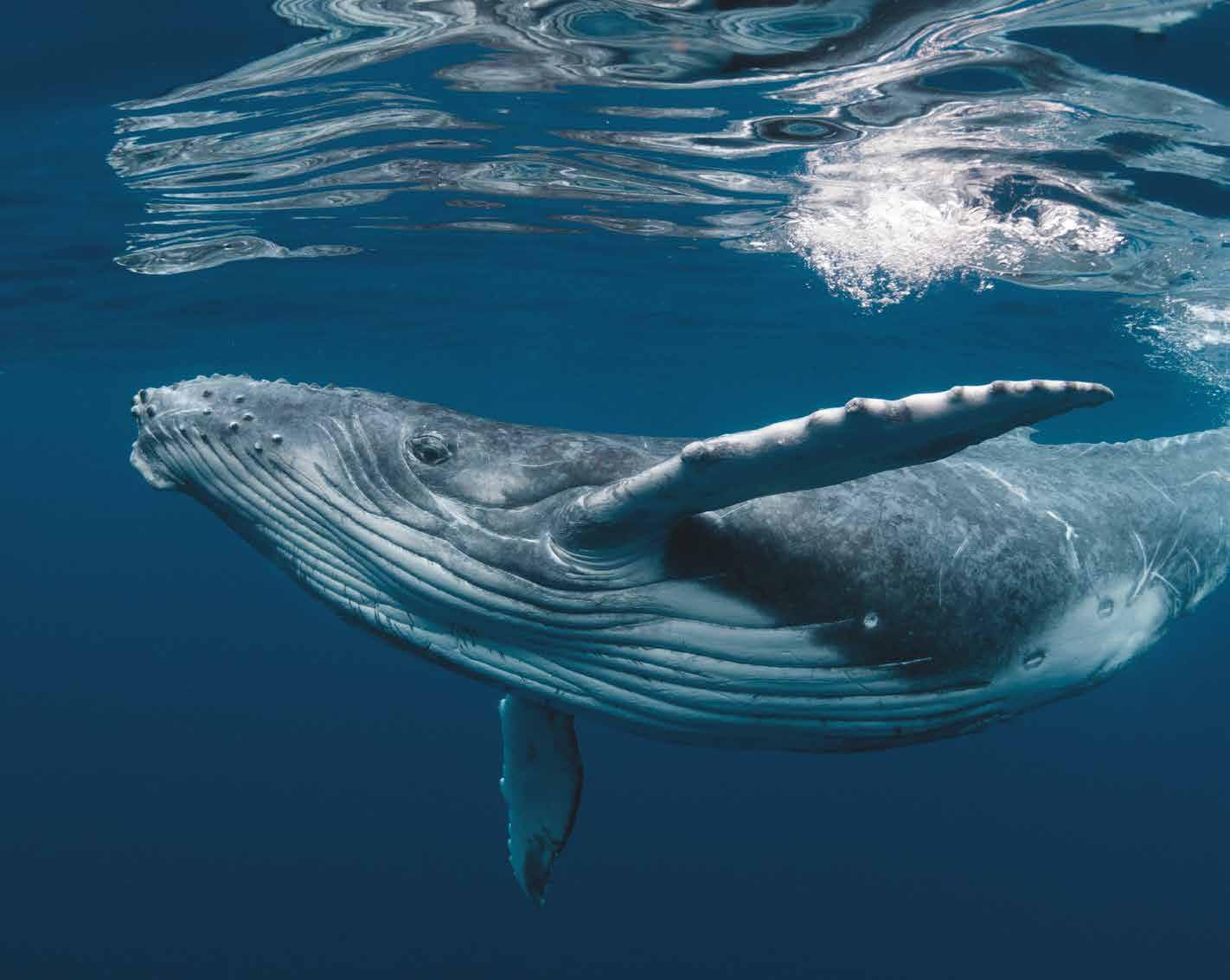
BELIEVE IN BETTER


It’s a generous offer to entice global long-term digital nomads. And, crucially, the visa acknowledges the blurred lines between work and leisure in the modern era, lending it perfectly to the South African landscape.
And with European cities increasingly priced out of reach and Asian hubs offering inconsistent internet or cultural differences, South Africa now finds itself in the sweet spot – a country with the infrastructure, cost of living, and familiar lifestyle appeal to rival the likes of Lisbon or Bali.
“Over the years, we’ve seen a steady stream of digital nomads from all over the world join our community,” says Lizelle Ellmann van Rhyn, founder of one of the city’s first co-working spaces, Cape Town Office. “More recently, we’ve seen digital nomads stay for extended periods, taking advantage of the changes in South Africa’s visa regulations.”
HOTELS AS HYBRID HAVENS
While visa approvals slowly ramp up, it’s South Africa’s hospitality industry that’s laying the groundwork to attract remote workers. Newmark is ahead of the curve with a growing network of lifestyle properties quietly positioning themselves at the heart of this evolution.

At The Rockefeller Hotel in Cape Town, the phrase “lounge, work, play and stay” isn’t just branding – it’s a daily reality. Guests can start their mornings in the café, send a few emails after breakfast, or head to a nearby co-working space for more focused work. They can then schedule in-person meetings over sushi at the downstairs restaurant, followed by unwinding in the rooftop bar with views of the city skyline.
It’s a building that functions like a vertical village, combining a residence, office and social club all into one sleek package.
Rooms at The Rockefeller include basic kitchenettes and fast Wi-Fi. But it’s the integration of common spaces – stylish lounges, open-seating restaurants, and bookable boardrooms – that elevates these hotels beyond conventional accommodation.
At The Catalyst Hotel in Johannesburg’s influential Sandton CBD, the model takes a more corporate form. Designed for professionals needing fast access to the Gautrain, OR Tambo International Airport, and nearby financial headquarters, the aparthotel offers fully self-catering suites and access to the popular Kashew Restaurant.
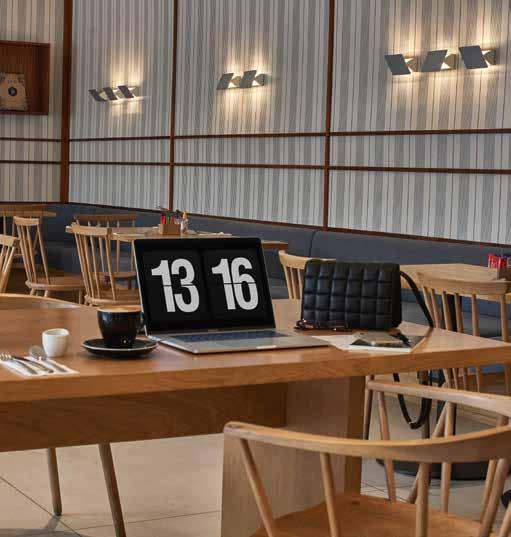
Between meetings, guests spill into the elegant lobby, where espresso machines, laptop chargers and natural light create an infectious productivity zone. And come afternoon, the ground-floor lap pool provides the perfect reprieve from the day’s work and Gauteng heat.
In contrast, The Onyx Hotel in Cape Town’s historic Foreshore district offers a more mellow – but no less connected – urban vibe. With MRKT and YU on the ground floor serving as informal meeting, entertainment and dining spots for locals and visitors alike, and Granite Bar’s fourth-floor terrace offering a space for casual work or relaxation above the city, The Onyx feels like the kind of place you might accidentally live in for six months.
THIRD SPACES, FIRST-CLASS AMENITIES
What sets properties like these apart is their fluency in the language of “third spaces” – the hybrid environments that exist between home and office. Coined by sociologist Ray Oldenburg in the 1980s, the term originally referred to local cafés and community centres. But today, hotels like The Rockefeller, Catalyst and Onyx are reinventing the concept for a postpandemic world.
Qualified foreigners are taking advantage of South Africa’s recently approved remote-work visa. Opposite page, from top: The Onyx Hotel offers the perfect zone for remote work on the move; The Rockefeller Hotel is a hub for young professionals. And the Catalyst in downtown Sandton is the perfect hub for young professionals in Gauteng.
SCAN TO BOOK THE ONYX HOTEL
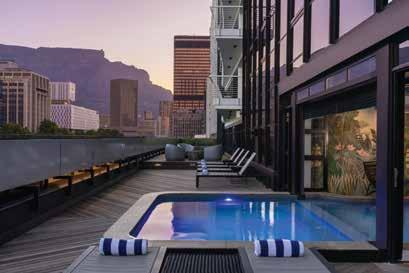
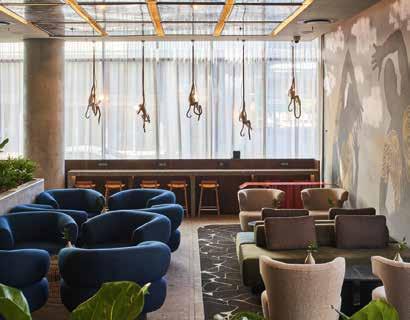
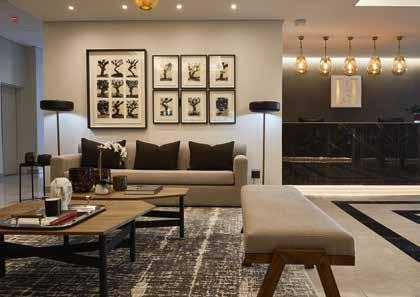


These are spaces where locals and visitors blend. While short-term bookings are welcomed, longer stays from permanent residents and digital nomads combine to give each property a unique edge. A tourist waiting for a sightseeing bus might share an elevator with a permanent resident and a digital nomad looking for a vacant workspace. And it’s in spaces like these that business isn’t confined to boardrooms, and leisure doesn’t wait until 5pm. The line between lifestyle and labour is intentionally blurred – to the benefit of everyone involved.
“Working remotely as a software engineer can become very lonely when you’re self-employed,” says Malik, a German software engineer and musician who has chosen Cape Town as his temporary base. “Being here is a nice social environment, and I’m really enjoying that. I came to Cape Town for the good waves and the good people – to experience a new culture, new people, new environments.”
It’s helpful, too, that South African hospitality tends to be warm, unobtrusive, and accommodating. Staff quickly learn your name and your drink order. A new guest arrives, and the lobby buzz resets – a polite nod here, a quiet phone call there. Everyone belongs, but no one is in your space. In many ways, these hotels have become the new living rooms of the city.
THE CASE FOR SOUTH AFRICA
Beyond their stylish interiors and thoughtful amenities, what makes hotels like these truly viable for digital nomads is their location in South African cities, each undergoing a quiet renaissance.
Cape Town remains one of the most naturally beautiful cities on earth – a place where a 7am surf is followed by a 9am pitch meeting. Where the day wraps up with a hike and a world-class meal, and where tech start-ups rub shoulders with boutique local fashion labels.
Johannesburg, long misjudged as merely a business capital, is undergoing a lifestyle shift. Neighbourhoods like Rosebank, Parkhurst, and Maboneng have become diverse cultural melting pots, while Sandton remains the beating financial heart. With The Catalyst offering short- or
long-stay options near its centre, the city suddenly feels more liveable.
The country’s cost of living is favourable when benchmarked against European or American urban centres, and its time zone (UTC +2) allows for real-time collaboration with Europe and the United Kingdom.
Add in direct flights to major global hubs (including several which now head straight to Cape Town), an Englishspeaking population, and reliable infrastructure in key nodes, and it becomes clear why South Africa is moving up the global digital nomad ranks.
BUILDING YOUR BASE
For remote professionals considering a few weeks – or even a few months – on South African soil, the decision of where to stay is no longer an afterthought; it’s a strategic choice that can make or break the experience.
Choose poorly, and you’re stuck in a soulless Airbnb with patchy Wi-Fi and zero social life. Choose well, and your hotel becomes the cornerstone of your new hybrid lifestyle.
The Catalyst, with its balance of business utility and high-end comfort, is ideal for those who want proximity to meetings but also the freedom to unwind in peace. The Rockefeller lends itself to creative professionals who thrive in a vibrant urban environment with arts and culture at their doorstep. The Onyx, effortlessly cool and deeply functional, is for the modern multi-hyphenate founder, foodie, and friend.
Properties like these offer what digital nomads crave most: a balance of stability and spontaneity. The predictability of a good mattress, functional kitchen, highspeed internet, privacy with public spaces – plus the luxury of a new skyline when you open your curtains and an unexplored city at ground level.
And in a world where your daily commute can be a walk to the lobby lounge, and your water cooler chat is over cocktails at a rooftop bar, the future of work – and travel – may already be here.

SCAN TO BOOK THE ROCKEFELLER HOTEL
SCAN TO BOOK THE CATALYST HOTEL
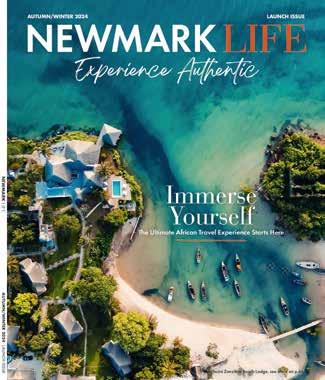
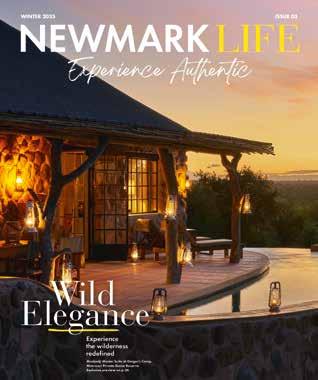
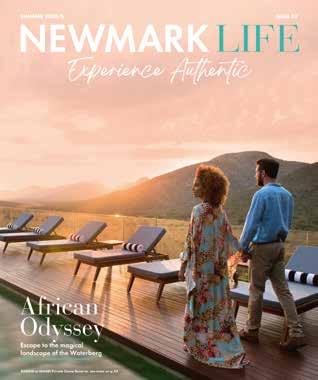


Big City Lights
Whether you’re travelling for business or just looking for a more homely stay, The Onyx Hotel in Cape Town gives you the convenience of a hotel with the comfort of home
BY WANITA NICOL
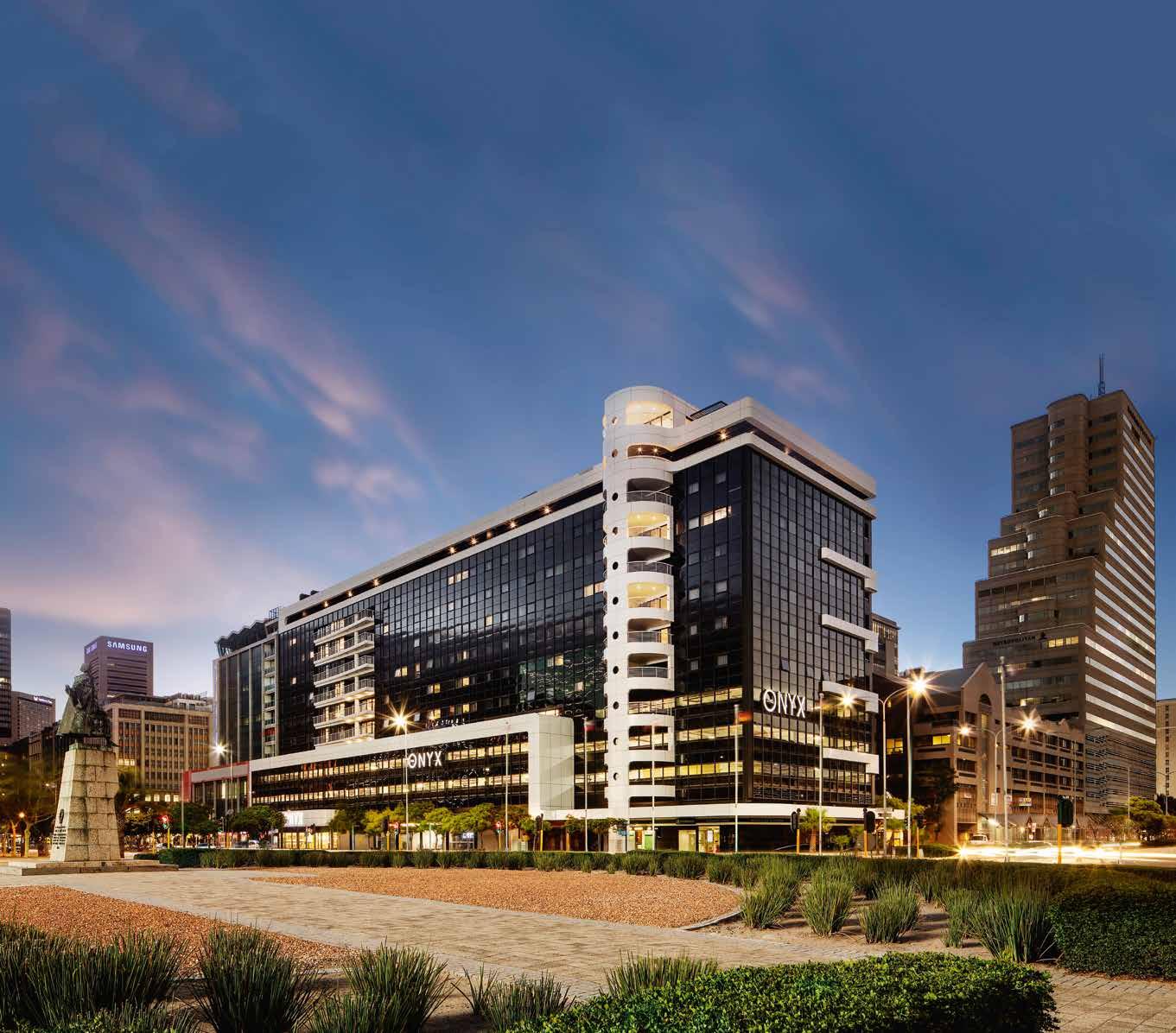
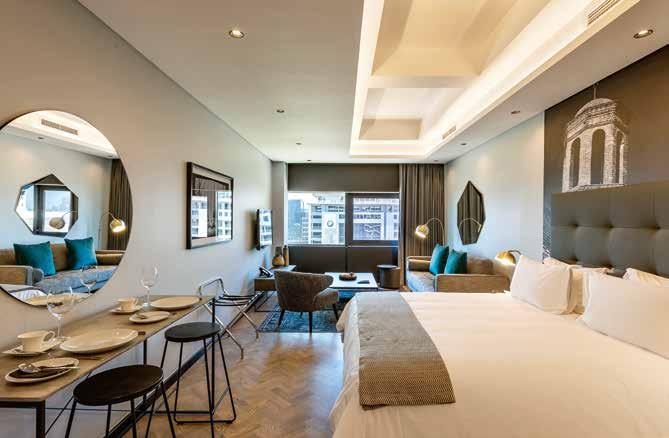
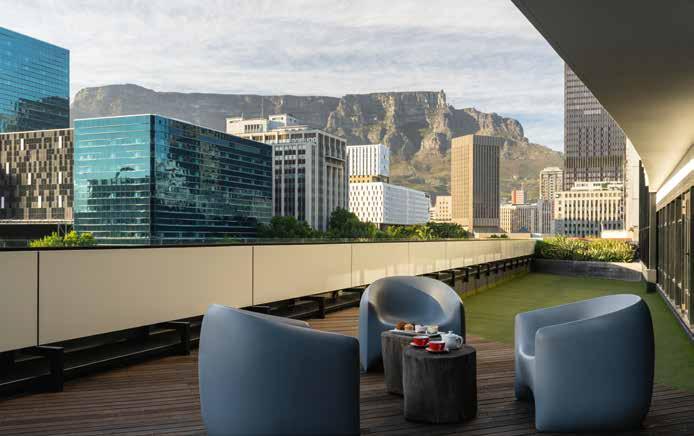
Travelling for business can feel like a chore – even when your destination is one of the world’s most beautiful cities. After a long day of meetings or conferencing, The Onyx’s apartment-style stays are the next best thing to your own bed.
COMPACT COMFORT
The Onyx has a homely, upmarketapartment-block persona that immediately makes you exhale the stress of the day. Compact, yet far from cramped, the apartments feel almost familiar – even if you’ve never been there before.
With a comfy lounge and dining area, fully equipped kitchenette, king-sized bed and in-room air-conditioning to get the temperature just right, there’s no reason why you shouldn’t immediately kick off your shoes and slip into comfy pants (or the robe provided) for a night of well-earned chill time.
If you must fire up your laptop, complimentary high-speed Wi-Fi in the apartment will help you tick off your deliverables hassle-free.
TRAFFIC-FREE CONVENIENCE
Once a neglected appendix to the CBD, Cape Town’s Foreshore has become a hub of industry, where modern high-rises gleam in the sunlight by day and light up at night. This vibrant cityscape is your view – and if it weren’t for ubiquitous Table Mountain always peeking out from behind the buildings, you could almost be in Midtown Manhattan. Almost – because Cape Town’s buildings are not the towering skyscrapers you’ll find in other major cities.
Tucked in a bowl between the mountain’s lower slopes and Table Bay
harbour, The Mother City’s CBD is smaller than those of many other urban centres; almost quaint. It has the energy of a city but without the impersonal coldness, in the same way that The Onyx has the convenience of a hotel, but without the stiffness.
It’s a two-minute walk from the CTICC and a five-minute drive from the V&A Waterfront – meaning you never have to waste hours of your day sitting in traffic. If you have time for sightseeing, Camps Bay Beach and the Cableway are also easily accessible.
Cape Town boasts many renowned restaurants that deliver world-class dining experiences, and YU Asian Tapas and Bar, located on the ground floor of The Onyx, is among them. Its vibey setting is ideal for after-work drinks or entertaining clients – just be sure to book in advance; it’s popular with guests and locals alike!
IT’S THE SMALL THINGS
The Onyx isn’t all business – it also caters to families, with two-bedroom apartments available and twin beds instead of a king. But whichever option you choose, it’s the little touches that make your stay special.
Even tall guests can stand directly beneath the high-powered showerhead to wash away frustrations at the end of a long day. Premium cotton linen and comfy pillows lull you to sleep, and with each apartment well-insulated against noise, both from your neighbours and the surrounding city, you can drift off uninterrupted.
If you fancy a home-cooked meal, the kitchens are well-equipped, including stovetops, toasters and fridges.
A stay in The Onyx’s luxury apartments is living small, but living well.
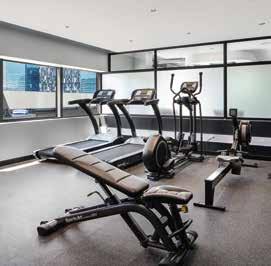
No need to abandon your fitness routine; the hotel gym has a good selection of weights, cardio machines and functional equipment – including a pull-up bar and dip station.

PACK YOUR GYM CLOTHES
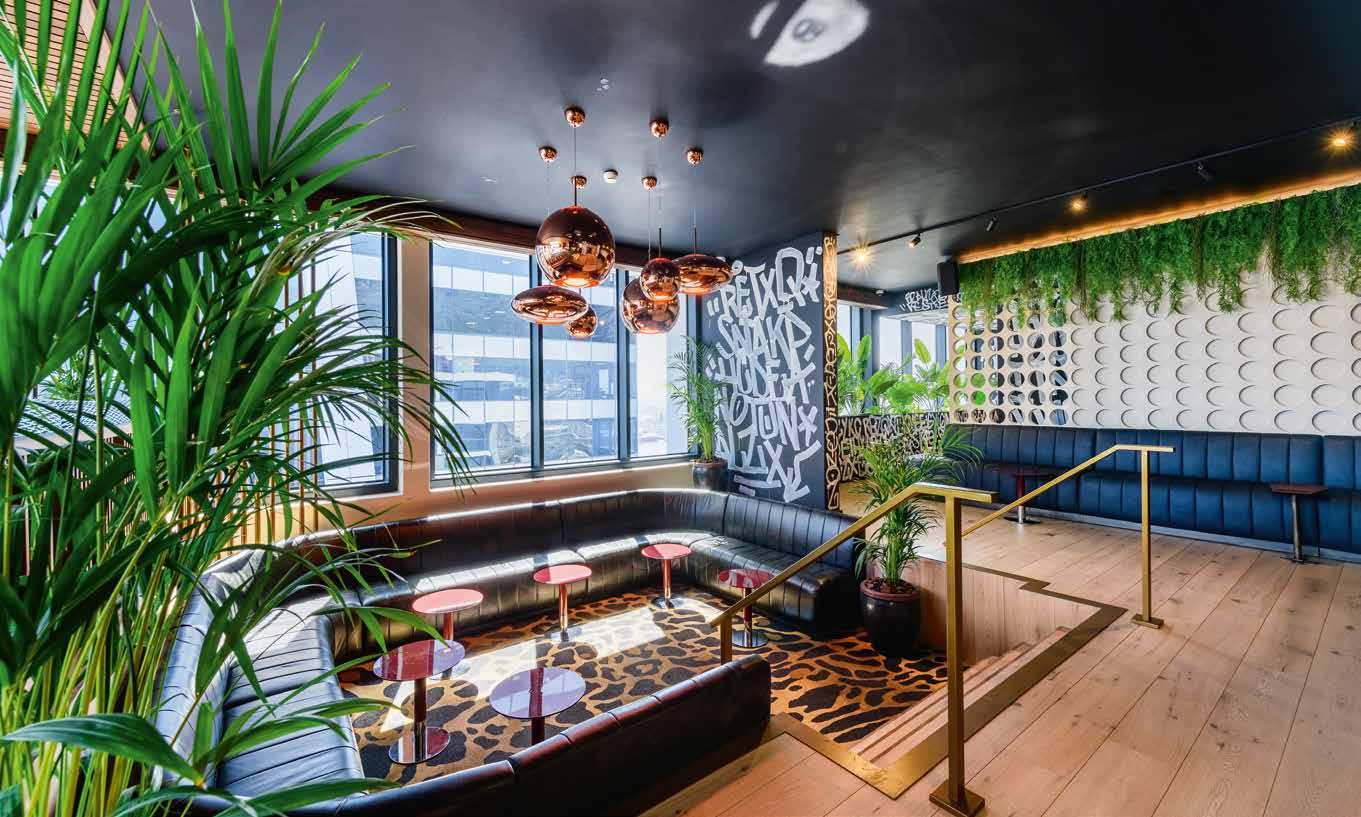
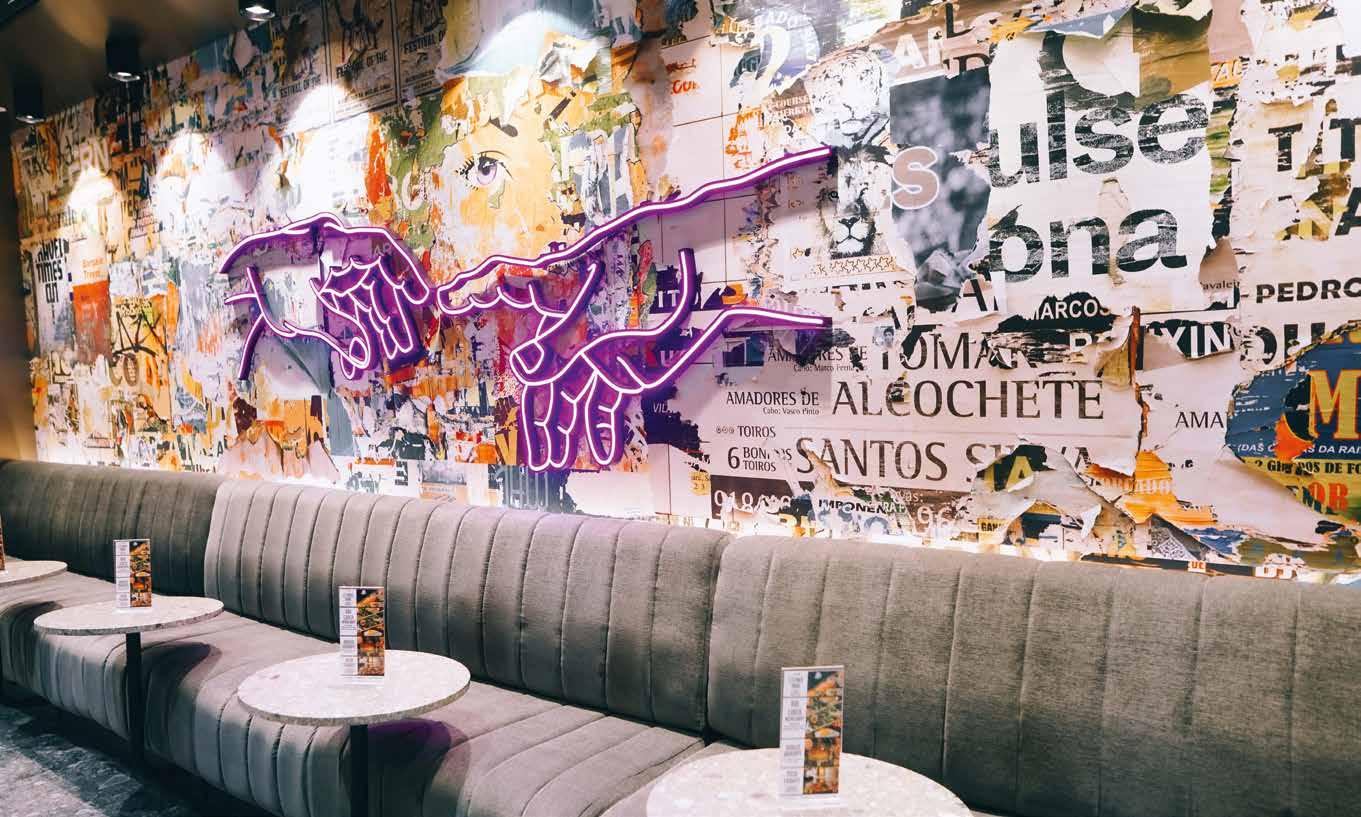
URBAN ENERGY
For those who enjoy being where the action is, The Rockefeller
Hotel & Residences
Cape Town is typically associated with mountains, beaches and wine farms – not a bad rep to have – but there’s another side to The Mother City that you’ll only get to experience when you stay in the city centre itself. Locals refer to it simply as “Town” and there’s an unspoken understanding that, here – downtown – is where business meets pleasure. This is the bold, vibrant side of Cape Town inhabited by The Rockefeller Hotel & Residences.
HEART OF THE ACTION
No matter what time of day you set foot in The Rockefeller, there’s always a buzz. Located in a relatively quiet precinct on Cape Town’s Foreshore – a popular film location for Hollywood blockbusters – the vibrant hotel is the destination. By day, it’s a trendy lunch spot – The Rockefeller Plaza restaurant has a varied menu and extensive drinks selection that cater to different tastes and moods. You can pair a plate of sushi with chilled MCC or wash down a surprisingly decadent toasted sandwich with a pint. The burgers are generous and the pizzas cheesy perfection. By night, it comes alive. Conversation
is where luxury lives large
BY WANITA NICOL
flows over colourful cocktails; decadent dinners are served against a backdrop of music and laughter that carries on late into the night.
But one of The Rockefeller’s best features is STUDIO bar.
HIDDEN HOTSPOT
The Rockefeller is full of surprises. Elegant furnishings share spaces with avant-garde street art that looks straight out of a subway – yet somehow works.
Follow an ordinary-looking passage out of reception and you arrive at Body Rock Gym – a spacious fitness centre with better equipment than you’ll find in many commercial gyms. Watt bikes, a Skillmill, a squat rack, pullup bar and full weights selection are among the state-of-the-art Technogym equipment you can choose from to get a comprehensive workout.
Similarly, a standalone elevator takes you directly to STUDIO. Step in at ground level and step out into a rooftop cocktail lounge perched 18 floors up – high by Cape Town standards – with wraparound views of the city, mountain and harbour.
There’s a pool up there – heated and undercover in winter with a glass roof so you can wallow even on rainy days.
In summer, the roof comes off, allowing you to sunbathe poolside, with refreshing dips to cool off.
With its commanding view of the cityscape and elegant-yet-edgy demeanour, STUDIO is the perfect location for a party – at any time of year.
INNER-CITY SANCTUARY
As vibey as the Rockefeller’s restaurants and bars are though, the hotel’s plush rooms provide an escape from the frivolity – and from the city itself. Here, stillness reigns.
The rooms are elegantly appointed with soft furnishings in neutral palettes that invite you to sink into relaxation instantly.
As convenient as it is in terms of both location and all-day amenities, The Rockefeller isn’t the kind of hotel that you book just as a place to sleep. A stay here will be memorable; an experience in itself. When you’re at The Rockefeller, you are exactly where you’re meant to be.

SCAN TO BOOK THE ROCKEFELLER HOTEL
Where Sandton Unwinds
Escape the bustle of the city with rejuvenating moments at The Catalyst
BY NORMA YOUNG
Situated in the Sandton business district, The Catalyst isn’t just an ideal spot to get deals underway, it’s also the perfect location to celebrate when they’re done. The hotel enables guests to enjoy sophisticated business facilities and leisure amenities with a polished aesthetic, all within one upmarket establishment. Balancing comfort and convenience, it’s a prime destination for memorable experiences.
FOR YOUR GASTRONOMIC PLEASURE
On offer at Kashew are delicious steaks, pizzas, salads and pastas, as well as some bespoke dishes, such as the Kashew shisanyama, the Wagyu beef burger and an eggplant involtini. Whether seated at the bar, dining table or on the outdoor deck, patrons can enjoy premium wines, cocktails, spirits and mocktails. Make sure to try the Kashew Mai Tai, which has orgeat syrup, orange juice and dark spiced rum.
THIS IS WHERE YOU TRULY RELAX
It’s on the first-floor level of the hotel, but the spa is such a calming cocoon, it could well be floating high above the building. “Even though we are in the city, Sanctuary Spa is not just a spa but an escape from the outside world,” explains operations director Micayla Baatjes. “Our slogan is ‘where time stands still’. Once you cross the threshold, time at Sanctuary really does stand still.” The portfolio of treatments are all crafted to enhance the entire being, promote restoration on every level and captivate the senses. A signature option is
the 90-minute Timeless Moments package, which includes a private sauna to relieve tension from the body and mind, and a bespoke fynbos massage utilising essential oils and herbs only found in the Western Cape.
BUT YOU SHOULD REALLY SEE THE ART
Characterised by elegant interiors, the hotel has heightened its aesthetic appeal by installing art pieces in various places, such as around the lobby and at the in-house restaurant, Kashew. Curator Jaclyn Livingstone from upstART Galleries has partnered with The Catalyst to support South African artists as an exhibitor and distributor of their pieces. The collaboration has enabled support for emerging artists and the introduction of new art to the market, which meets the needs of investors and collectors alike. “Some of the art is owned by the hotel and the rest is periodically replaced and used in our gallery space,” notes Jaclyn. Artists whose works are scattered around the hotel include Jibril Linjoum Achu, who was born in Cameroon, and Teboho Makoatsa from South Africa. Achu loves working with different materials, from shredded paper to charcoal to found objects. Makoatsa, who often works with oil on canvas, is most widely known for his striking paintings of a young girl wearing oversized red high-heeled shoes. He hosted a solo exhibition at The Catalyst in 2023, and some of these works are displayed at the hotel.

SCAN TO BOOK
THE CATALYST HOTEL
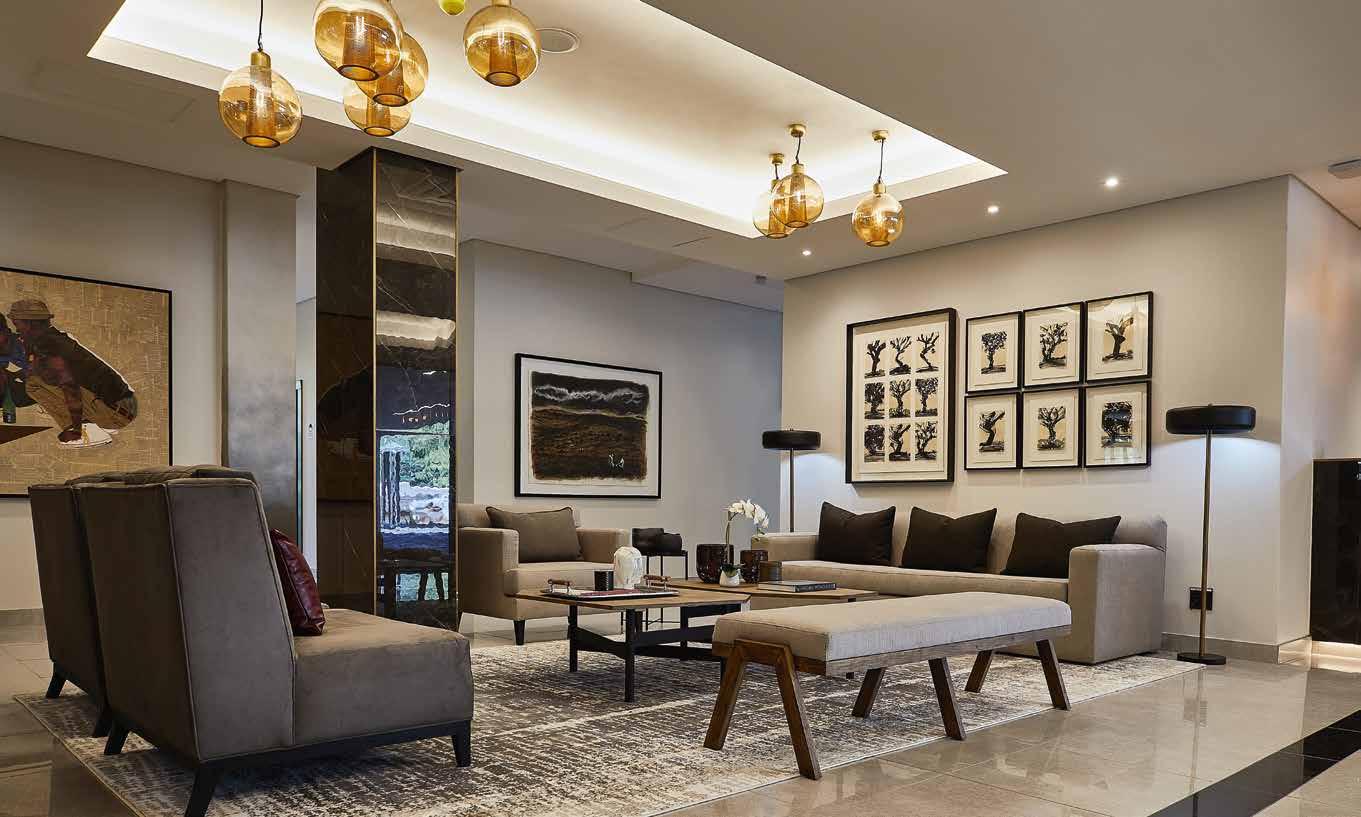
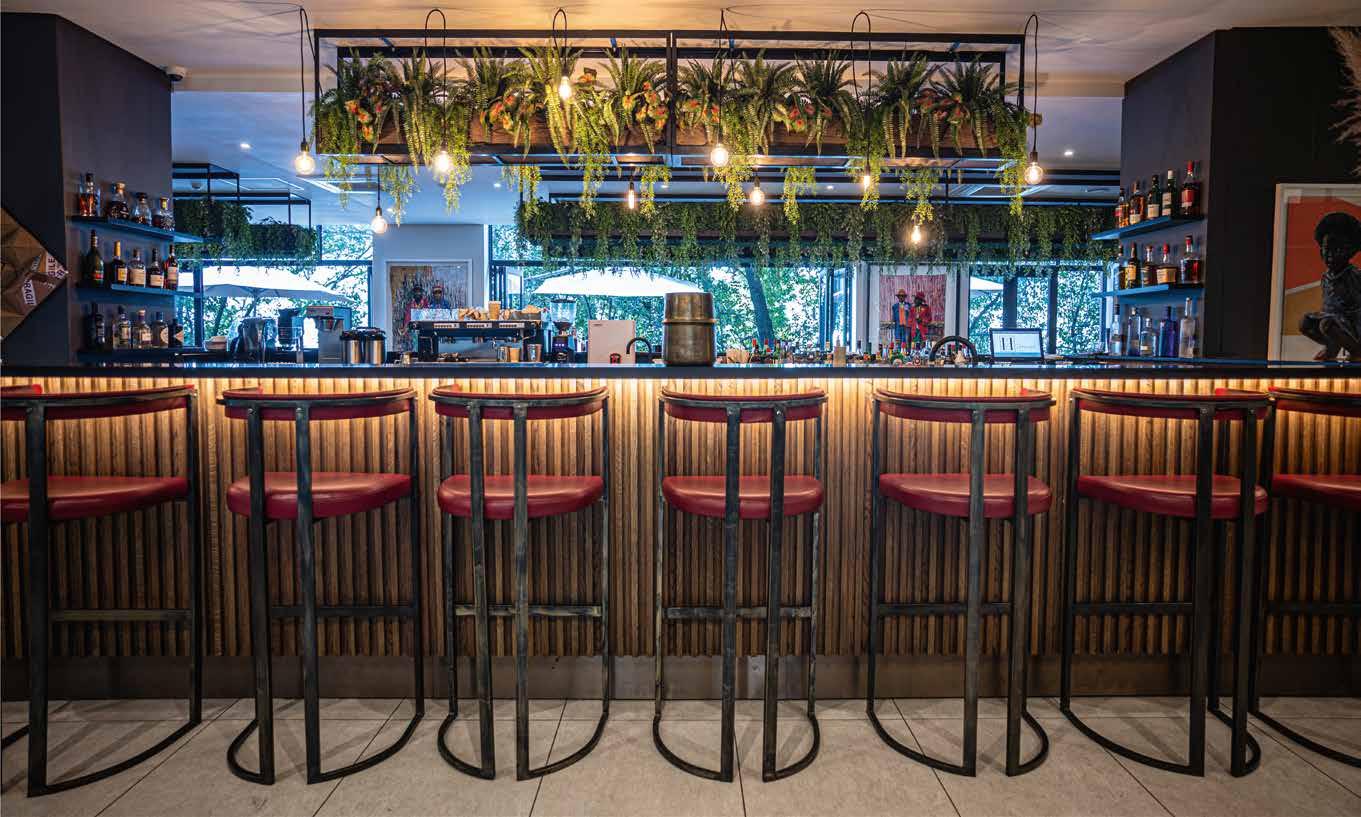
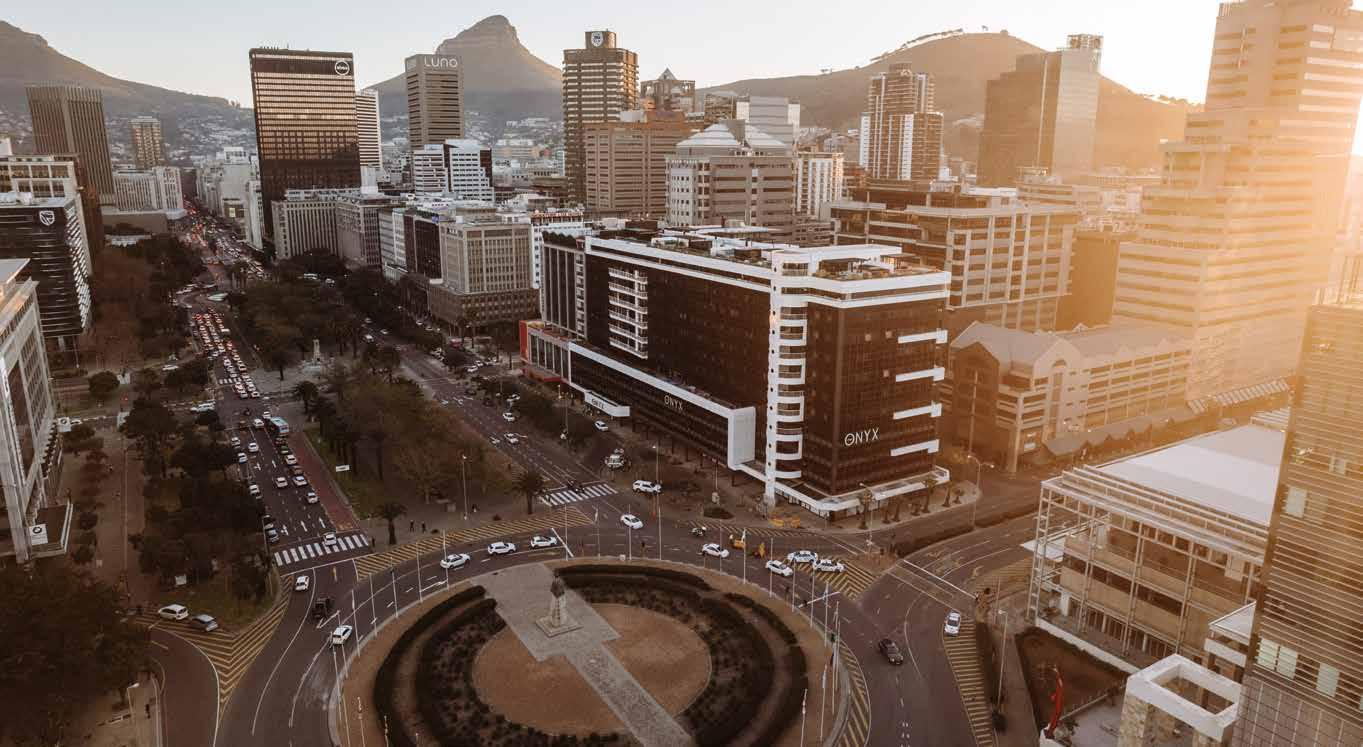
THE ART OF THE SUNDOWNER
Welcome to a local tradition. Here’s where to sip and watch the sunset in style
BY ANDREW THOMPSON
There’s a moment when winter moves into spring and the light shifts – and everything else does, too. In Cape Town, the chill begins to leave the air and temperatures become more moderate. The anticipation for the season ahead becomes palpable.
For decades, patrons at The Winchester Hotel on Sea Point’s iconic Promenade have gathered at Harvey’s Bar, drifting onto the terrace, their glasses beaded with condensation, the gin and tonics inside catching the last light like liquid glass.
It’s a scene so quintessentially South African, it barely needs explanation. The sundowner is not just a drink – it’s a ritual. A marker of time and place, and a toast to the day that was and, for many, the night still to come.
From the terrace, the windswept treetops of Sea Point Promenade are inked into silhouette. Joggers and dog-walkers become shadow puppets in the amber light. You can hear the sea if you pause between sips – and it’s the kind of moment you want to stretch out, just a little longer than the sun allows.
South Africa’s love for the sundowner runs deep. From the bushveld to the beach, it’s an almost sacred pause – a reminder to appreciate the natural beauty that so often forms the backdrop to everyday life here. And Cape Town, unsurprisingly, excels at sundowners – whether from a rocky mountain perch, a beachside bar, or a hidden rooftop in the city.
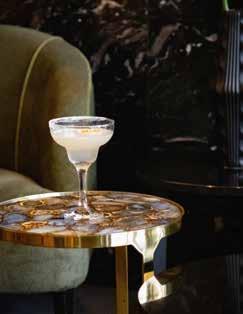

URBAN VIEWS AND MOUNTAIN MOODS AT THE ONYX
Granite Bar at The Onyx Hotel in the Foreshore offers a more metropolitan kind of magic. Its fourth-floor balcony may seem an unlikely sundowner spot, but step outside, and you’ll see why it’s so beloved. From this raised perch, you’re not watching joggers; you’re watching the city shift. The glass towers catch fiery reflections, and Table Mountain glows impossibly still behind it all.
It’s sophisticated, but never stiff. The music hums and the bar staff learn your order by the second night. And the Pineapple and Ginger Martini – a house favourite – walks the perfect line between zesty and smooth. Whether you’re winding down after meetings or gearing up for dinner on Bree Street, it’s a sublime way to reframe the day.

SCAN TO BOOK THE ONYX HOTEL
ROOFTOP GLAMOUR AT THE ROCKEFELLER
A few blocks away, The Rockefeller Hotel’s STUDIO rooftop bar is fast becoming one of Cape Town’s favourite places to watch the light fade. There’s something cinematic about being high above the hum of the city, sipping a perfectly balanced whisky sour as the skyline changes shade. The energy here is electric, even when the mood is mellow.
The Rockefeller doesn’t just cater to business travellers or overnight guests – it draws locals, too. The mix creates a buzz that feels international and inclusive. It’s the kind of place where sundowners slip into supper, then stretch into another round, and a reminder that some sunsets deserve more than one toast.
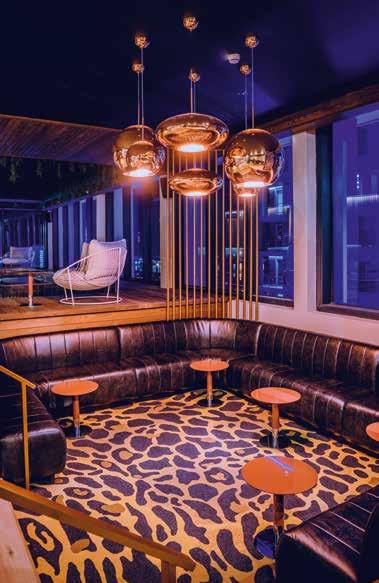

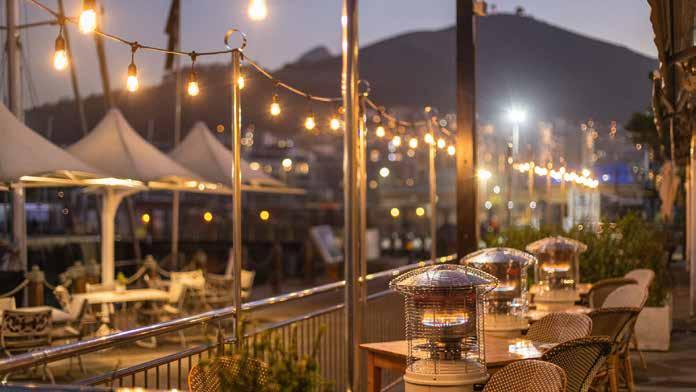
WATERFRONT CALM AND HARBOUR LIGHT AT GINJA
Back at sea level, Ginja at the Victoria & Alfred Hotel offers a very different kind of sundowner. Here, it’s less about altitude and more about atmosphere. Tables spill onto the V&A’s bustling harbourfront, where tugs and superyachts drift past like characters in a play. As the sun slips behind the mountain, the water blushes, and the precinct lights begin to flicker.
This is a sundowner with theatre – the people-watching, the boats, the gentle buzz of the Waterfront. But it’s also a place of quiet satisfaction. The house signature, a tart and lively Porn Star Martini, sets the tone: playful, indulgent, and just bold enough.
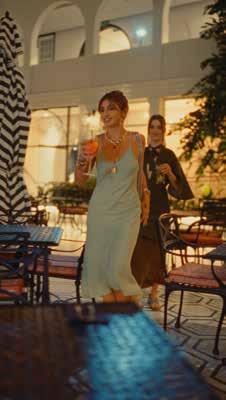
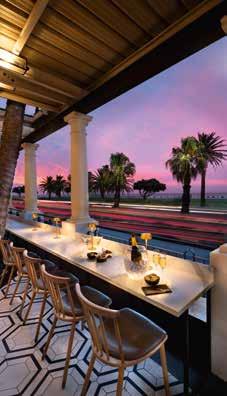
SPRING AND THE EASE OF EARLY EVENINGS
By the time spring arrives, the sundowner hits its sweet spot. The days are getting longer, but they’re not scorching. The sunsets arrive at just the right hour – late enough to justify a drink, early enough to follow with dinner. The air is still crisp, the crowds not yet at capacity, and every rooftop or terrace calls your name.
The best venues know that while it helps, a sundowner is about more than a good drinks list. It’s about setting, timing, and the kind of hospitality that lets you take your time.
Perhaps that’s why the scene at The Winchester lingers. The light shifts, your ice melts quietly into the gin, and conversation slows. For a few minutes, the horizon seems to widen, and you feel – if only slightly – part of something older and larger than yourself.
That’s the quiet magic of the South African sundowner. It anchors you in place, even as the day slips away. And long after your trip ends, it’s a tradition that travels well. It’s a small ceremony you’ll carry with you wherever the sun next finds you, and you can explain with pride to your friends and family that it somehow feels different on the African continent.

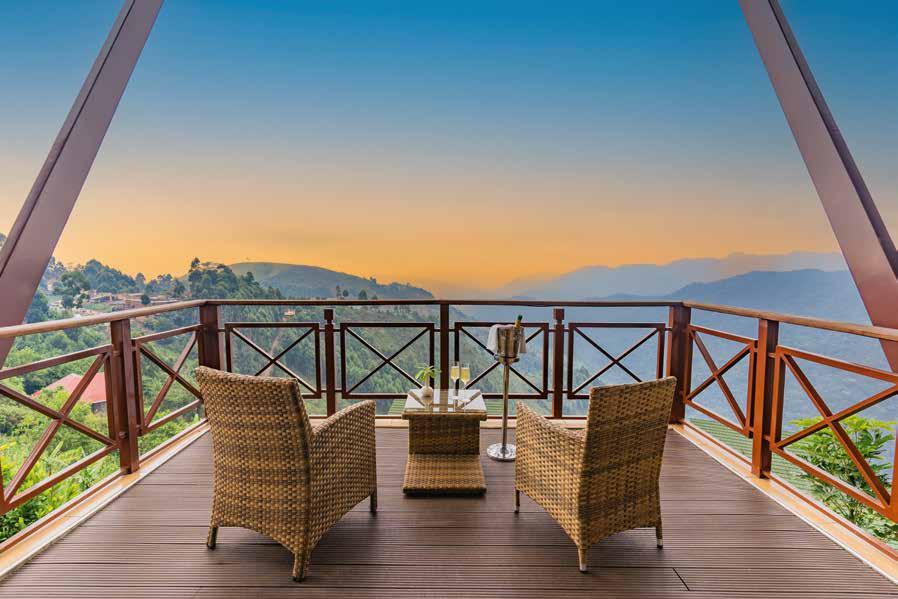
Room with a View
You wake to mist curling through the treetops. Stepping out onto the balcony – barefoot, wrapped in a robe, coffee in hand – you watch as it begins to lift. One ridge at a time, their silhouettes inked in blue, the mountains of Bwindi Impenetrable Forest rise above the blanketed valley. Below, the forest begins to stir. A breeze that never quite arrives rustles the tops of the ferns then slips away again. The Kashasha River murmurs deep in the valley – unseen, but by the soothing sound of the babbling brooks, you know it’s there.
A loerie calls out in the distance – long and fluted, like a reed pipe – just before a blue-headed sunbird flashes past in a blur of iridescent green. The forest is awake now. You breathe in. The rich aroma of freshly brewed coffee mingles with the scent of damp earth and crushed leaves. The steam curls from your cup into the morning air like smoke from a snuffed candle. You take the first sip.
The morning is spent beneath the canopy, down among the trunks, wandering narrow, fern-lined paths. You duck under vines and brush past leaves still beaded with moisture. Sunlight filters through the green, dappling the mossed bark. You can almost taste the air: rich, wet, sharp with green.
A montane butterfly catches flight as you pass. A tinkerbird calls out once, then silence. A bee-eater flits just above eye level before vanishing again. Every flutter, every call draws your eyes skyward. These are the makings of a birdwatching treasure hunt.
Later, you return to Gorilla Heights Lodge, cheeks flushed and hair damp, curling at the ends – the trail still clinging to your skin. Your Deluxe Cottage, bathed in gold, is both refuge and vantage point. Perched at the highest point of the Nkuringo sector, you can see the rainforest stretch in every direction from your balcony. The outdoor tub is waiting, steam rising in soft spirals, vanishing into the canopy. You sink in slowly, letting the heat undo what the day has asked of you. You don’t speak. Not out of reverence exactly, but because it feels enough just to be still. To need nothing more than this moment. Unhurried.
Tomorrow, you’ll return, not for birds, but for an encounter few ever experience – deep into the undergrowth, where you might lock eyes with a gorilla in the hush. But, for now, the day folds in. The sky softens and shadows thicken as the first stars blink through the haze. The forest, once again, begins to hum.
DELUXE COTTAGE AT GORILLA HEIGHTS LODGE




